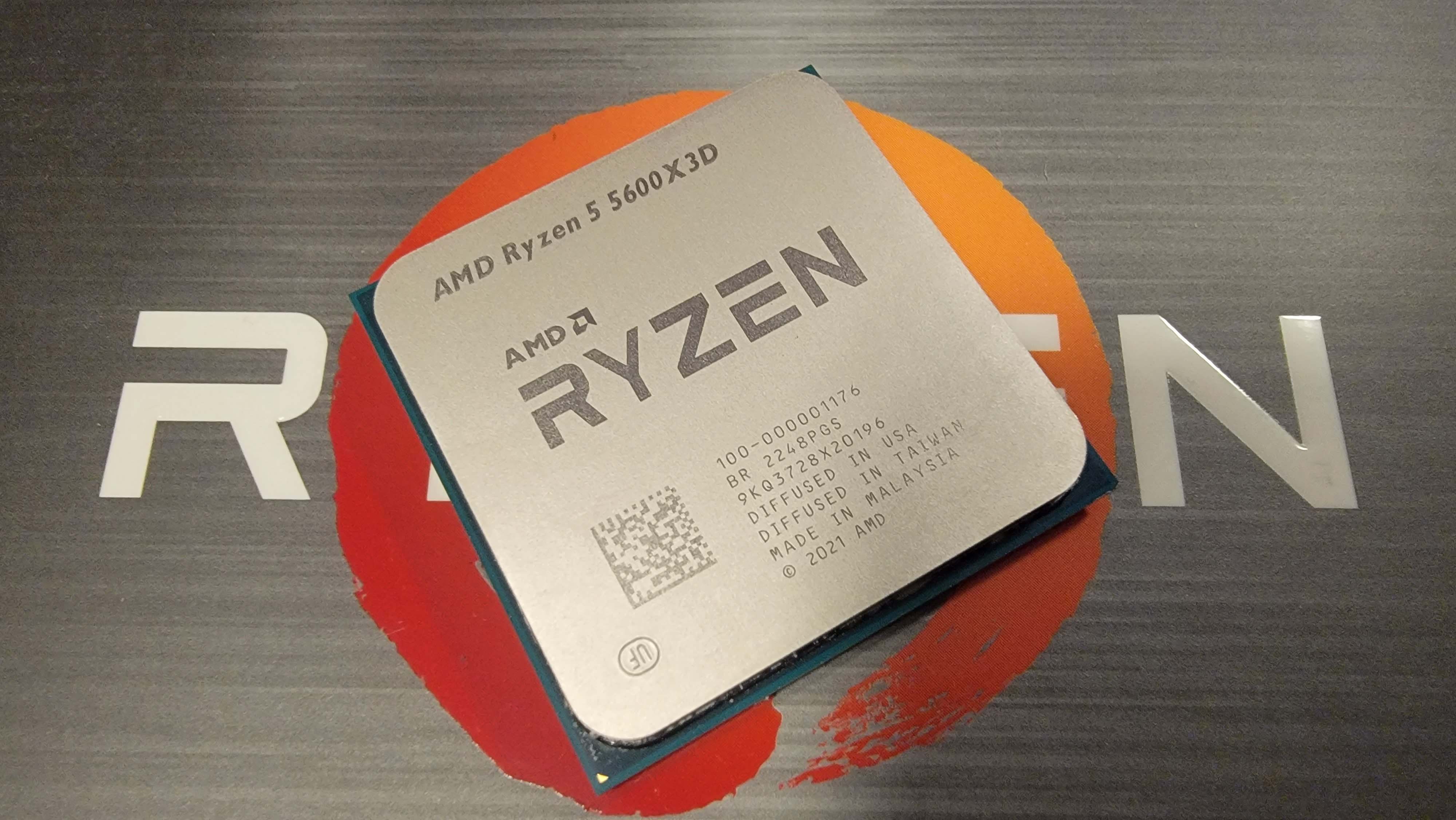
AMD’s limited-edition $229 Ryzen 5 5600X3D comes with all the goodness of the company’s game-boosting 3D V-Cache technology, propelling it to the highest gaming performance in the mid-range price class. Overall, the 5600X3D is ~20% faster in gaming than the Intel Core i5-13400 that currently tops our list of the best CPUs for gaming. However, in a move that defies convention, the Ryzen 5 5600X3D comes to market as a Micro Center exclusive and will only be available while supplies last.
The six-core 12-thread Ryzen 5 5600X3D is a smaller version of the immensely popular eight-core $289 Ryzen 7 5800X3D that remains a top pick for gamers. However, the 5600X3D delivers 95% of the 5800X3D’s gaming performance for 20% less cash. As you can see in our CPU benchmarks hierarchy, at stock settings, the 5600X3D is also faster in gaming than the entire standard Ryzen 7000 lineup — including the $599 Ryzen 9 7950X. That’s because even though the Ryzen 5 5600X3D comes with two fewer cores and slightly lower clock speeds than its pricier 5800X3D counterpart, it still wields the same 96MB of game-boosting L3 cache.
The Ryzen 5 5600X3D rounds out AMD’s portfolio of gaming-specific X3D processors, which now spans from $229 up to $669. The chip excels at gaming, but all the usual caveats of 3D V-Cache technology apply — this tech results in lower clock speeds that ultimately reduce performance in some productivity apps, and the tech doesn’t accelerate all games.
The 5600X3D is a new entry in the older Ryzen 5000 series, so it comes with the Zen 3 architecture, 7nm process node, and drops into last-gen AM4 motherboards. In contrast, AMD's newest Ryzen 7000 chips come with the faster Zen 4 architecture etched on the 5nm process and drop into newer AM5 motherboards. However, those chips carry a premium and require more expensive DDR5 memory, while the 5600X3D supports more economical DDR4, giving it an easy win in terms of total system cost.
Micro Center will also sell a $329 bundle with the Ryzen 5 56003XD, an ASUS B550-Plus TUF motherboard, and 16GB of G.Skill Ripjaws V DDR4 memory, a nearly unbeatable value. The retailer will also offer a pre-built $849 PowerSpec G516 system with a Radeon 6650XT, 16GB of memory, and a 500GB NVMe SSD.
Micro Center will only sell the Ryzen 5 5600X3D processors in its stores while supply lasts, beginning July 7. AMD and Micro Center haven’t confirmed the number of processors that will be available, but the retailer expects to have stock for a few months. Micro Center currently has 25 outlets in 18 states, so the chip will be US-only. Let’s dive into the details.
The Ryzen 5 5600X3D Backstory
The full story of the Ryzen 5 5600X3D will likely remain shrouded in secrecy for some time, but we’ve pieced together information from multiple sources. AMD hasn’t provided an official comment, but sources close to the matter tell us these chips were “purpose-built” to be launched as Ryzen 5 5600X3D parts. As such, they aren’t made of defective Ryzen 7 5800X3D processors.
Typically, we would expect the 5600X3D chips to be constructed from eight-core Ryzen 7 5800X3D processors that suffered defects in manufacturing and were then harvested as six-core models. However, the 3D V-Cache manufacturing process is more expensive than AMD’s standard packaging technique, so AMD only earmarks its fully validated silicon (Known Good Die – KGD) for the expensive 3D chip-stacking treatment. For Ryzen 7 5800X3D models, that means a fully working eight-core KGD.
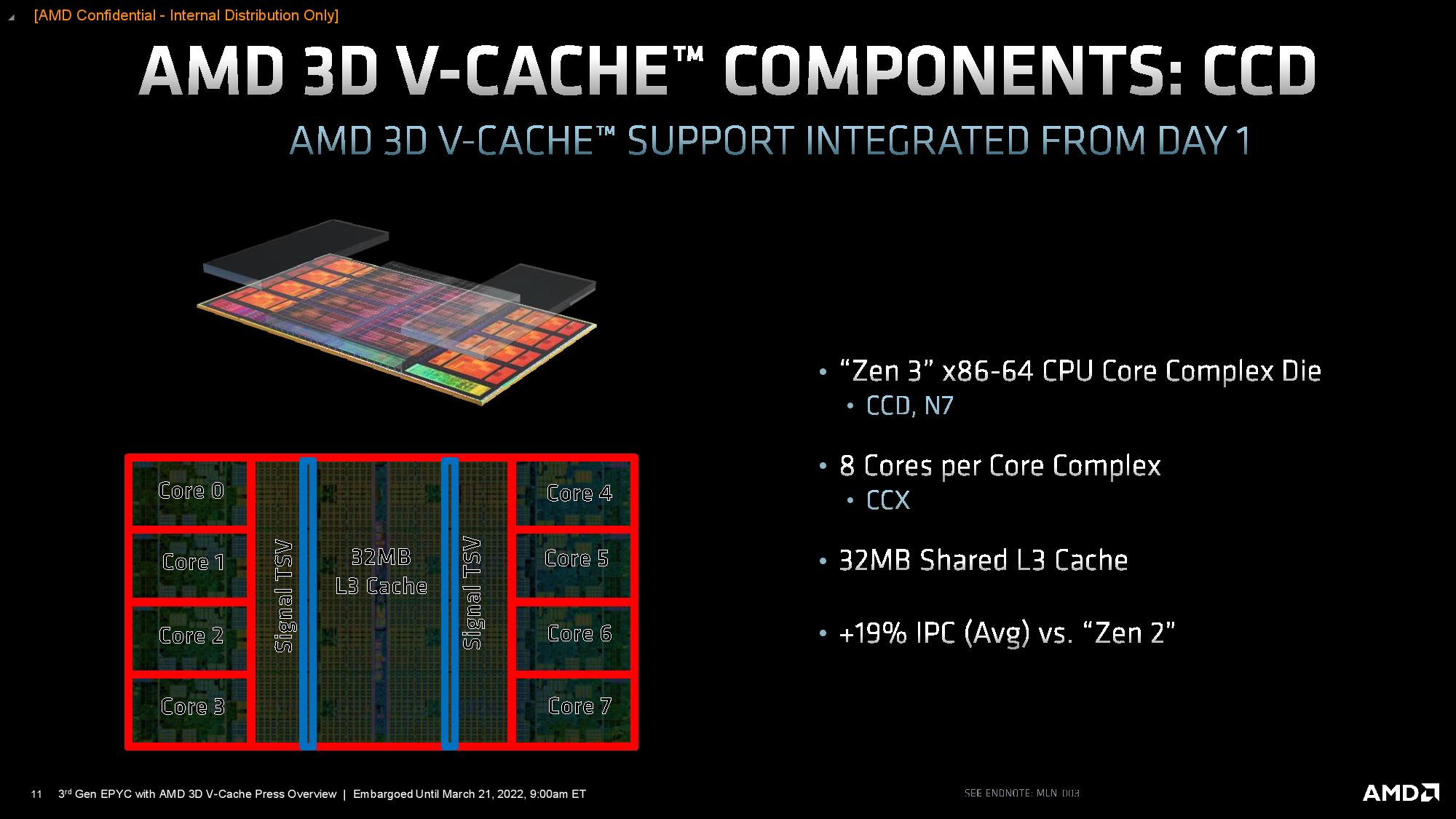
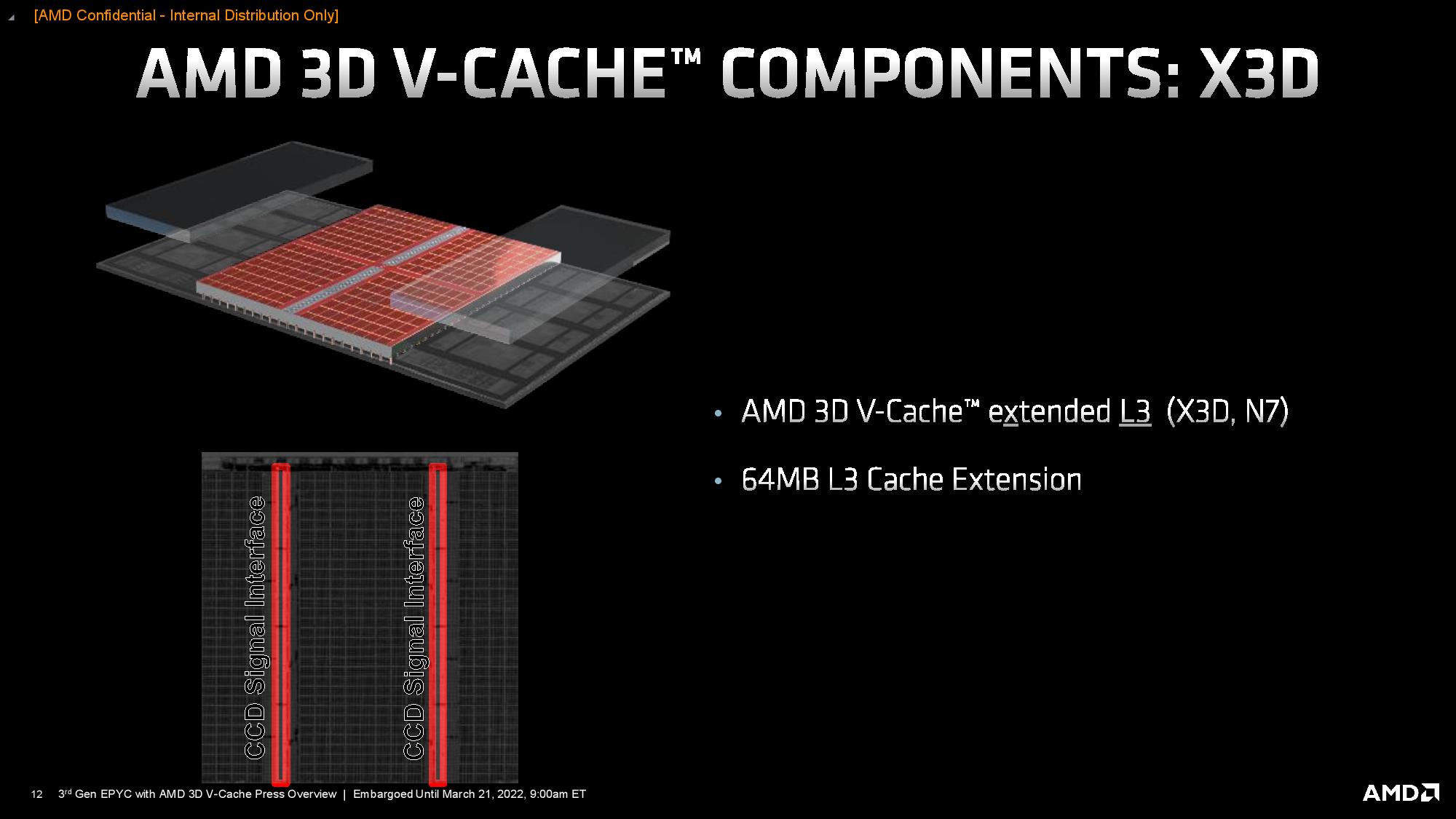
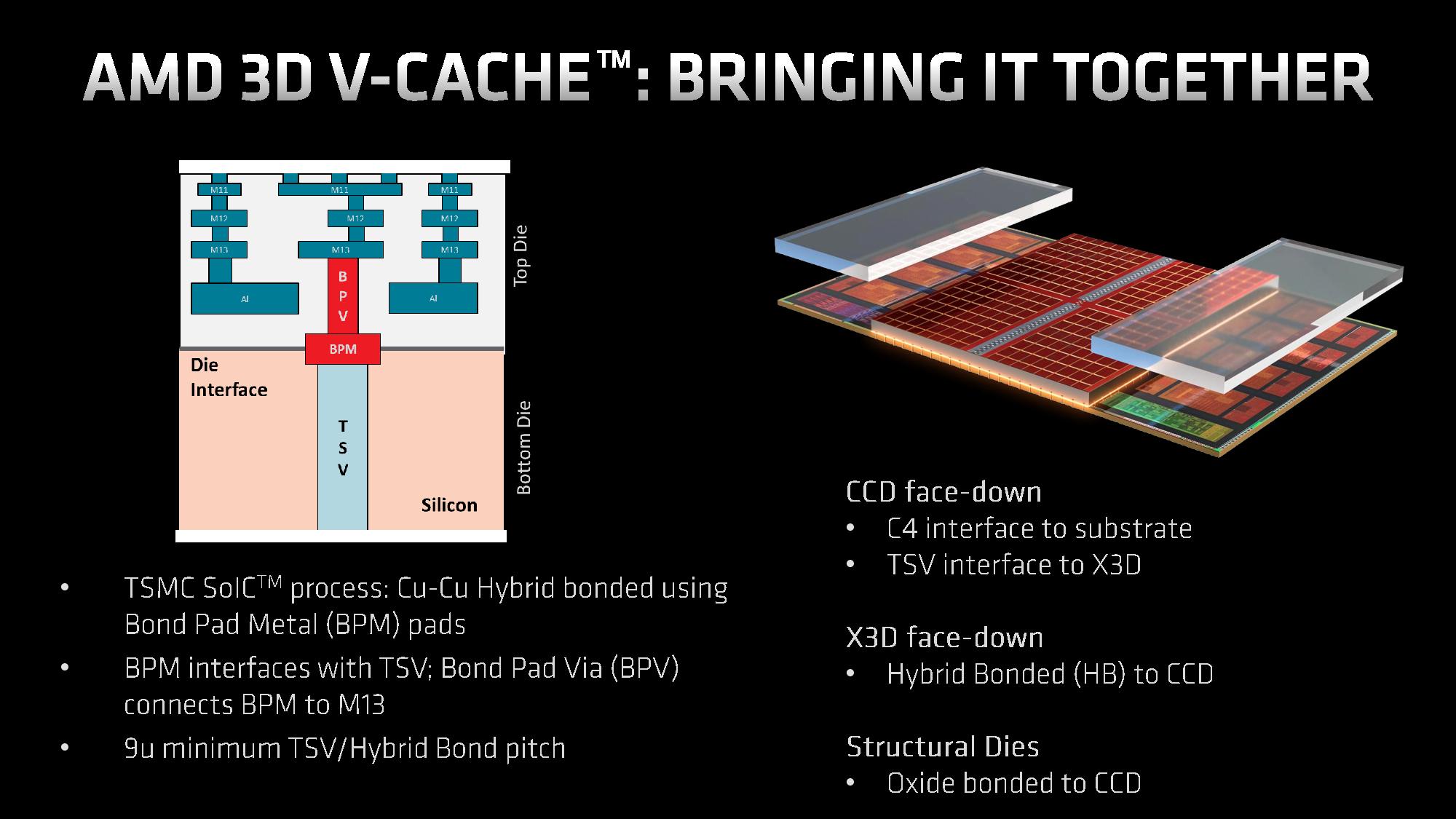
AMD sends these KGD to a separate hybrid bonding stage that employs TSMC’s SoIC packaging process to link the base die to the 3D-stacked L3 chiplet. This connection occurs through two rows of TSVs (Through Silicon Vias) embedded in the cache portion of the underlying die, not the cores, and the stacked chiplet does not overlap the core area (deep dive into the process here). In addition to a slew of advantages that we cover in the linked material, this approach also minimizes or eliminates the chances of core-specific damage during bonding.
We’re told that AMD purposefully created the 5600X3D chips by either mounting a cache chiplet atop a standard down-binned six-core KGD die (like the one found in a 5600X), or intentionally disabling cores on some fully-working 5800X3D models. We're told that a misunderstanding of the description of the former process, which does use a down-binned standard die, probably resulted in erroneous reports that the 5600X3D are merely down-binned 5800X3D processors due to defects in the cores. (You can read more about the Second-Gen 3D V-Cache packaging tech used in the newer Ryzen 7000X3D models here.)
According to the batch number, our sample was built in week 48 (Nov/Dec) of 2022, but the design was copyrighted in 2021. Motherboard vendors tell us that the Ryzen 5 5600X3D was enabled in the same AGESA revision (underlying BIOS code) that enabled the Ryzen 7 5800X3D when it launched back in April 2022. Therefore, any AM4 motherboard with an AGESA 1.2.0.6b (or newer) BIOS will work with the 5600X3D. Motherboard vendors haven't tuned specifically for the 5600X3D because it was effectively a canceled processor. Instead, it only has a basic level of enablement.
During its exploration process into the new X3D tech, AMD game-planned and tested several Ryzen 5000X3D models, including the prototype Ryzen 9 5900X3D that Lisa Su teased at Computex 2021. However, like the 5900X3D, we’re told that the Ryzen 5 5600X3D ultimately wasn’t launched due to unspecified “business factors.” Considering the 5600X3D's exceptional performance-per-dollar ratio, it’s logical to think the 5600X3D threatened to severely cannibalize AMD’s Ryzen 7 5800X3D sales, not to mention sales of the then-forthcoming AM5 platform. Why buy the flagship gaming models when a less-expensive variant offers the lion’s share of the performance for less cash?
AMD has said repeatedly that the AM4 platform will serve as a value platform for the near future, but the 5600X3D chips are only available for a limited time, and AMD will not produce more. Combined with the fact that AMD now has newer-generation Ryzen 7000X3D chips, perhaps cannibalization isn’t as much of a concern. Pricing has also dropped quite a bit on the 5800X3D since it launched, and while $60 still separates the new 5600X3D from its sibling, in terms of total system cost, that's not a huge hurdle — if you don't pick up a 5600X3D in the next few months and they sell out, you can still opt for the slightly more expensive chip with two extra cores.
Both Intel and AMD have offered limited edition chips in the past, but it is unprecedented in recent memory to give a single retailer the full allotment of supply. The 5600X3D is available in the US only, but both Intel and AMD have also offered other region-specific chips in the past, particularly for the China market.
AMD Ryzen 5 5600X3D Pricing and Specifications
Intel’s Core i5-13400/F has dominated the ~$200 price point for new system builders, and AMD’s new Zen 4 offerings struggle to compete due to the premiums for DDR5 and AM5 motherboards. If gaming is all you care about, the Ryzen 5 5600X3D addresses that shortcoming with cheap and plentiful AM4 motherboards paired with inexpensive DDR4 memory.
The Ryzen 5 5600X3D operates at a 3.3 GHz base and 4.4 GHz boost clock and is built on the same underlying die configuration as the Ryzen 5 5600X/5600. As we’ve seen with AMD’s other X3D processors, the company has dialed back the peak frequency by a few hundred MHz compared to the X-equivalent (5600X), but the 5600X3D’s peak frequency is the same as the Ryzen 5 5600. The reduced frequencies are designed to keep voltages, and thus thermals, in check (the 3D-stacked chiplet traps some heat). Surprisingly, the Ryzen 5 5600X3D has a 105W TDP rating, 40W higher than its similar counterparts.
The 5600X3D supports DDR4-3200 memory and PCIe 4.0. It comes with nearly all the standard features of other Ryzen 5000 processors, except it doesn’t support direct CPU overclocking or the auto-overclocking Precision Boost Overdrive. As a slight consolation, the 5600X3D does support memory overclocking, though we found in our testing that memory overclocking has a very small impact. Some motherboard makers do have unofficial workarounds to enable various levels of overclocking for the Ryzen 7 5800X3D, and the same unofficial (and warranty-voiding) options will also be available for the 5600X3D.
As with all of AMD’s other X3D models, the Ryzen 5 5600X3D doesn’t have an iGPU or bundled cooler. We haven’t been told of any specific cooler recommendations, but given the TDP rating, it likely requires a 240mm liquid cooler (or air equivalent) like the 105W Ryzen 7 5800X3D.
Now, on to the benchmarks.
AMD Ryzen 5 5600X3D Gaming Benchmarks — The TLDR
Here we have the geometric mean of our gaming tests at 1080p and 1440p, with each resolution split into its own chart. We're testing with an Nvidia GeForce RTX 4090 to reduce GPU-imposed bottlenecks as much as possible, and differences between test subjects will shrink with lesser cards or higher resolutions and fidelity. You'll find further game-by-game breakdowns below. We have the particulars of the test setups on page four.
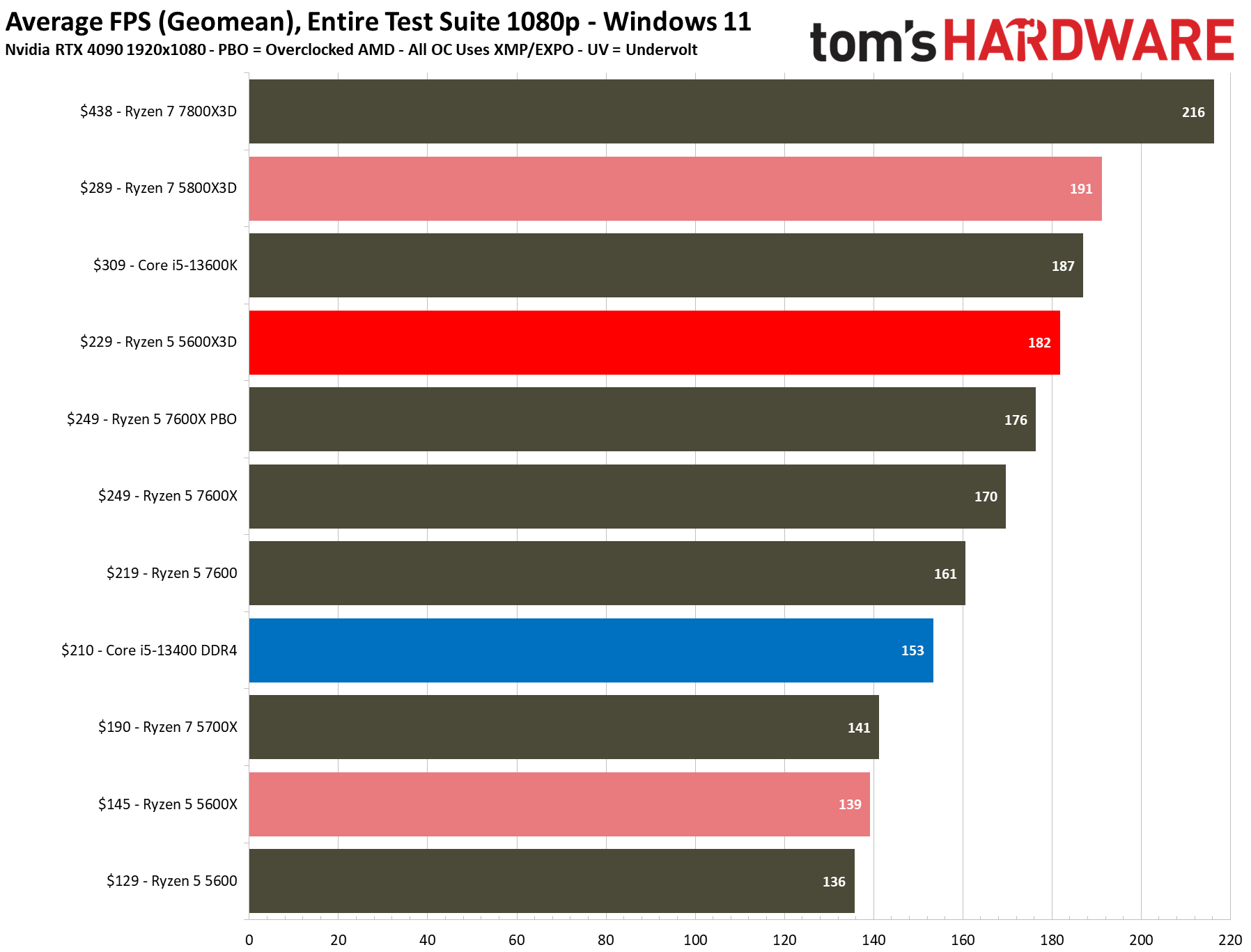
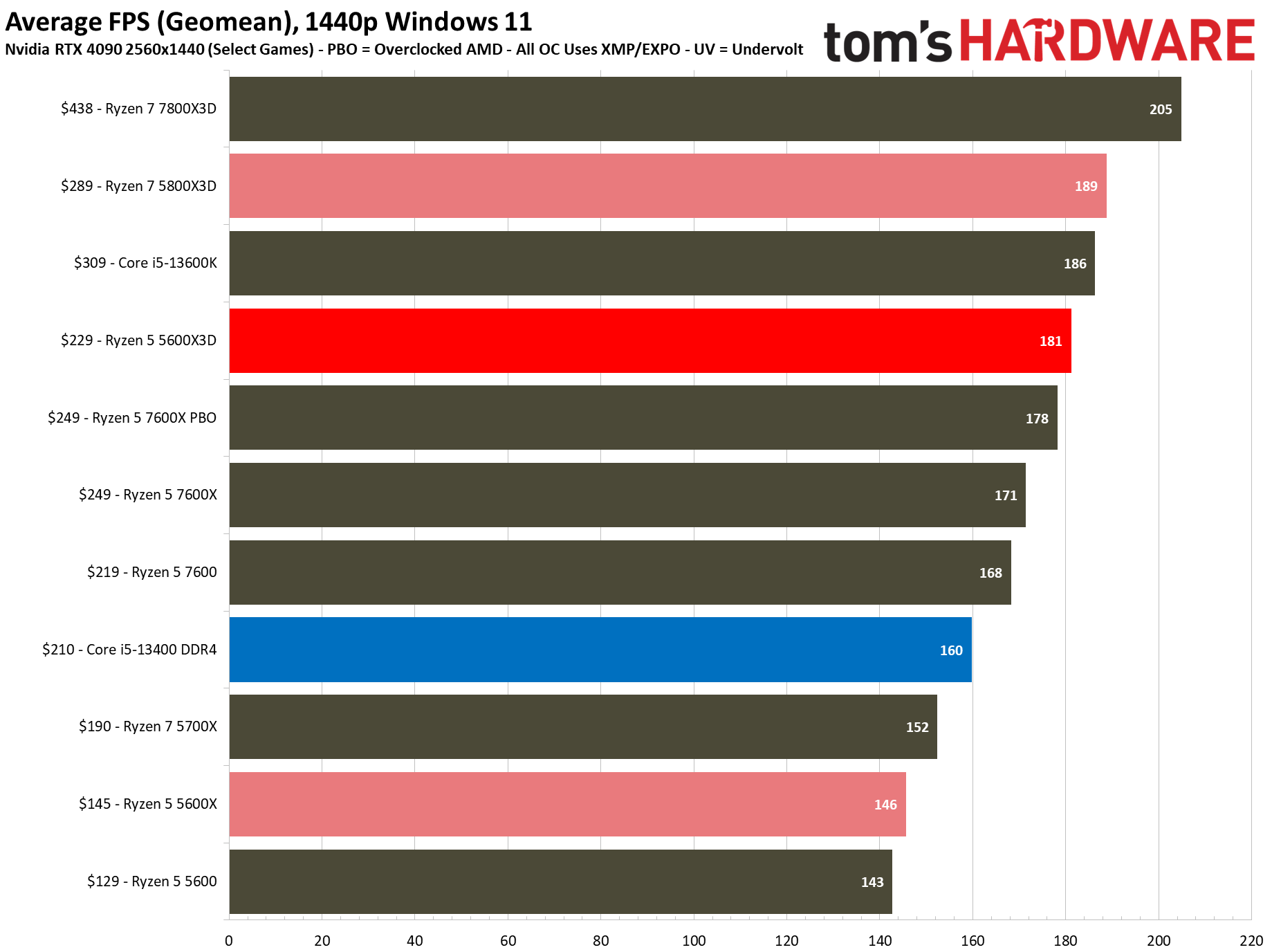
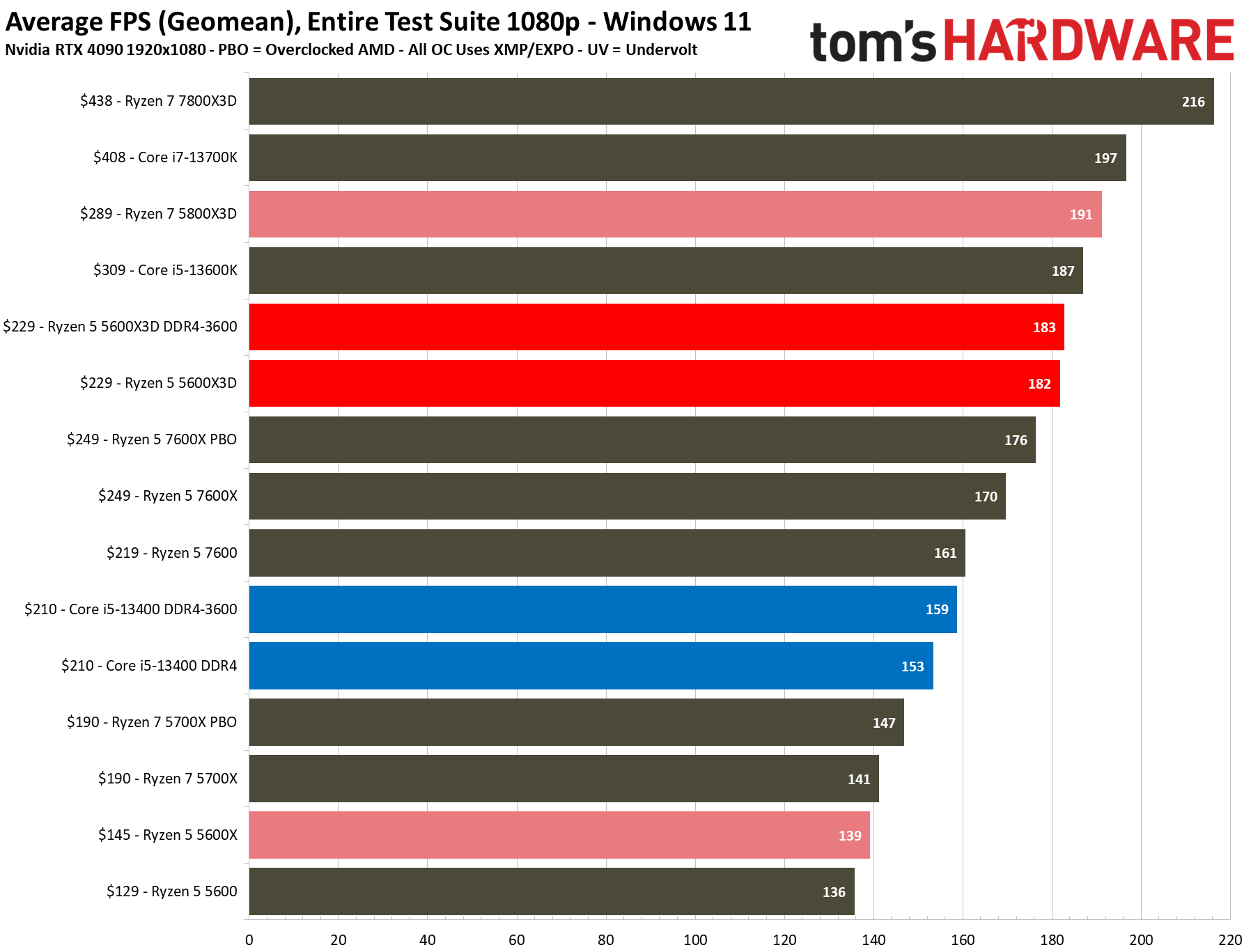
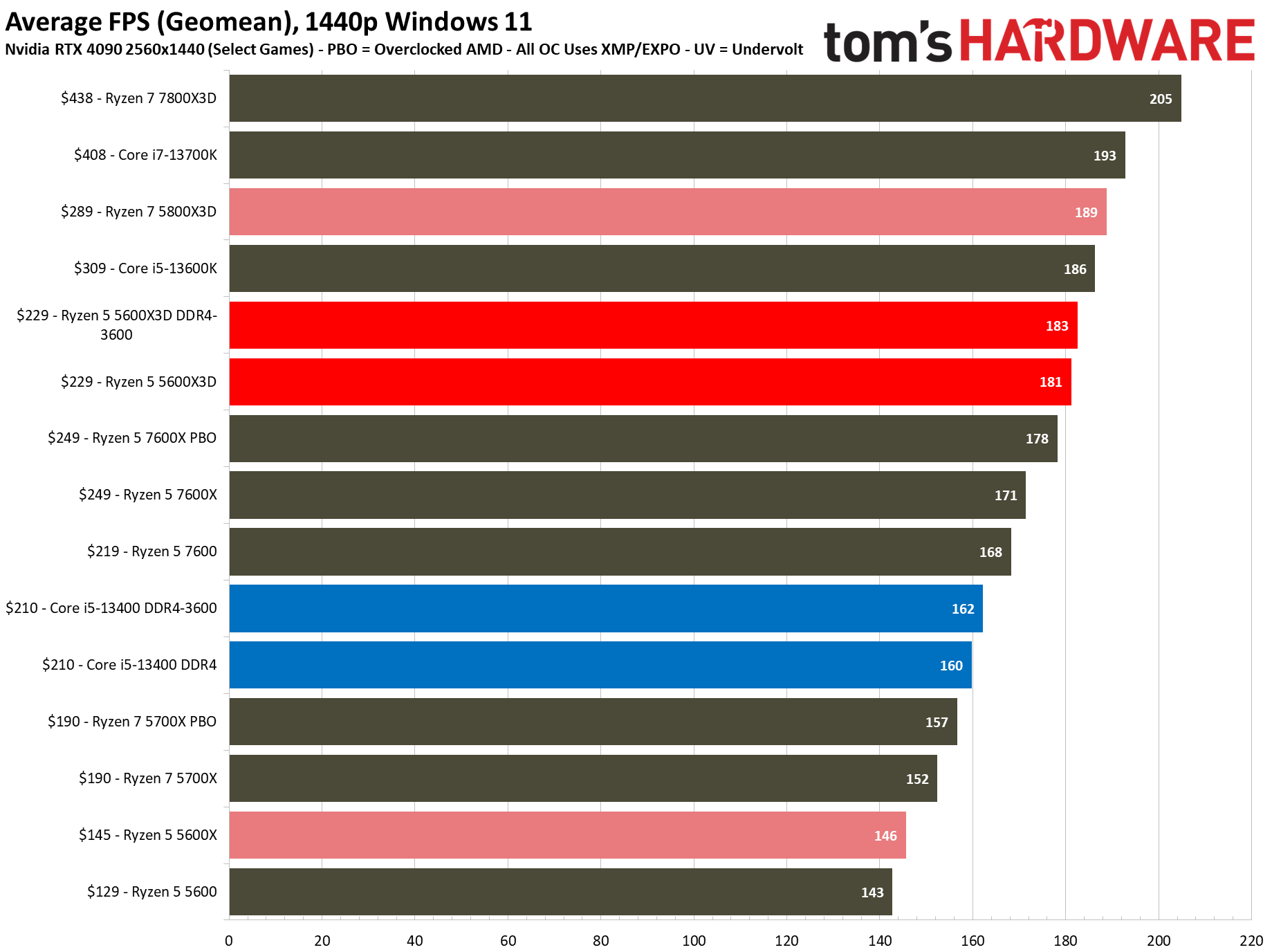
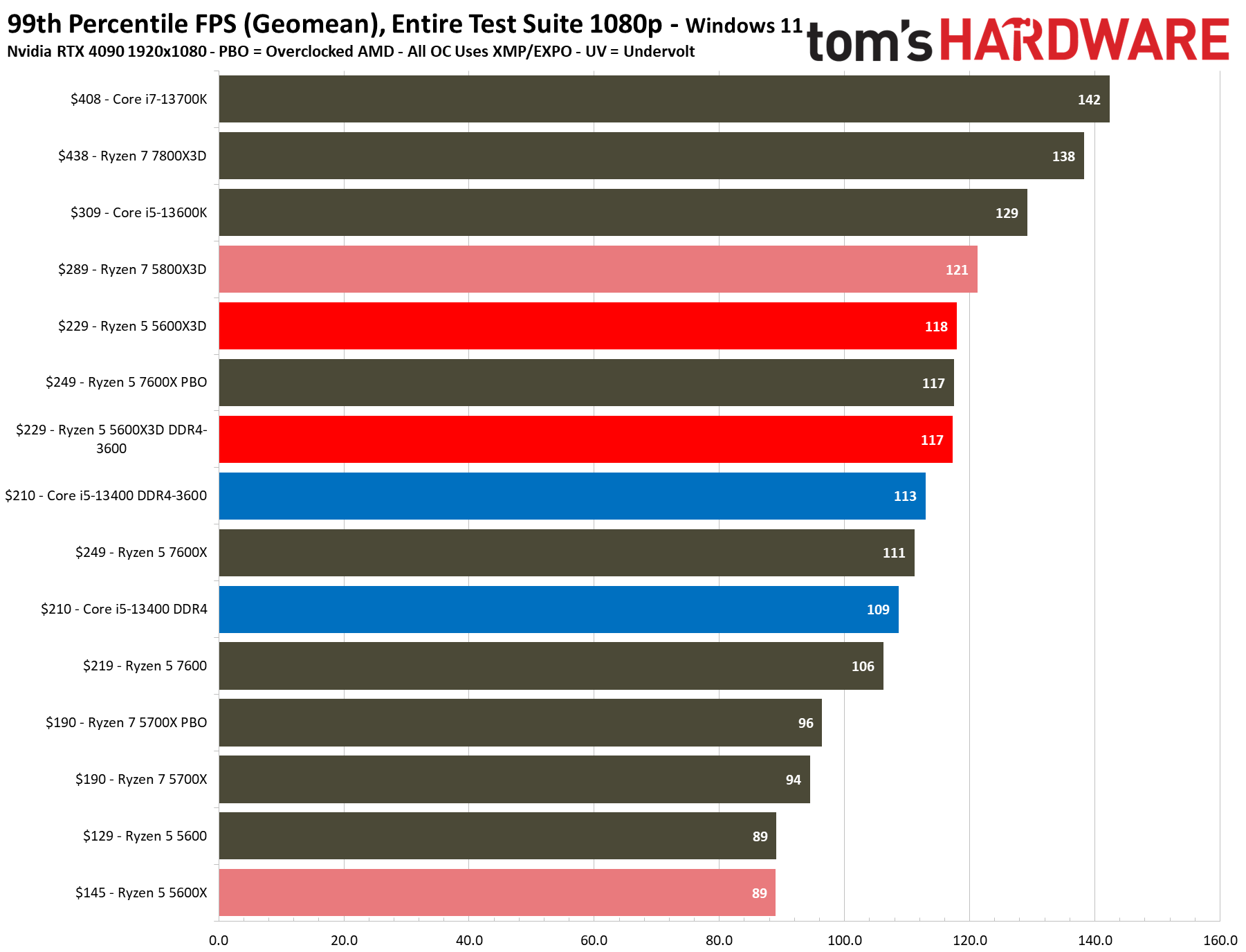
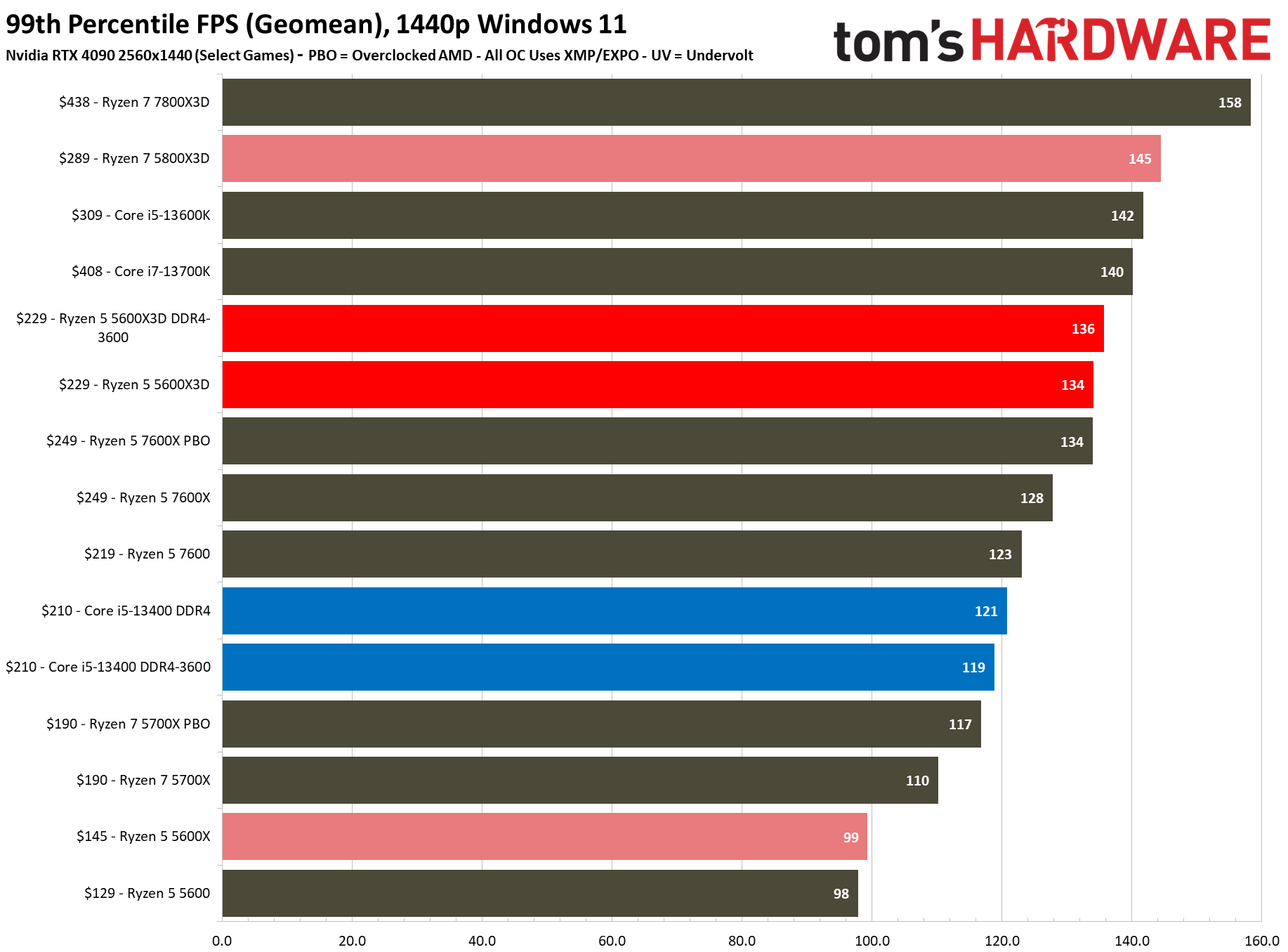
The first two slides are simplified without the overclocking configs, while the remainder of the slides in the album covers the full roster of tested configurations.
The $210 Intel Core i5-13400 is a popular chip due to its impressive gaming-per-dollar metrics and support for DDR4 memory, and while it does cost $20 less than the 5600X3D, it can’t keep up in either gaming performance or value. In our cumulative measurement of our 1080p game suite, the Ryzen 5 5600X3D is 19% faster than the Core i5-13400.
As we’ll detail a bit further below, the 56000X3D holds a sizeable advantage in fps-per-dollar metrics, too. You could arm the 13400 with overclocked DDR5 to gain slightly faster gaming performance, but that isn’t worth the hefty upcharge in this price class. However, remember that you'll also need an aftermarket heatsink with AMD's X3D chips as well as Intel's K-series parts like the 13600K.
You’ll have to step up to the Core i5-13600K to find an Intel chip with faster gaming performance than the 5600X3D. The 13600K is 5% faster than the 5600X3D, but you’ll pay 35% more for the privilege — not to mention the big increase in power consumption.
As you can see, the $289 Ryzen 7 5800X3D is a mere 5% faster than the $229 Ryzen 5 5600X3D in 1080p gaming, but costs 26% more.
The 5600X3D comes with the previous-gen Zen 3 architecture, but it's no slouch in gaming against Zen 4 comparables; the 5600X3D is 7% faster than the Zen 4-powered $249 Ryzen 5 7600X, but costs $10 less. The 5600X3D also drops into more affordable AM4 socket motherboards that support relatively inexpensive DDR4 memory, while the 7600X requires an AM5 motherboard and pricier DDR5 memory.
If you step up to a Zen 4 X3D chip, the Ryzen 7 7800X3D currently represents the least expensive model at $438, and it also happens to be the fastest Zen 4 chip for gaming. The 7800X3D is 19% faster than the 5600X3D but resides in an entirely different price class.
The Ryzen 5 7600X3D doesn’t support direct voltage or frequency overclocking, and unlike the Ryzen 7000X3D models, the auto-overclocking Precision Boost Overdrive (PBO) feature is also off-limits. The chip does support memory overclocking, but as we’ve seen with all other X3D chips, memory overclocking generates almost no return — in this case, we gained 0.55% at 1080p. On the plus side, you can buy an inexpensive memory kit and unlock the chip's full potential. In contrast, the Core i5-13400 gains 4% from overclocking the memory.
The Ryzen 5 5600X3D removes Intel’s pricing advantage for DDR4-equipped Core i5-13400 systems, but, alas, only for a limited time. Micro Center’s 5600X3D bundle is an exceptional deal that slightly undercuts the overall pricing for the DDR4-equipped Core i5-13400 configuration, but it offers significantly more performance than the Intel setup, thus yielding better cost-per-fps metrics.
The Micro Center bundle deal is obviously solid with an included B550 motherboard — it would be difficult to cobble together your own system separately at the same price point. This kit is a no-brainer if you’re buying a Ryzen 5 5600X3D for a new system.
The AMD vs Intel contest can vary in different game titles, with some clearly favoring one architecture over another. The 3D V-Cache tech also doesn't accelerate all games. As such, you should peruse the individual game benchmark results below for a closer look at the test results. Also, while the Ryzen 5 5600X3D provides explosive gaming performance, it isn’t nearly as adept in productivity workloads as shown on the following page.
Cyberpunk 2077 Benchmarks on AMD Ryzen 5 5600X3D
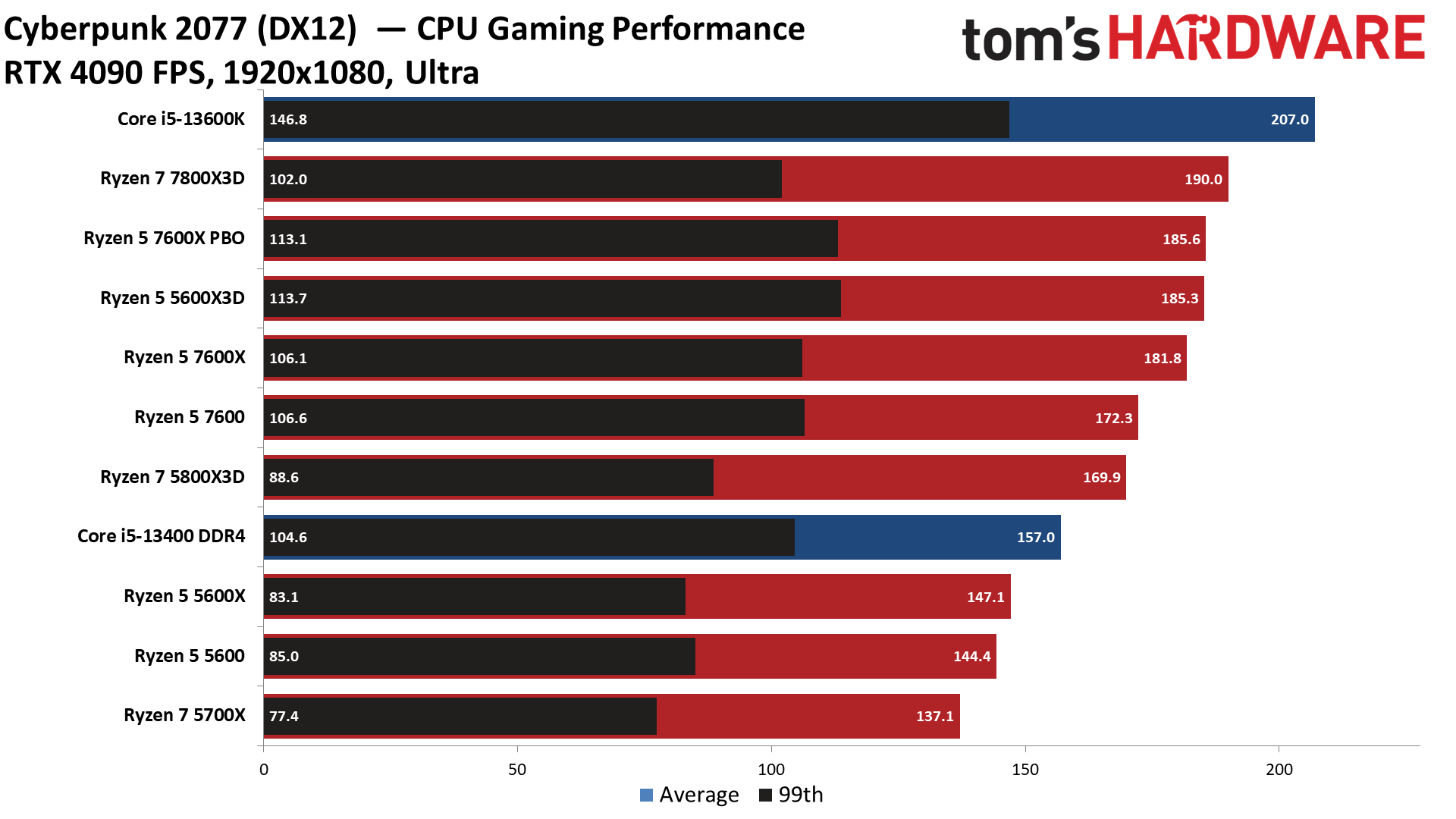
Cyberpunk currently has an issue with AMD processors — if you disable SMT (threading), you will actually gain performance. We can see indirect signs of this condition in the above results. For instance, the eight-core Ryzen 7 5800X3D is slower than the six-core Ryzen 5 5600X3D, and the eight-core Ryzen 7 5700X is slower than the six-core Ryzen 5 5600X and 5600. We’re unsure when or if this will be corrected, but recent news coverage of the issue may spur a fix sooner rather than later. We’ll continue retesting as newer patches come out.
Far Cry 6 Benchmarks on AMD Ryzen 5 5600X3D
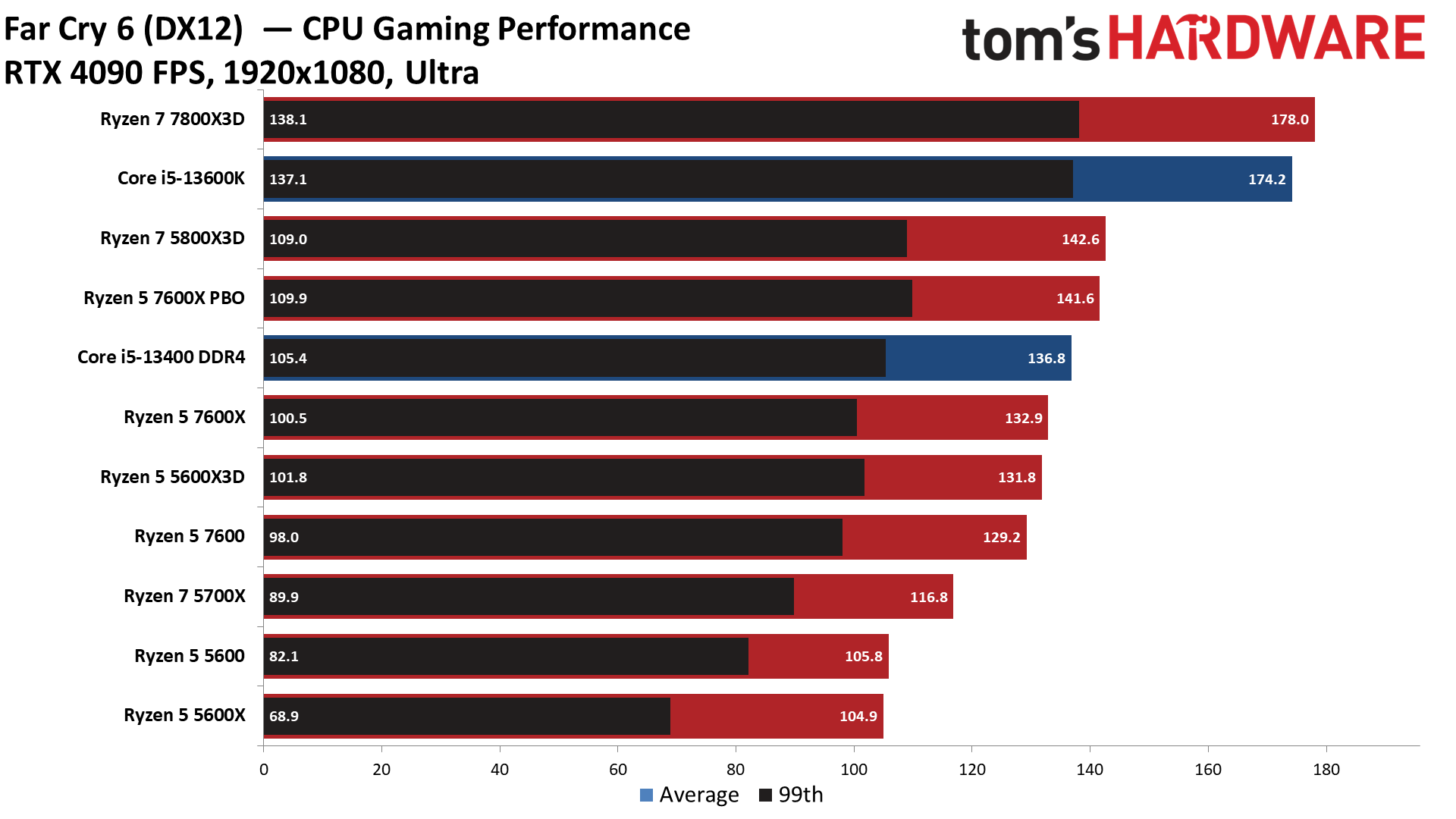
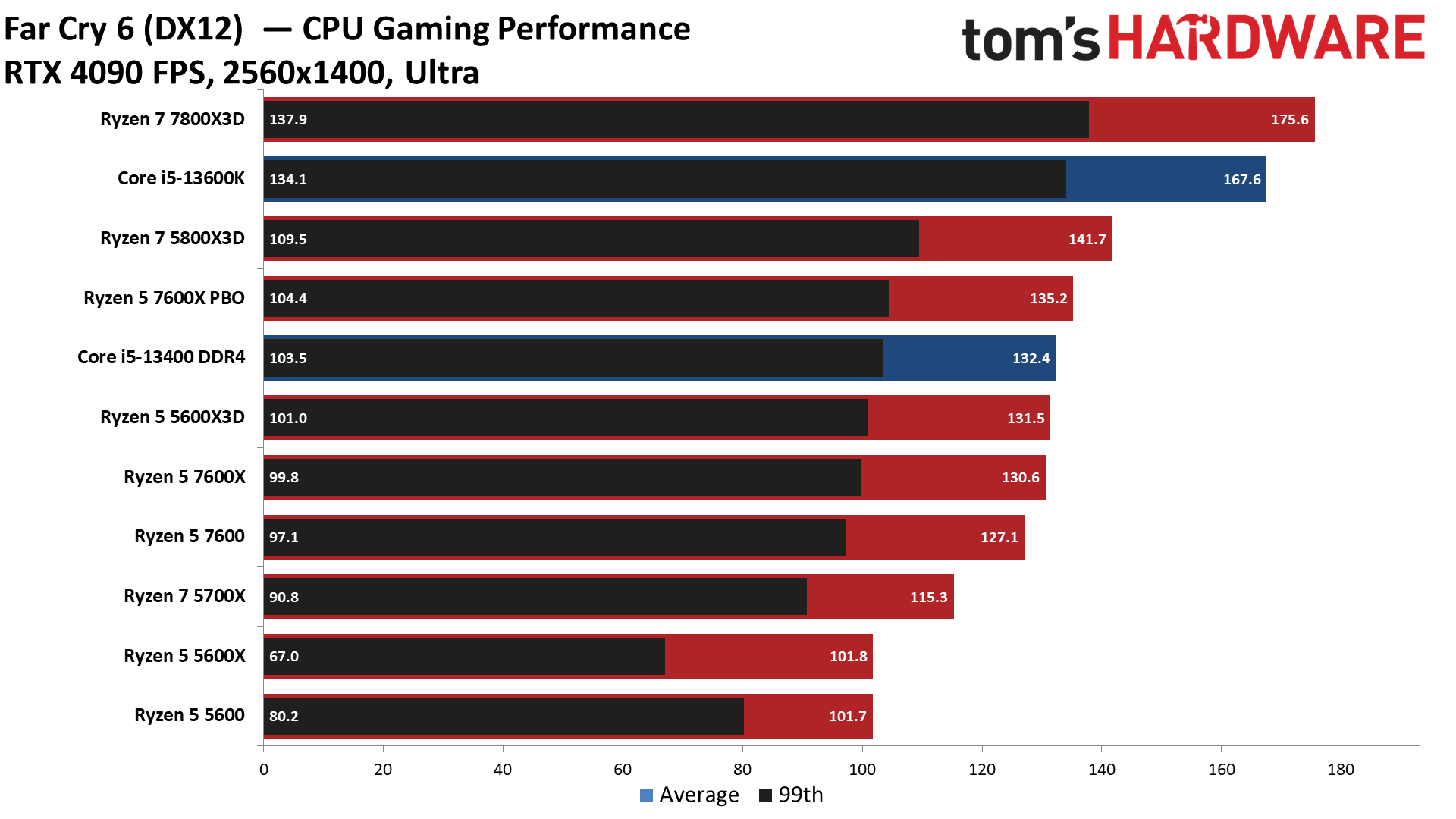
The Ryzen 5 5600X3D essentially ties the Ryzen 5 7600X and edges past the 7600, but the Core i5-13400 is four percent faster at 1080p. Notably, the 5600X3D and 13400 nearly tie at 1440p. Meanwhile, the 5800X3D is eight percent faster than the 5600X3D, reminding us that it is the next step up the Ryzen gaming totem pole.
F1 2021 Benchmarks on AMD Ryzen 5 5600X3D
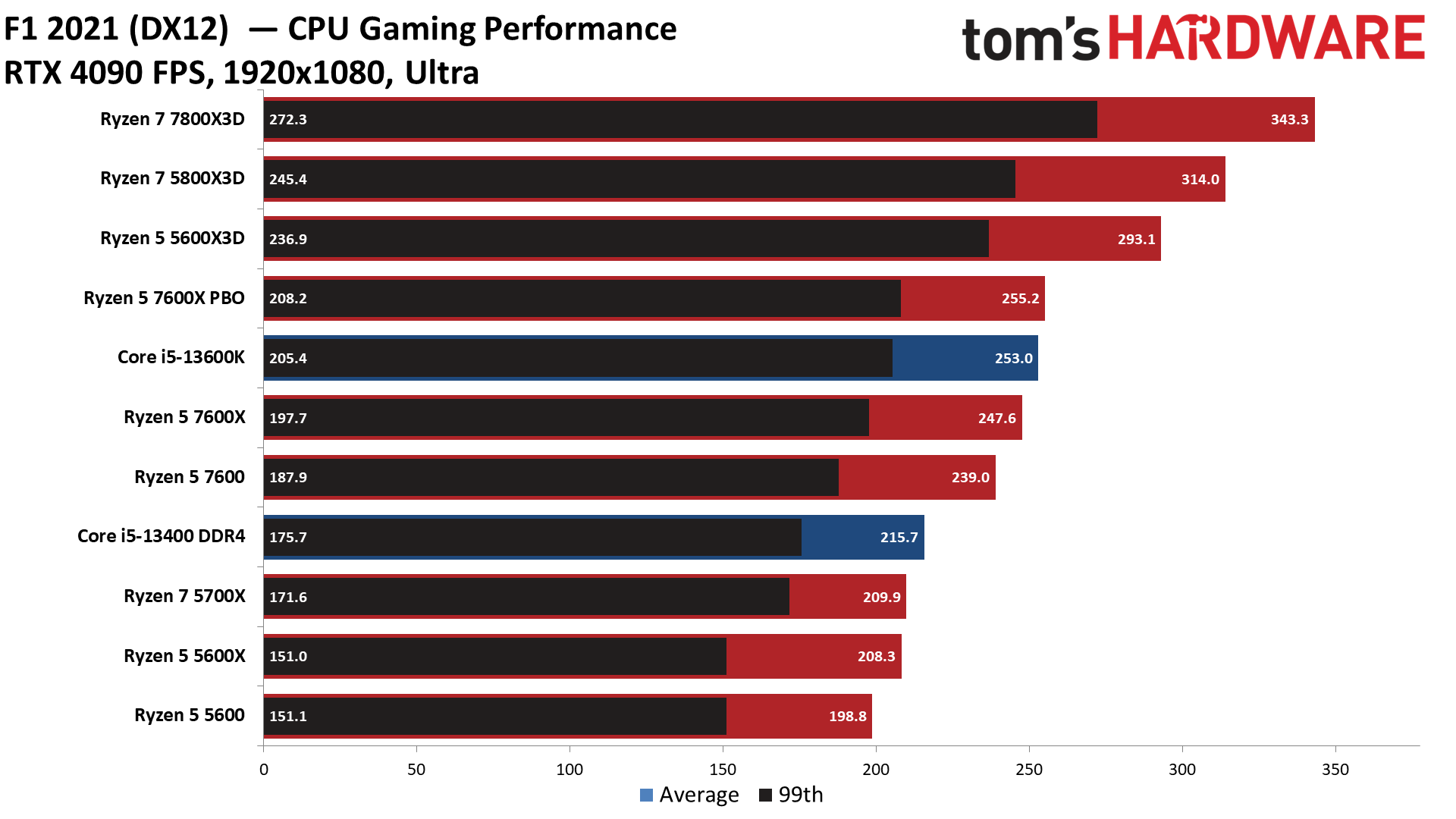
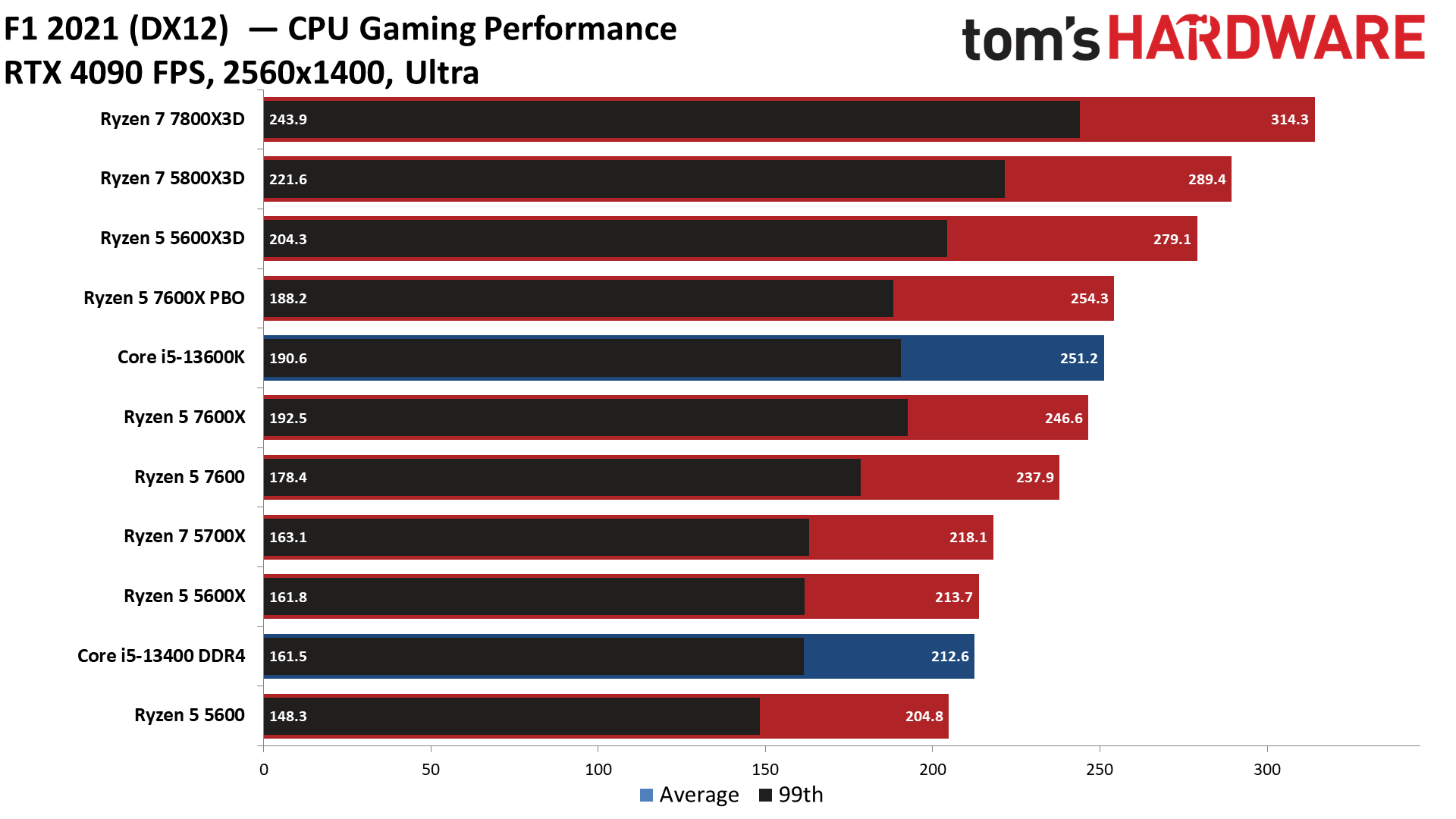
F1 2021 simply loves 3D V-Cache. The three X3D models top the chart at both 1080p and 1440p resolutions, taking a sizeable lead over all other competitors. At 1080p, the Ryzen 5 5600X3D is 17% faster than the Core i5-13600K and 41% faster than the Core i5-13400.
Hitman 3 Benchmarks on AMD Ryzen 5 5600X3D
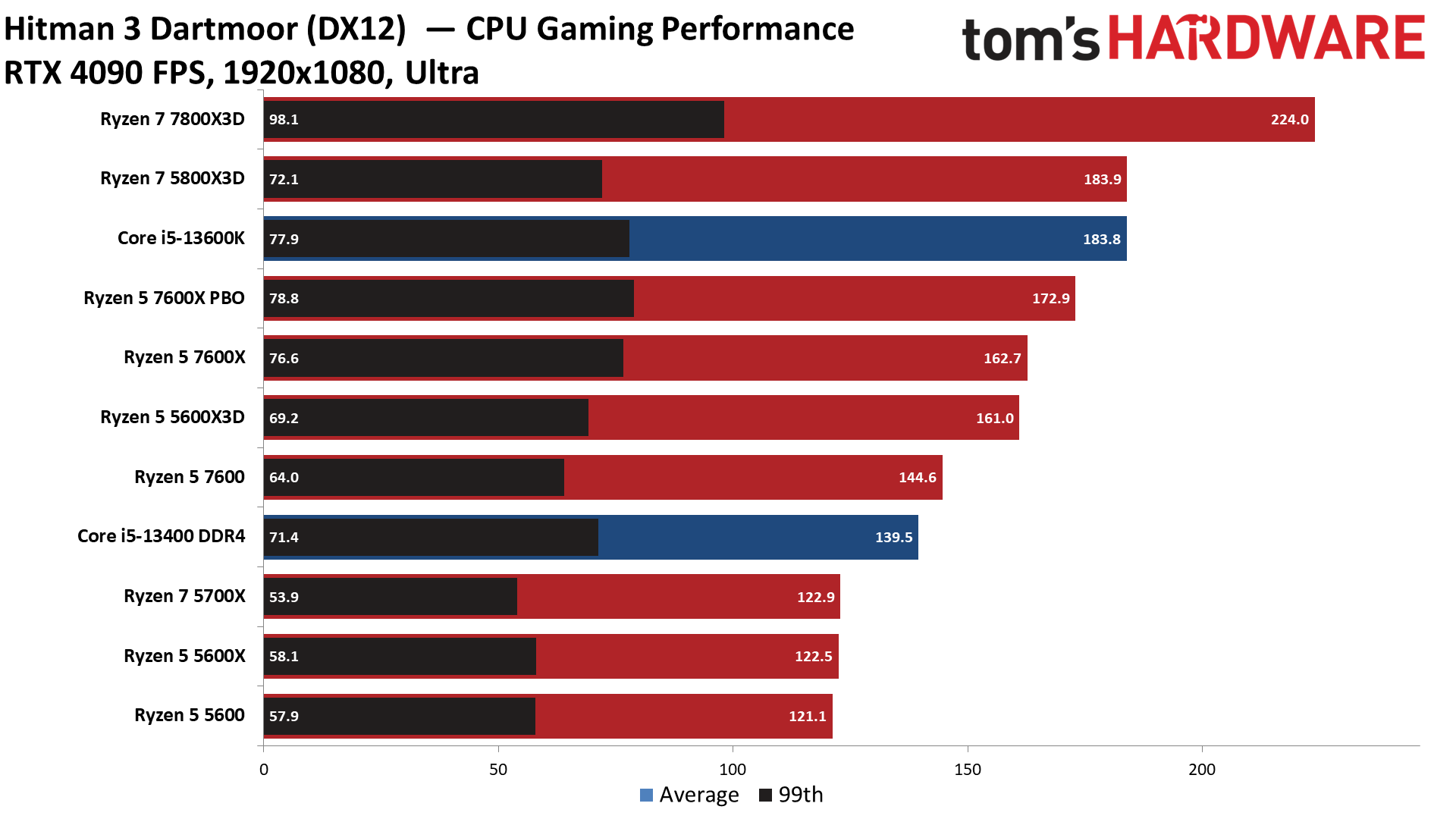
Hitman typically scales well with increased core counts, but 3D V-Cache is obviously the silver bullet for the 5800X3D and 7800X3D. However, the 5600X3D is limited by its six cores in this very core-limited title, so it falls in line with the six-core 7600X while still being 15% faster than the Core i5-13400.
Microsoft Flight Simulator 2021 Benchmarks on AMD Ryzen 5 5600X3D
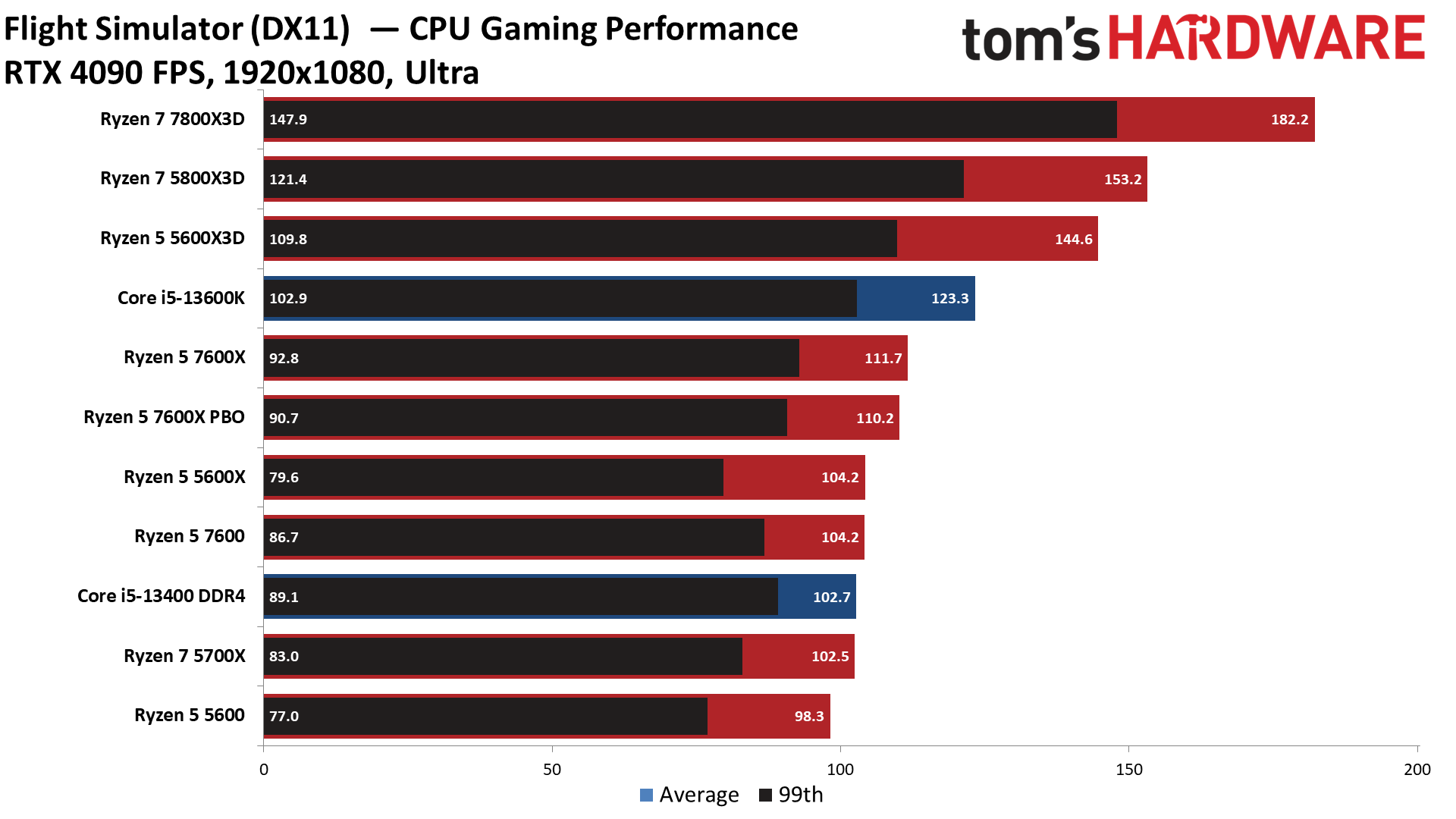
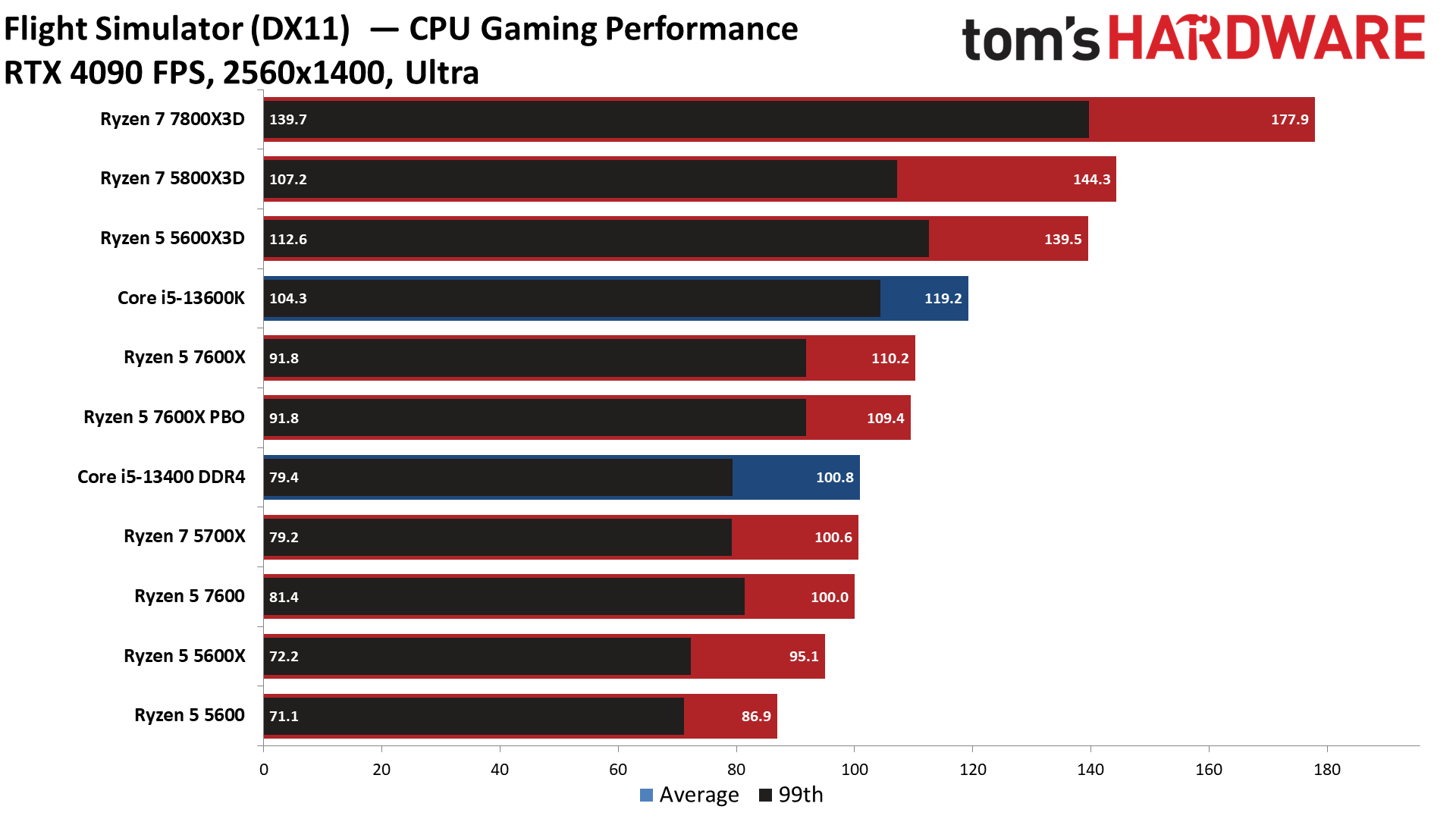
Microsoft Flight Simulator 2021 is another title that prizes the capacious 96MB of L3 cache on the X3D processors. Once again, the three X3D models top the chart at both resolutions. The Zen 4-powered Ryzen 7 7800X3D is the pinnacle of gaming CPUs, taking a 26% lead over the 5600X3D. The 5800X3D is no slouch, either, as it notches a 6% lead over the 5600X3D.
However, all other chips can’t come close to the 5600X3D, which is anywhere from 17% faster than the Core i5-13600K to 41% faster than the Core i5-13400.
Red Dead Redemption 2 Benchmarks on AMD Ryzen 5 5600X3D
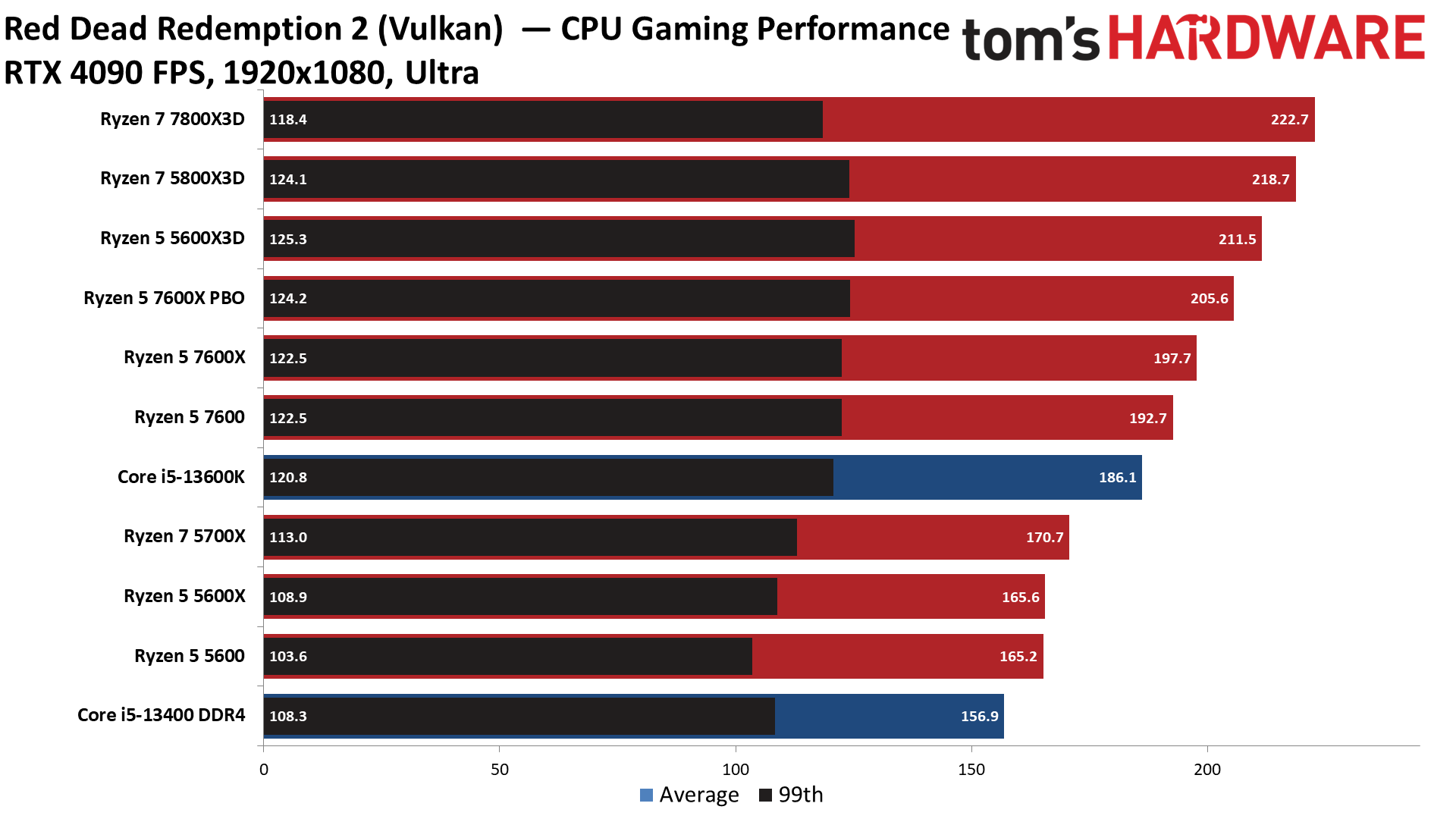
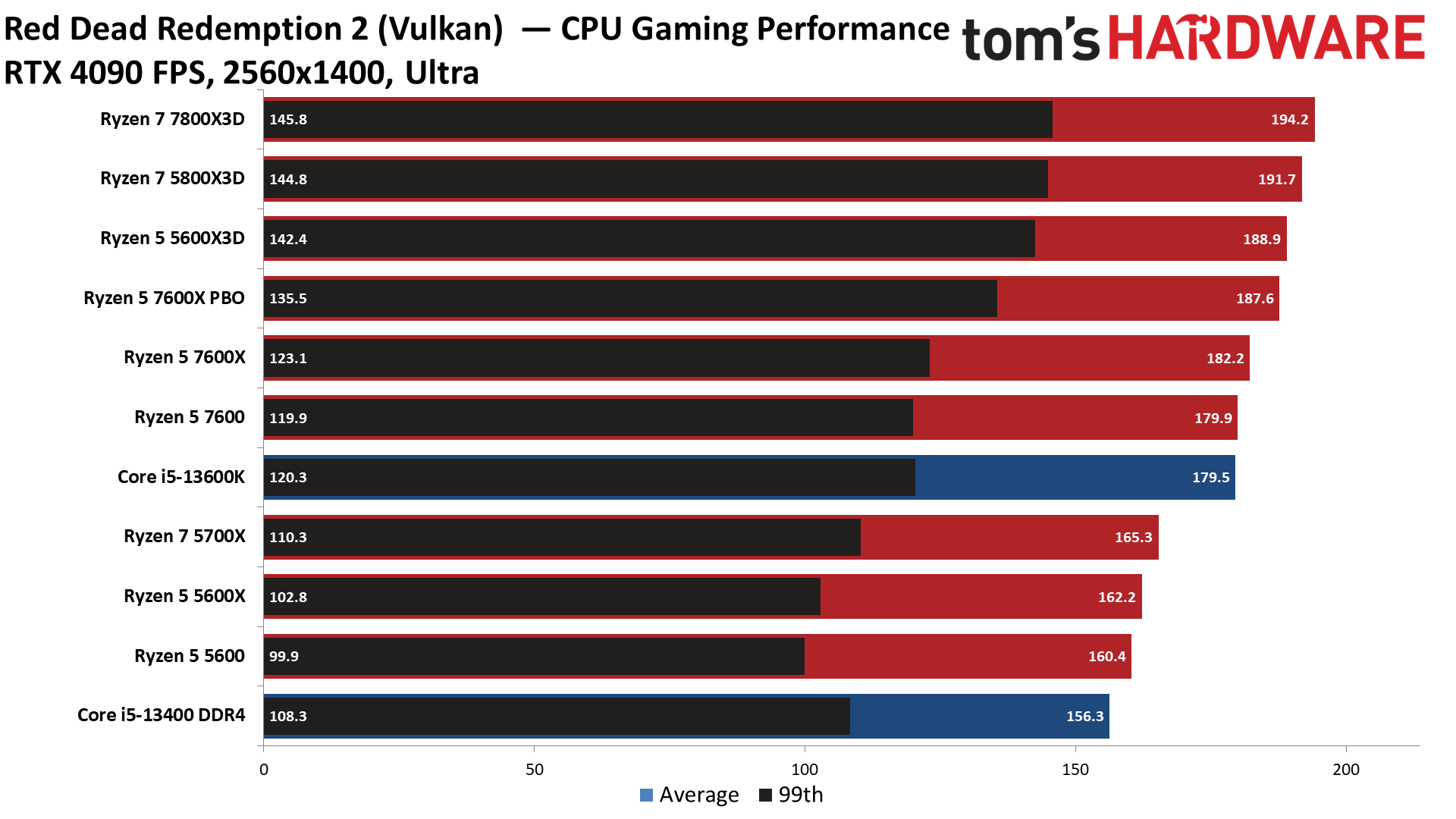
While the deltas aren’t as pronounced as we’ve seen in the previous two titles, the X3D processors also lead the Red Dead Redemption 2 charts. Here the 5600X3D carves out a 35% win over the Core i5-13400, and a still-solid 14% lead over the Core i5-13600K.
Warhammer 3 Benchmarks on AMD Ryzen 5 5600X3D
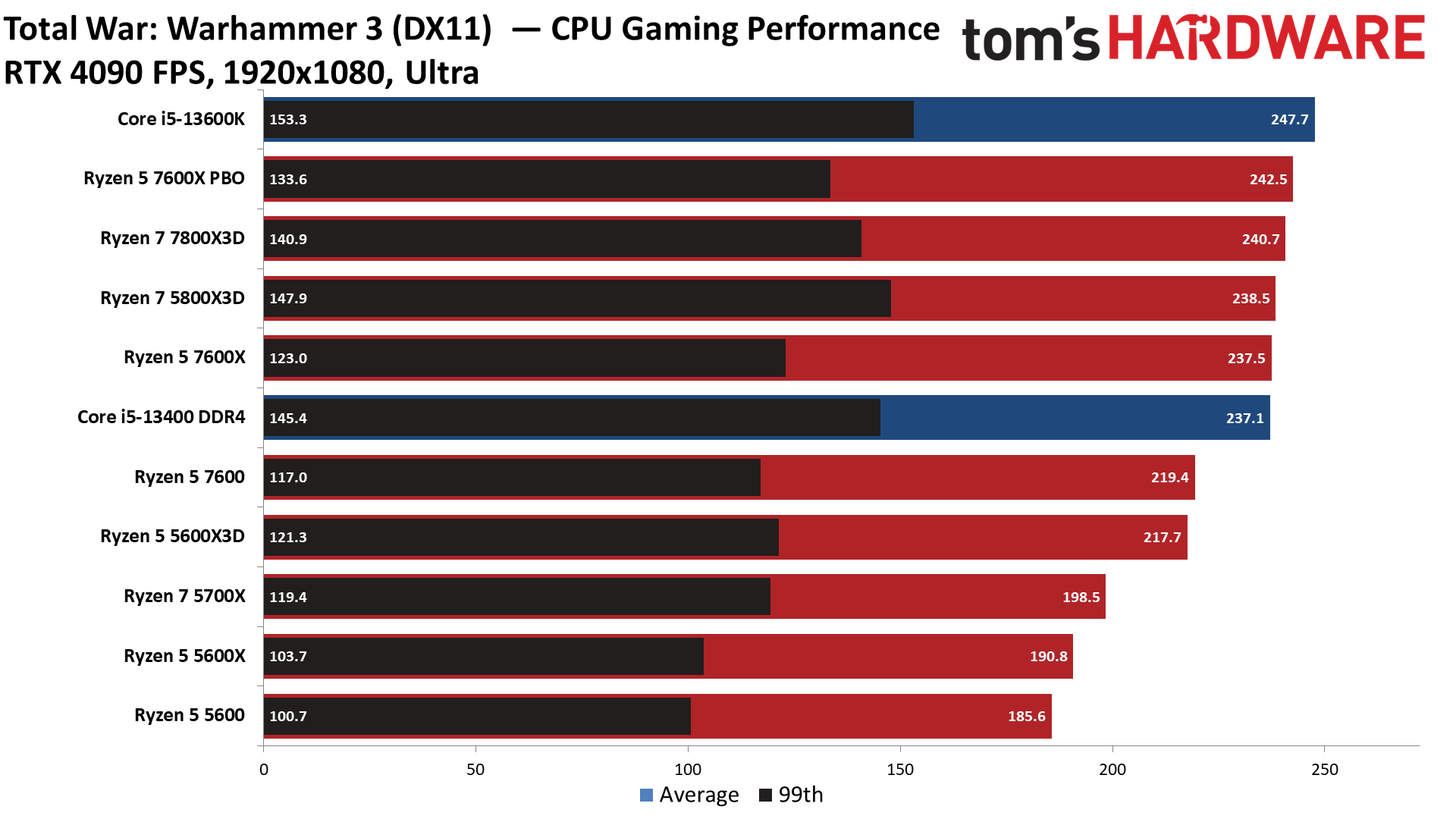
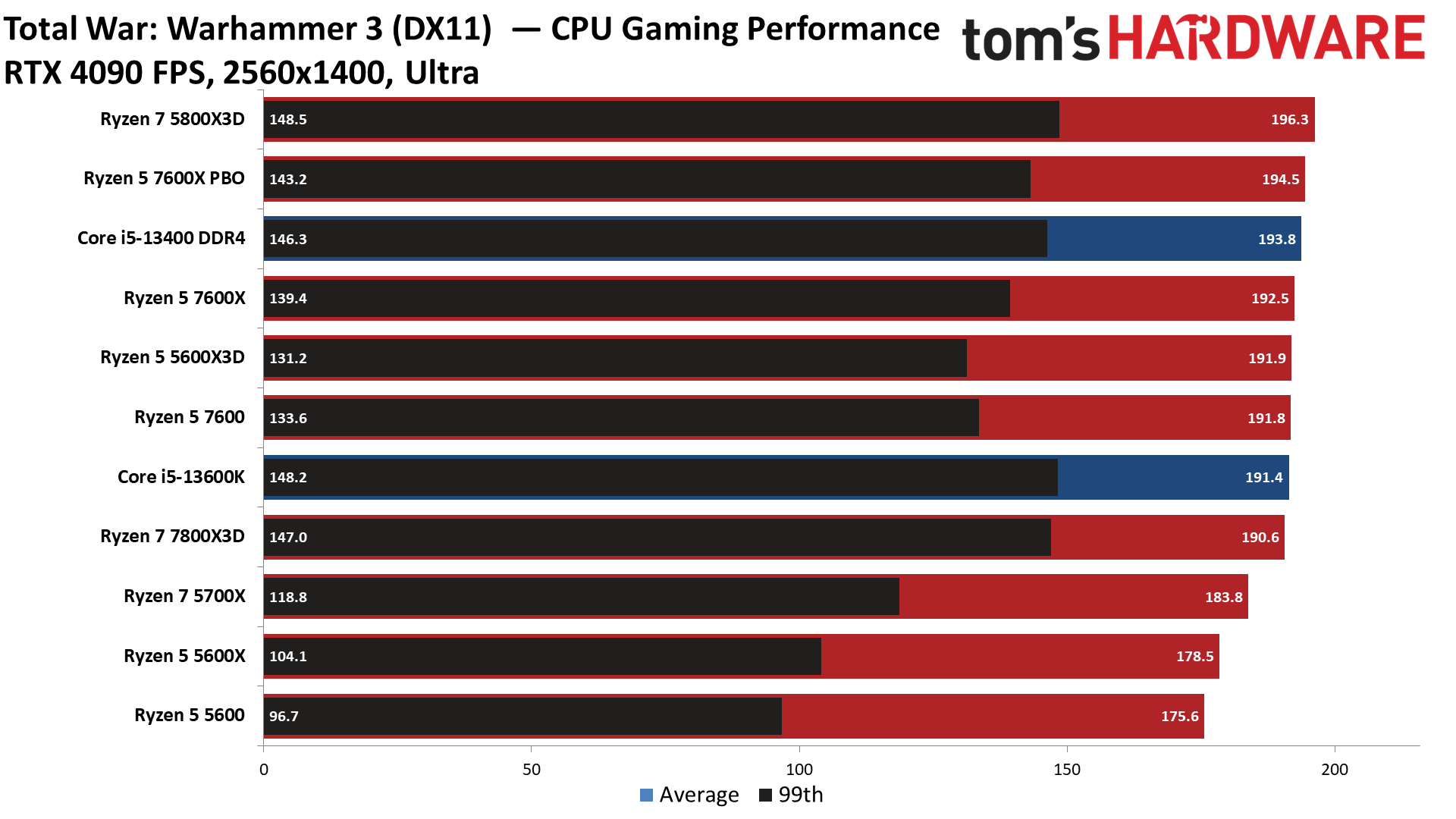
Some titles can’t take as much advantage of the X3D cache as others, and Warhammer 3 is a good example of a title that sees less-than-stellar acceleration. Here the six-core Ryzen 5 7600 beats the 5600X3D by a slim margin, while its full-featured 7600X counterpart is 9% faster than the 5600X3D. Meanwhile, the Core i5-13400 scores a rare win against the 5600X3D with a 9% lead.
Watch Dogs Legion Benchmarks on AMD Ryzen 5 5600X3D
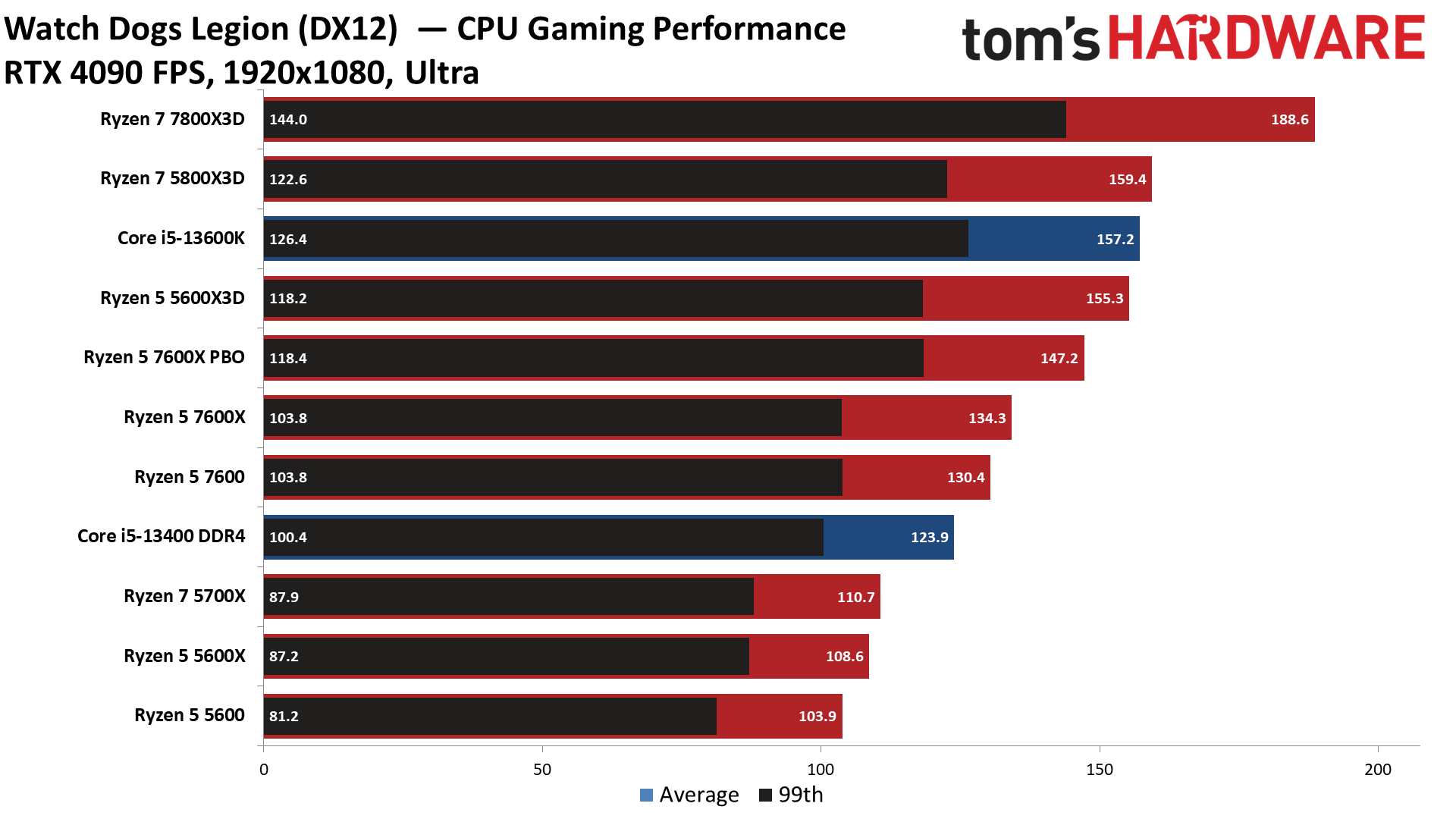
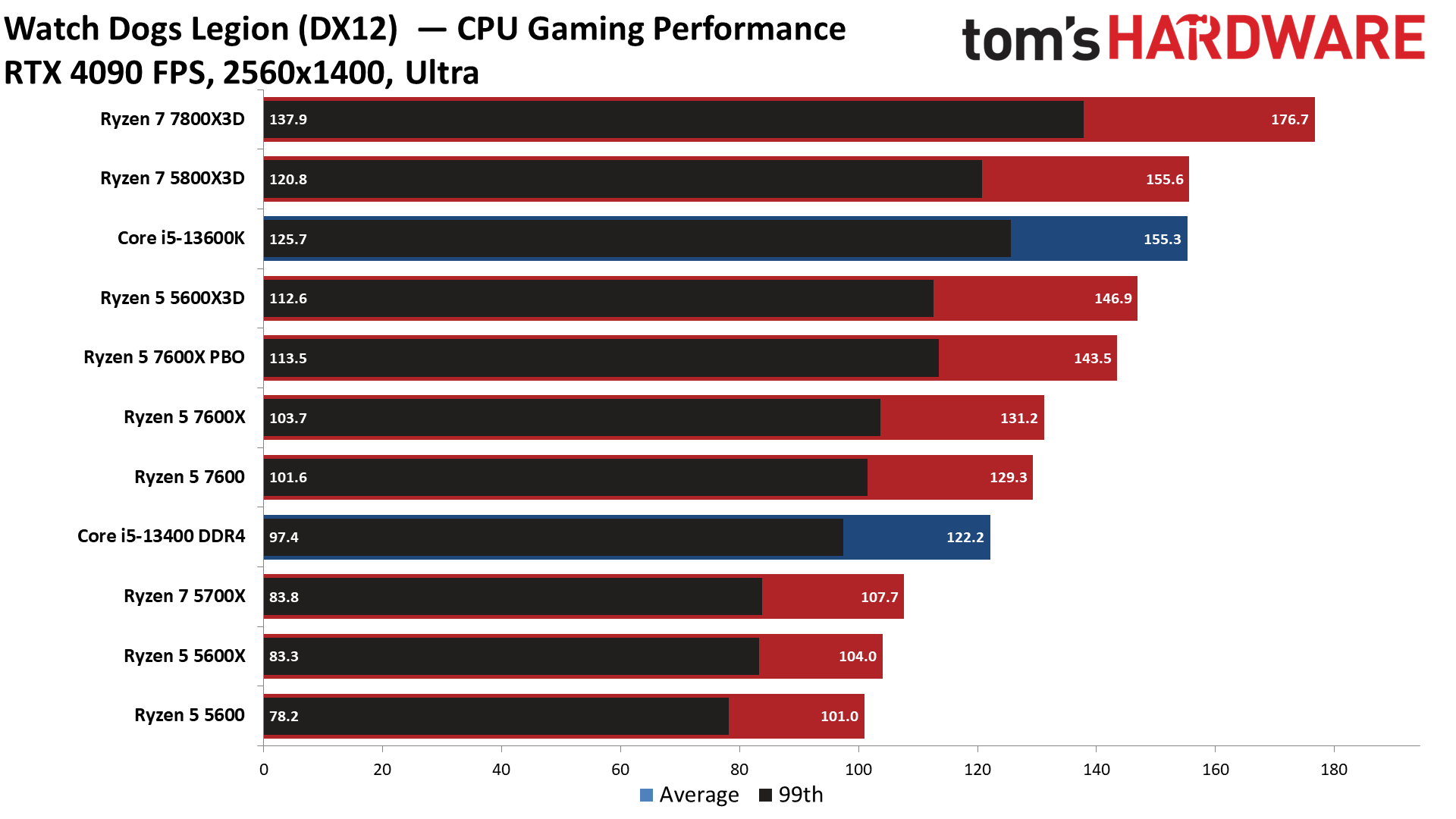
Once again, the Ryzen 5 5600X3D lands within a stone’s throw of its bigger brother, the Ryzen 7 5800X3D. Here the 5700X3D is only 2.6% faster than the 5600X3D.
AMD Ryzen 5 5600X3D Productivity Benchmarks — The TLDR
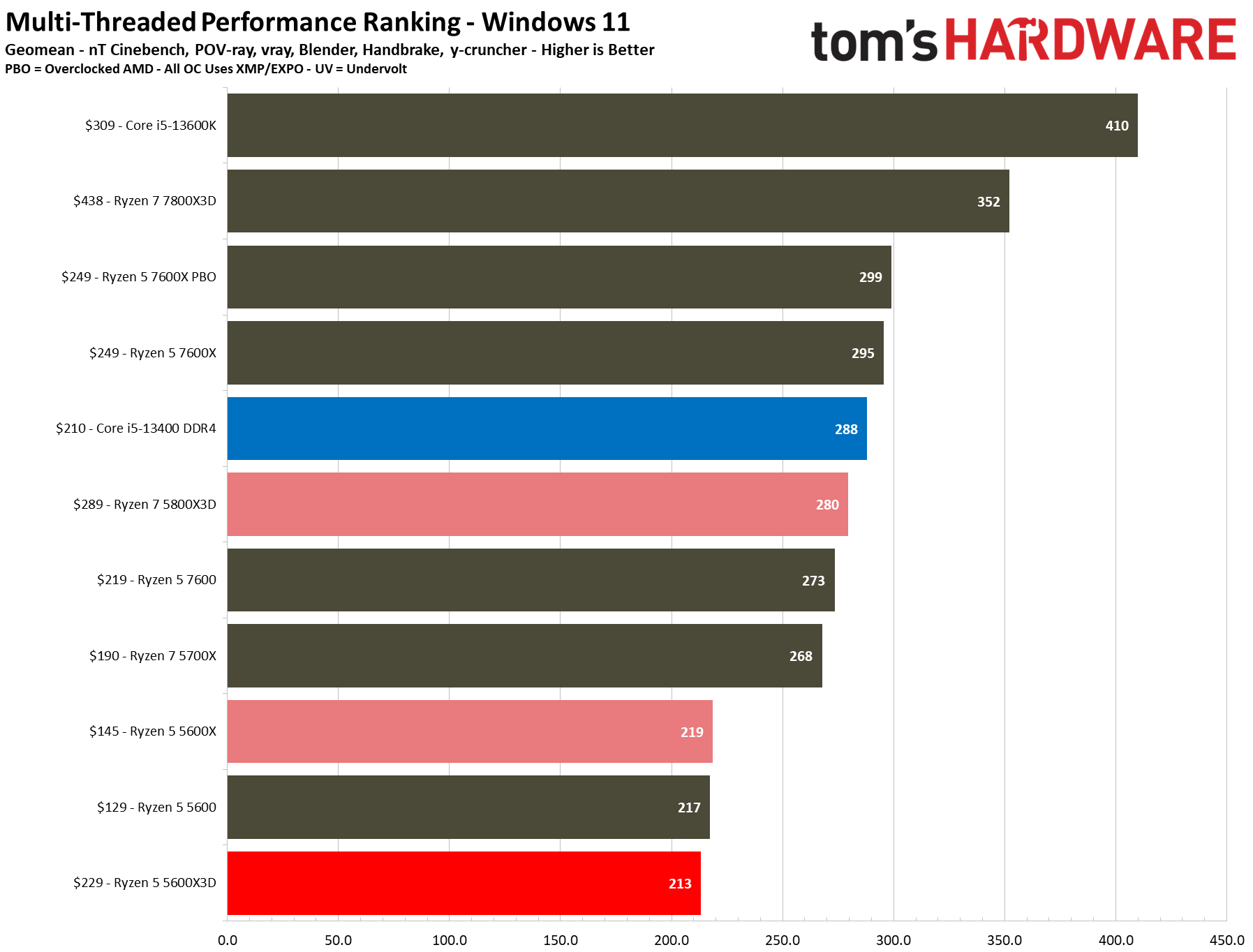
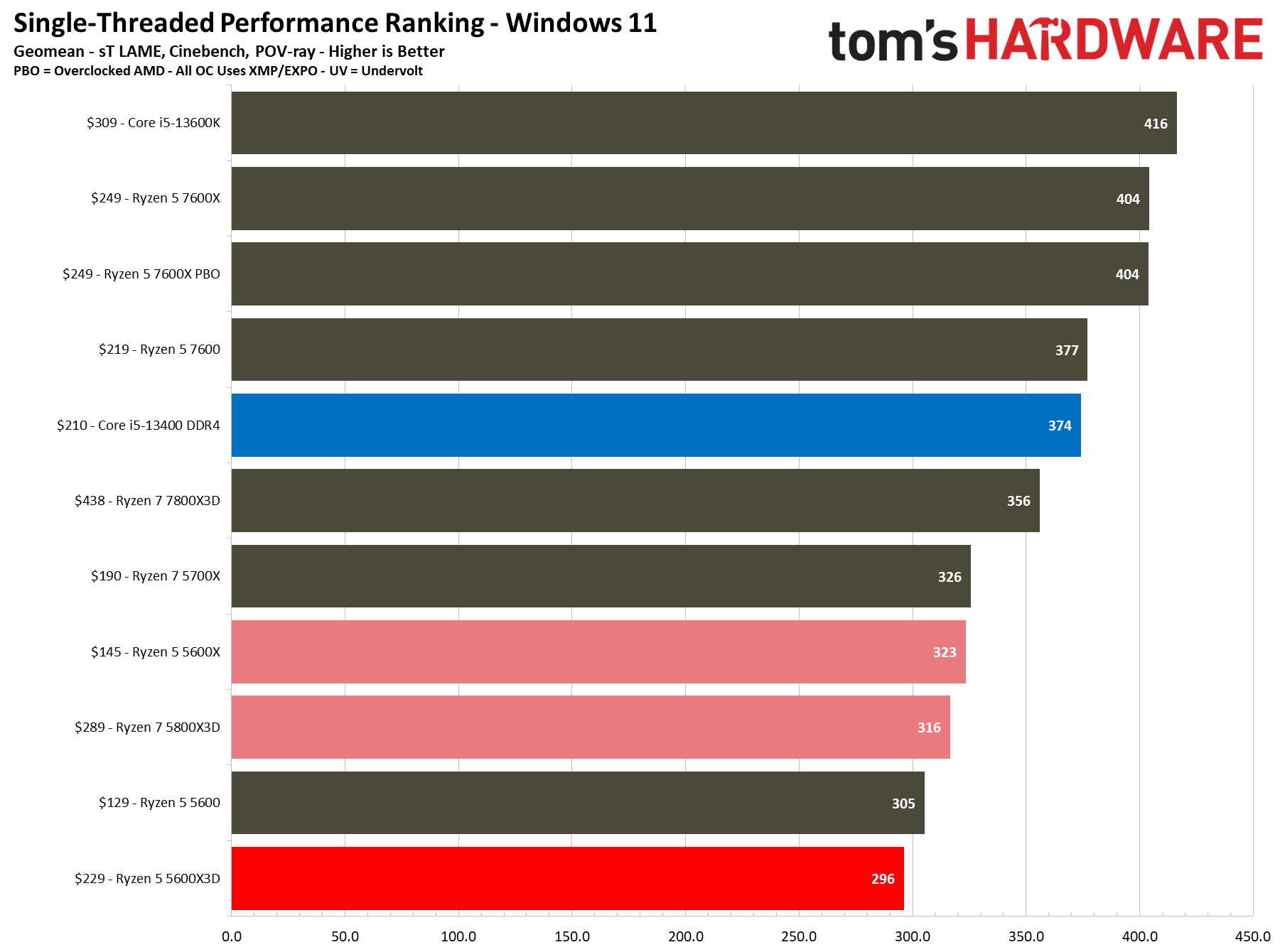
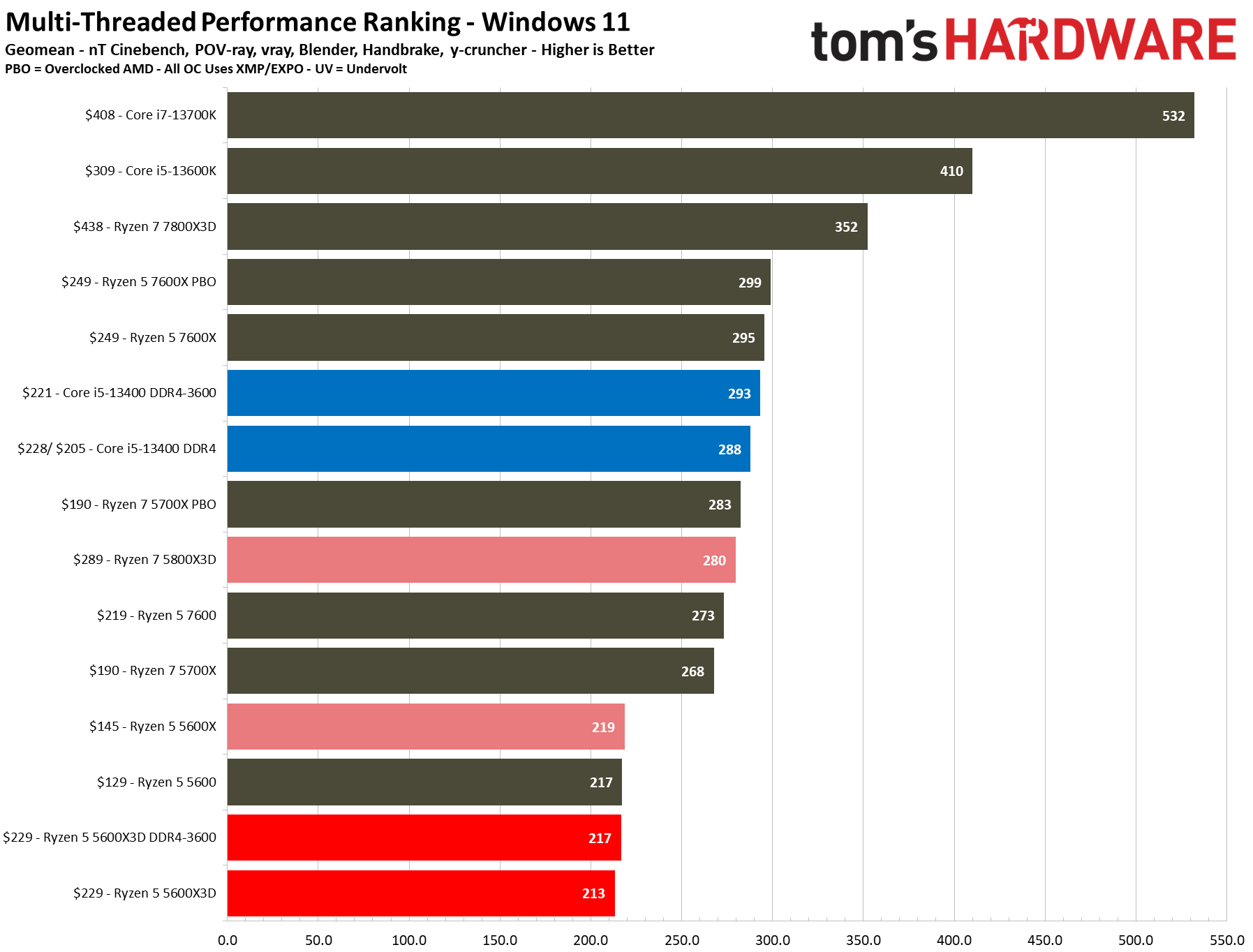
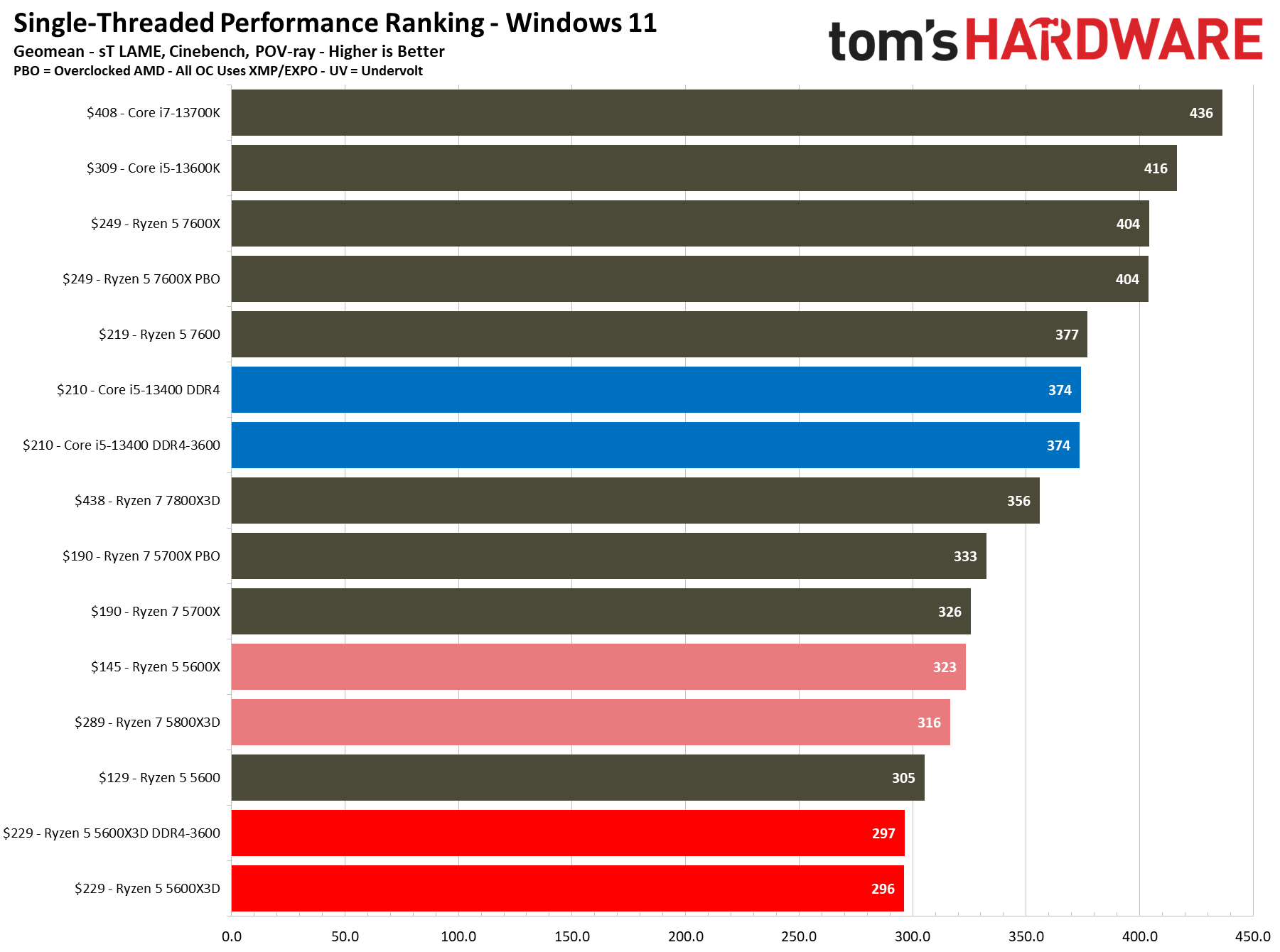
The first slides are simplified without the overclocking configs, while the remainder of the slides in the album covers the full roster of tested configurations. We boil productivity application performance down into two broad categories: single- and multi-threaded. These slides show the geometric mean of performance in several of our most important tests in each category, but be sure to look at the individual benchmark results below.
The Ryzen 5 5600X3D’s 3D V-Cache tech provides a major performance uplift in games, but the resulting lower boost clock speeds hamstring performance in productivity applications. The 5600X3D's older Zen 3 microarchitecture and six CPU cores also factor in to make it a less-than-stellar performer in productivity applications.
The Intel Core i5-13400 is 35% faster in threaded applications and 26% faster in single-threaded work than the 5600X3D, highlighting that it’s the far better choice if you’re looking for an all-rounder in this price range.
The Ryzen 5 5600X3D does manage to tie the Ryzen 5 5600X in our threaded benchmarks, and that is a result of its higher 105W TDP rating. As you can see in our power testing on the following page, at times, the Ryzen 5 5600X3D will draw more power than the 65W Ryzen 5 5600X in threaded applications. That’s because the 5600X has a lower TDP limit. In contrast, the 105W Ryzen 5 5600X3D regularly peaked at 85W, which allows it to maintain comparable (or even higher) all-core clock speeds when under heavy load. This does help in threaded applications — just not much.
The higher TDP doesn’t help in lightly threaded work, though, as the 5600X3D’s lower single-core boost frequency significantly hampers performance in single-threaded work, giving the 5600X a 9% lead. Even the $129 Ryzen 5 5600 is 3% faster than the 5600X3D in single-threaded work and 2% faster in threaded work, highlighting the disparity we see between the 5600X3D’s gaming performance and its performance in desktop PC productivity applications.
You’ll need to carefully assess your common usage and workloads if you’re upgrading to a 5600X3D, and plan accordingly. While you gain tremendously in gaming performance, you will lose quite a bit of performance in applications. If you’re upgrading an existing AM4 system and looking for a more balanced performer, you should give the eight-core Ryzen 7 5700X a close look. This chip is great a value at its current retail pricing.
The Ryzen 5 5600X3D clearly isn't designed to deliver robust performance in applications outside of gaming, so the below results are fairly predictable. As such, we'll limit our commentary throughout the application benchmarks, though we will call out a few areas of interest.
Rendering Benchmarks on AMD Ryzen 5 5600X3D
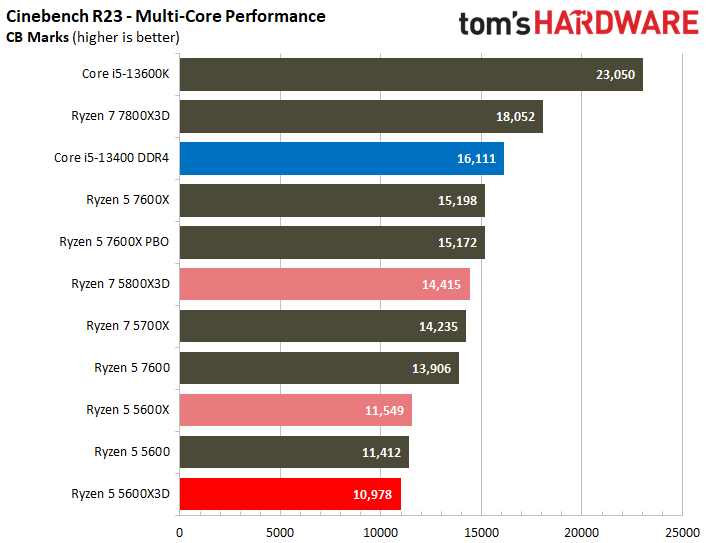
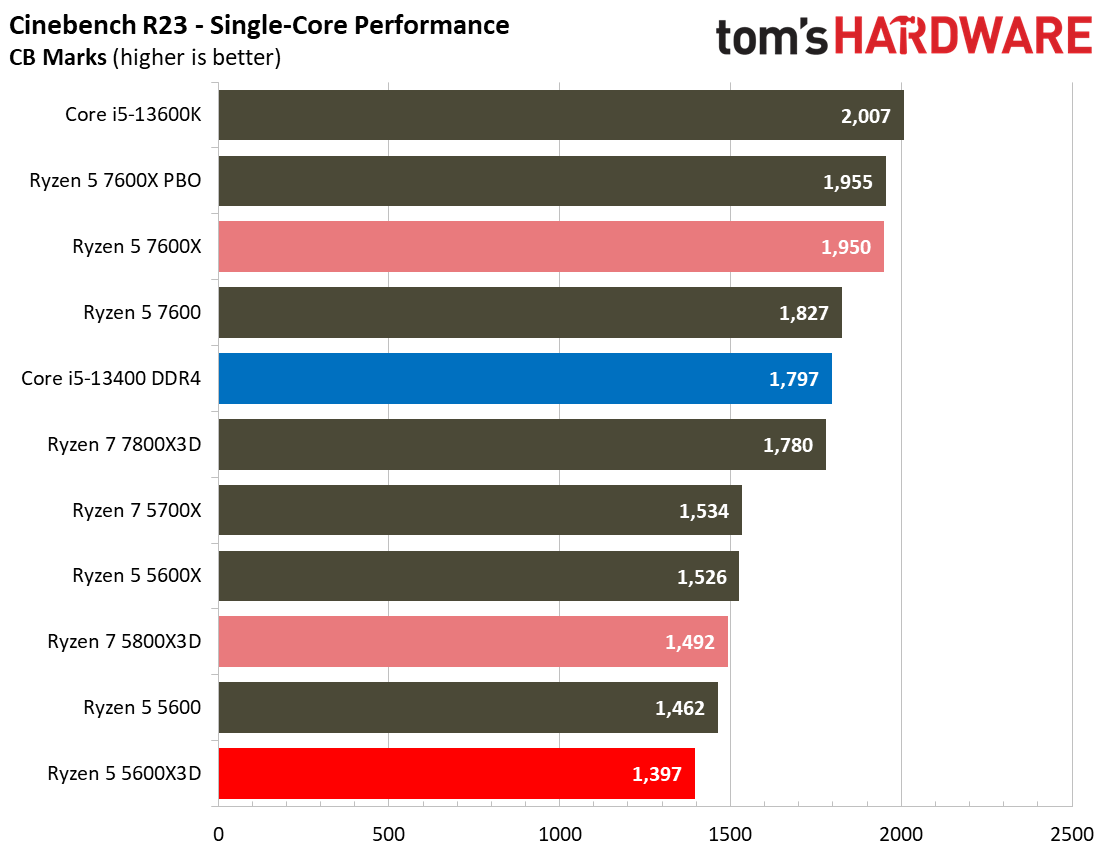
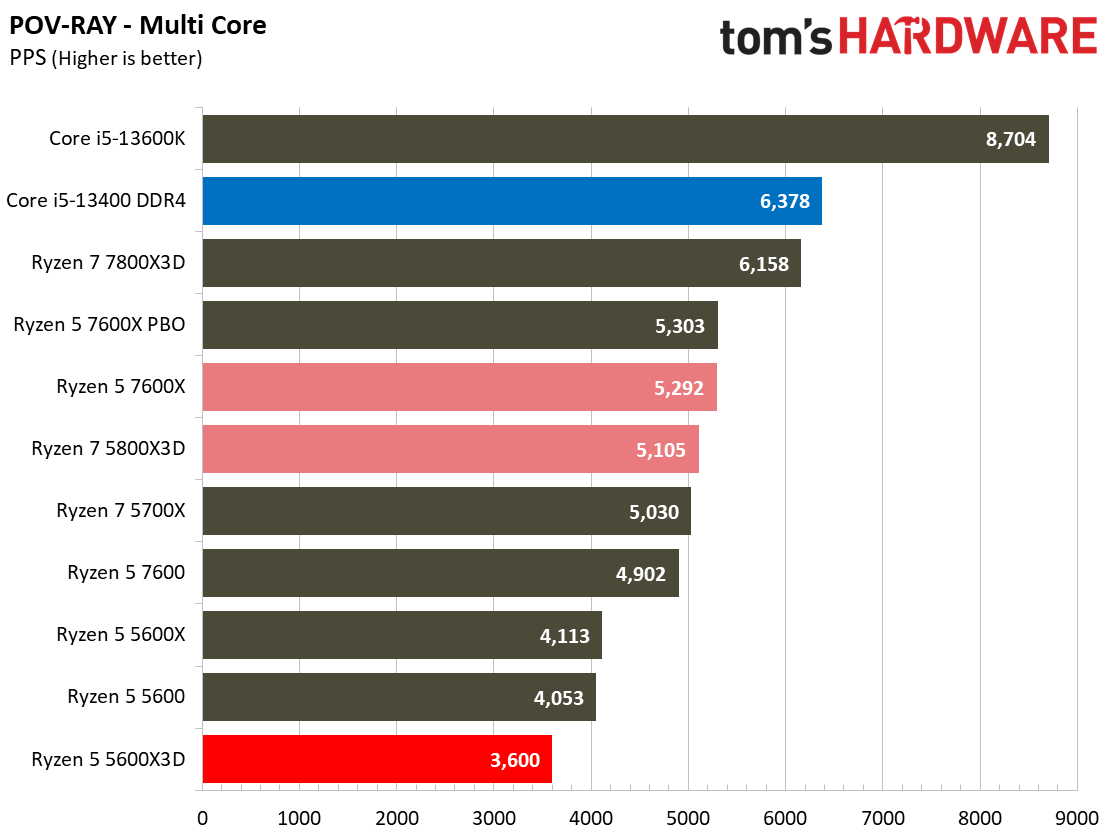
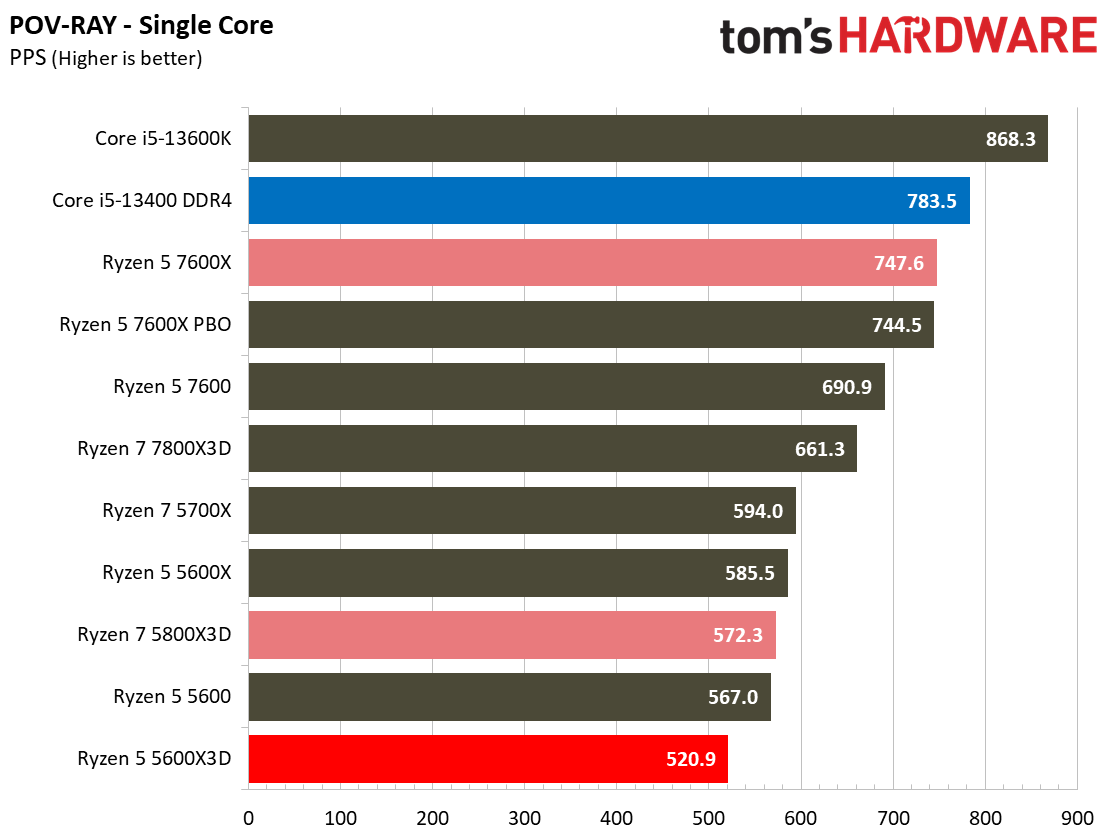
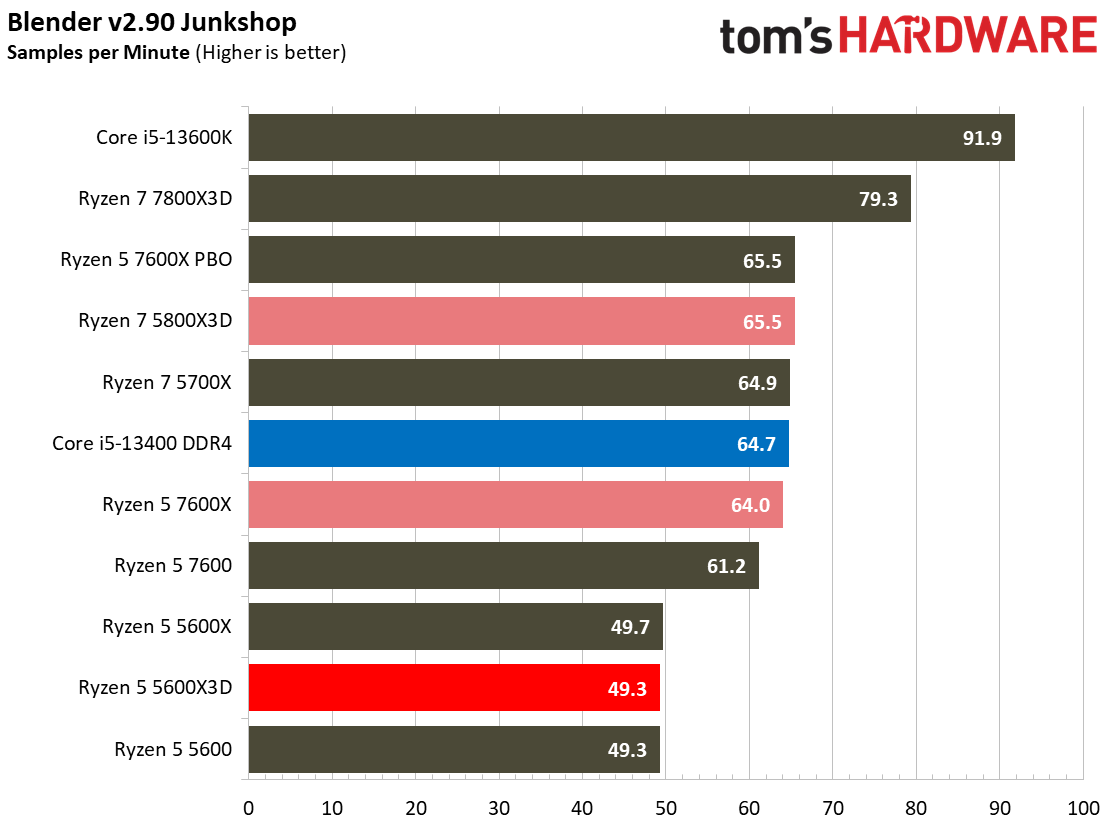
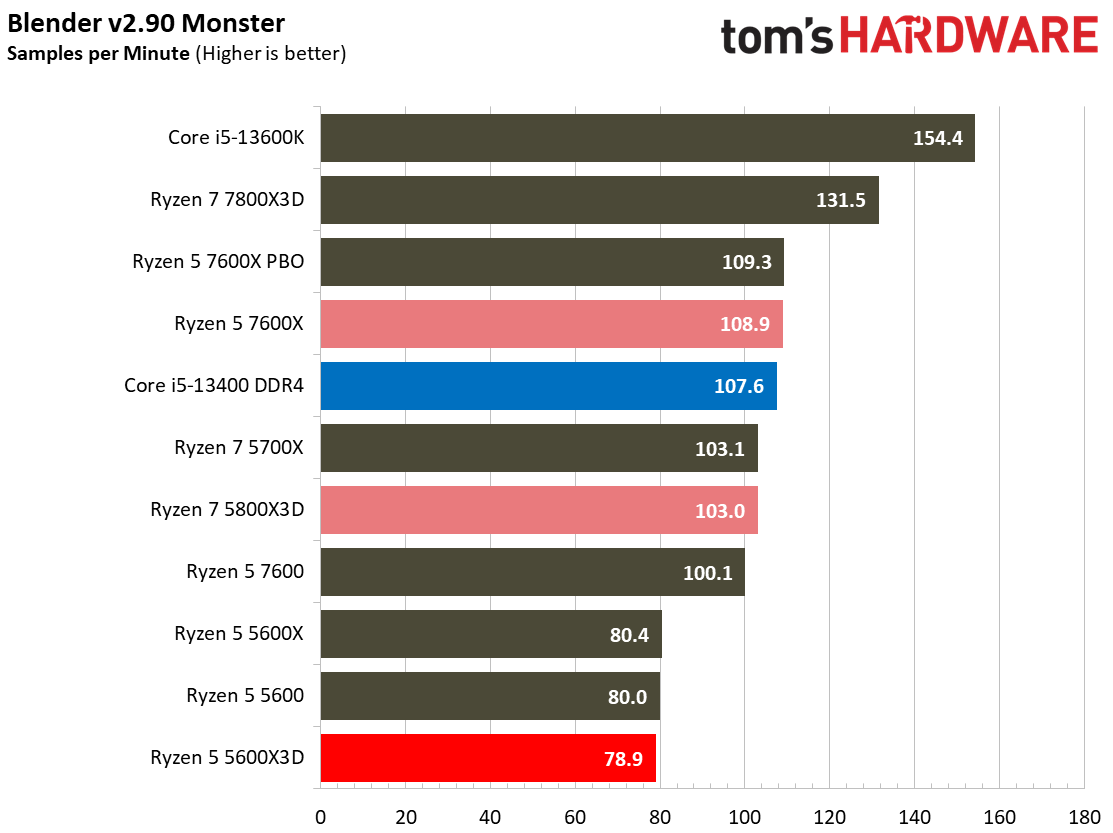
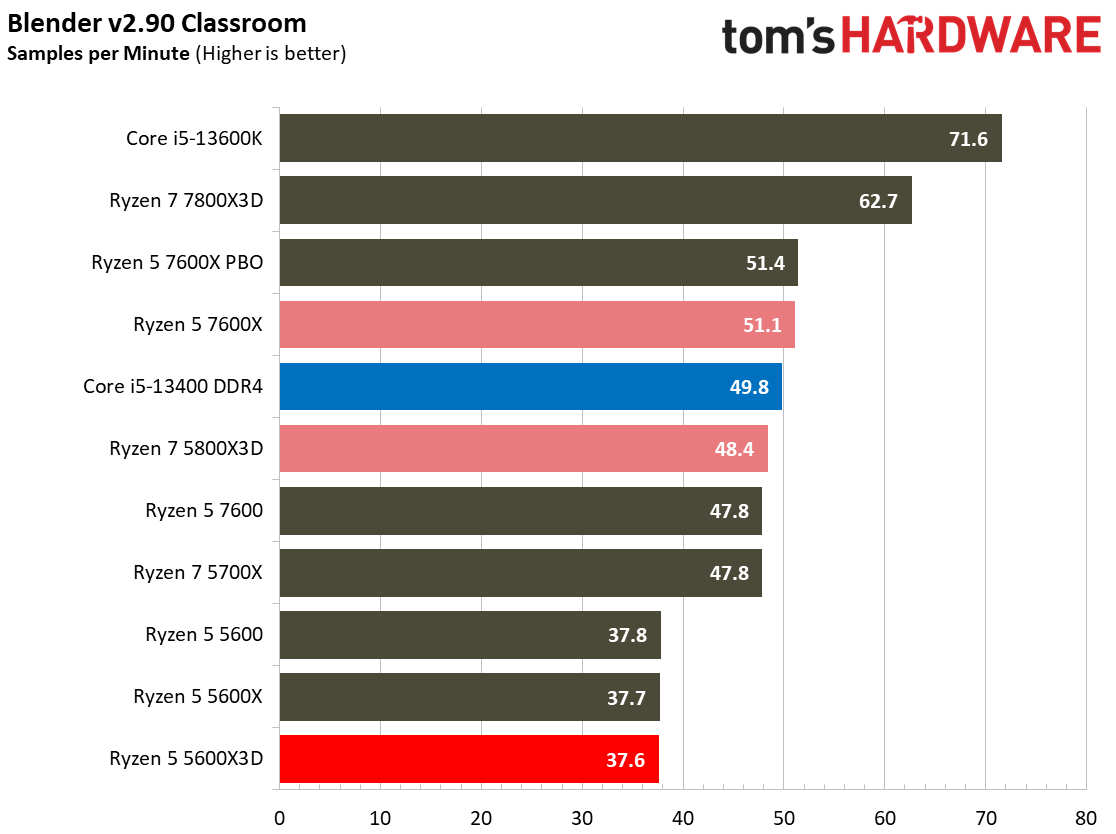
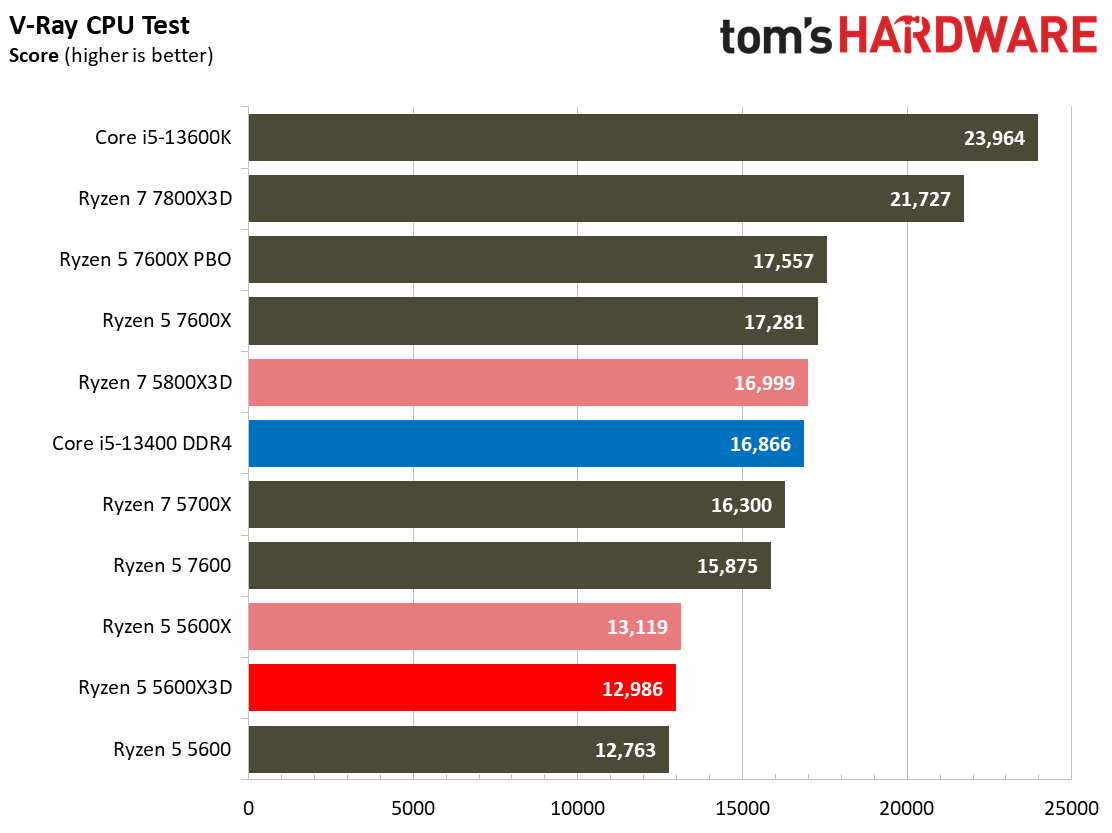
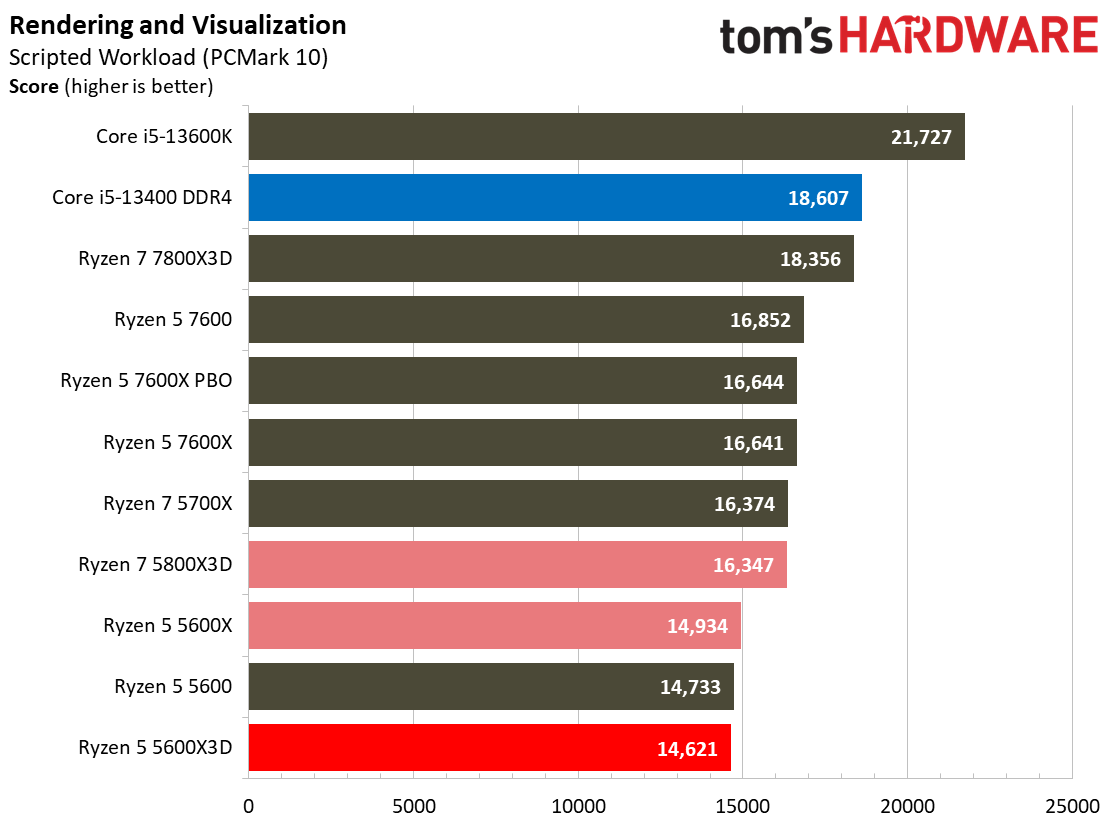
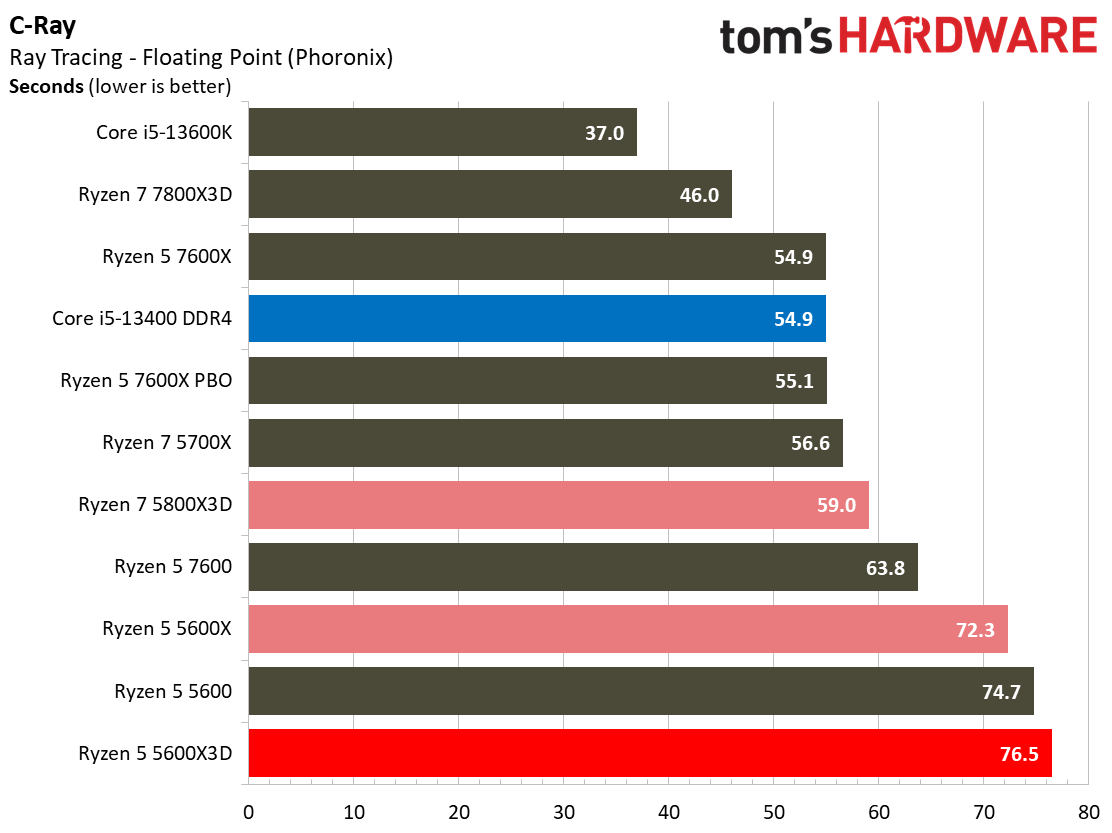
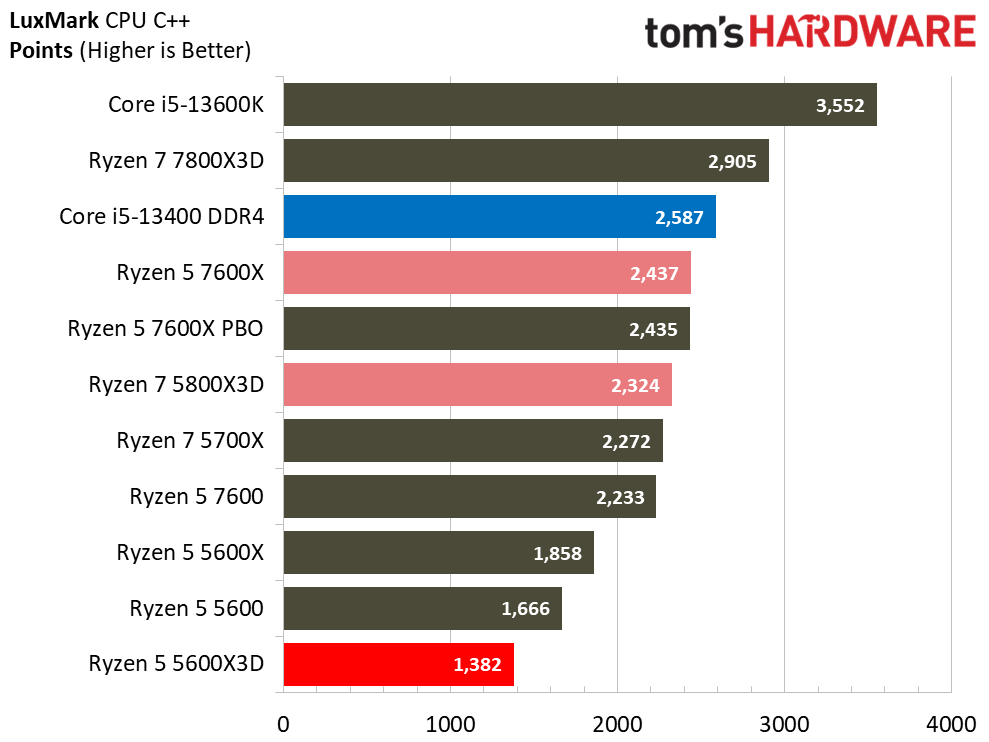
The Ryzen 5 5600X is five percent faster than the 5600X3D in the multi-threaded Cinebench benchmark, and the chip continues to lag the field by substantial amounts throughout the full spate of both single- and multi-threaded benchmarks. The Ryzen 5 5600X3D clearly isn't the best option for rendering workloads, but that's the sacrifice you'll make to access the class-leading gaming performance.
Encoding Benchmarks on AMD Ryzen 5 5600X3D
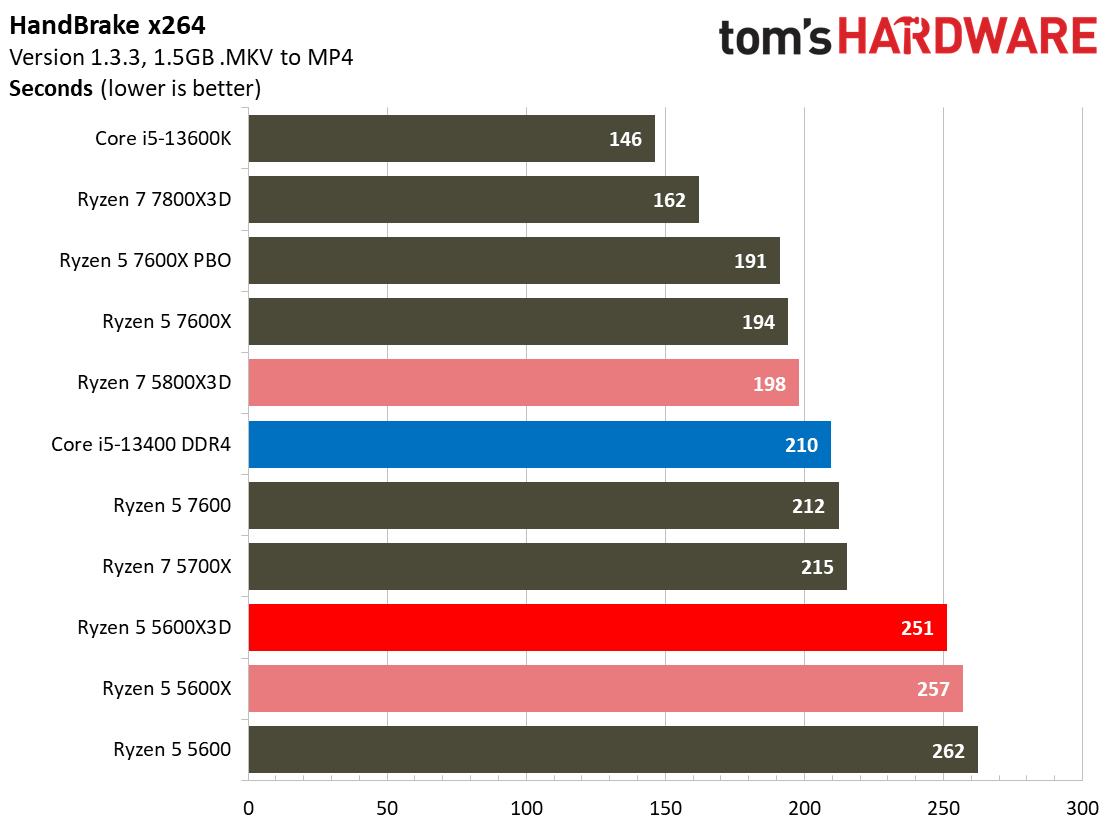
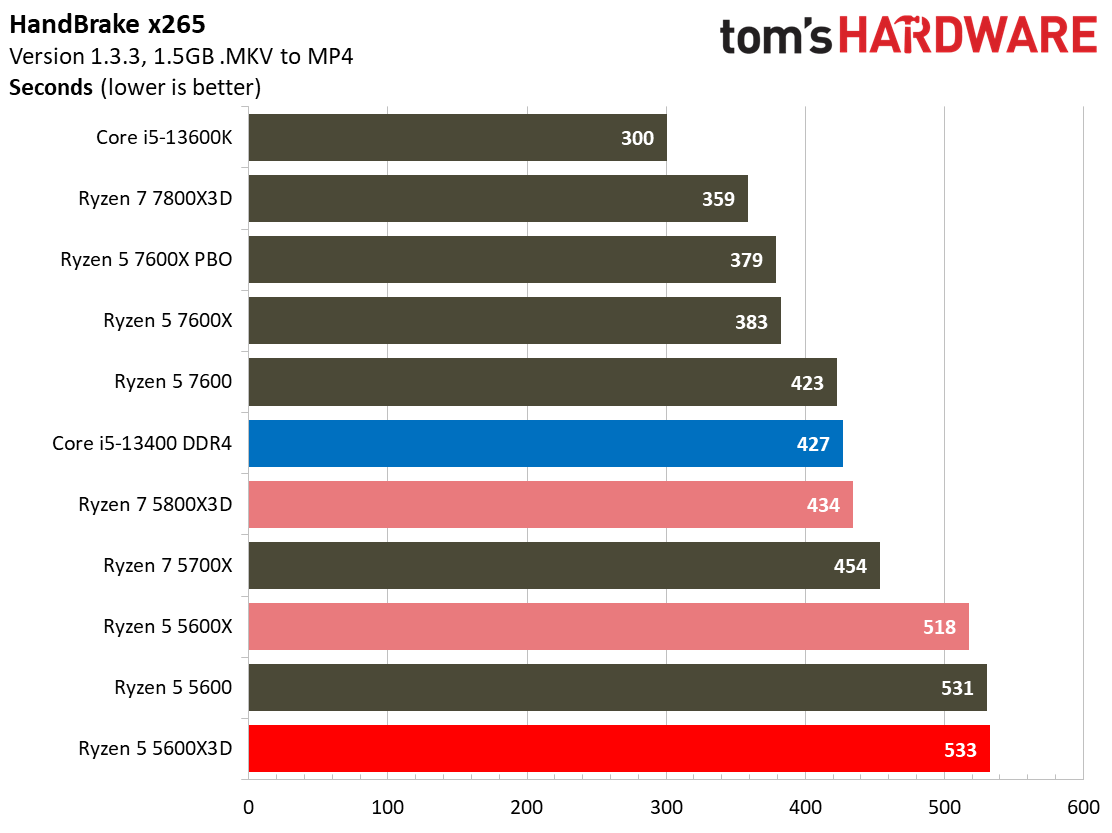
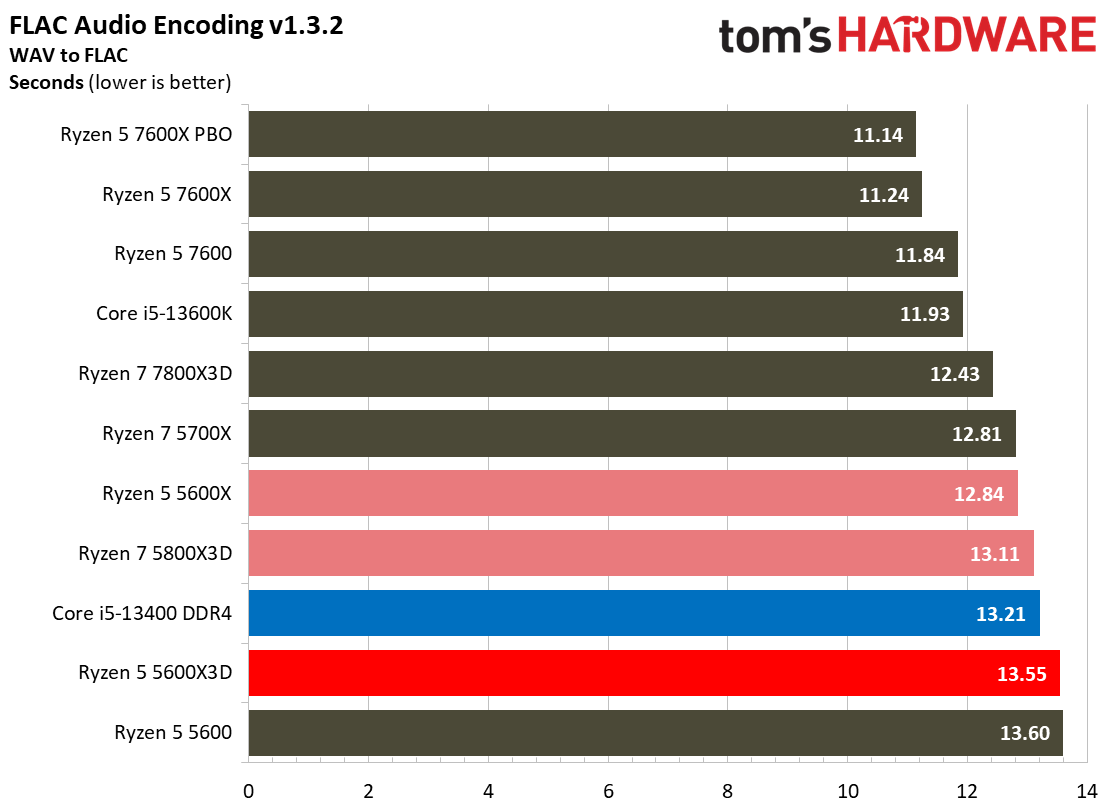
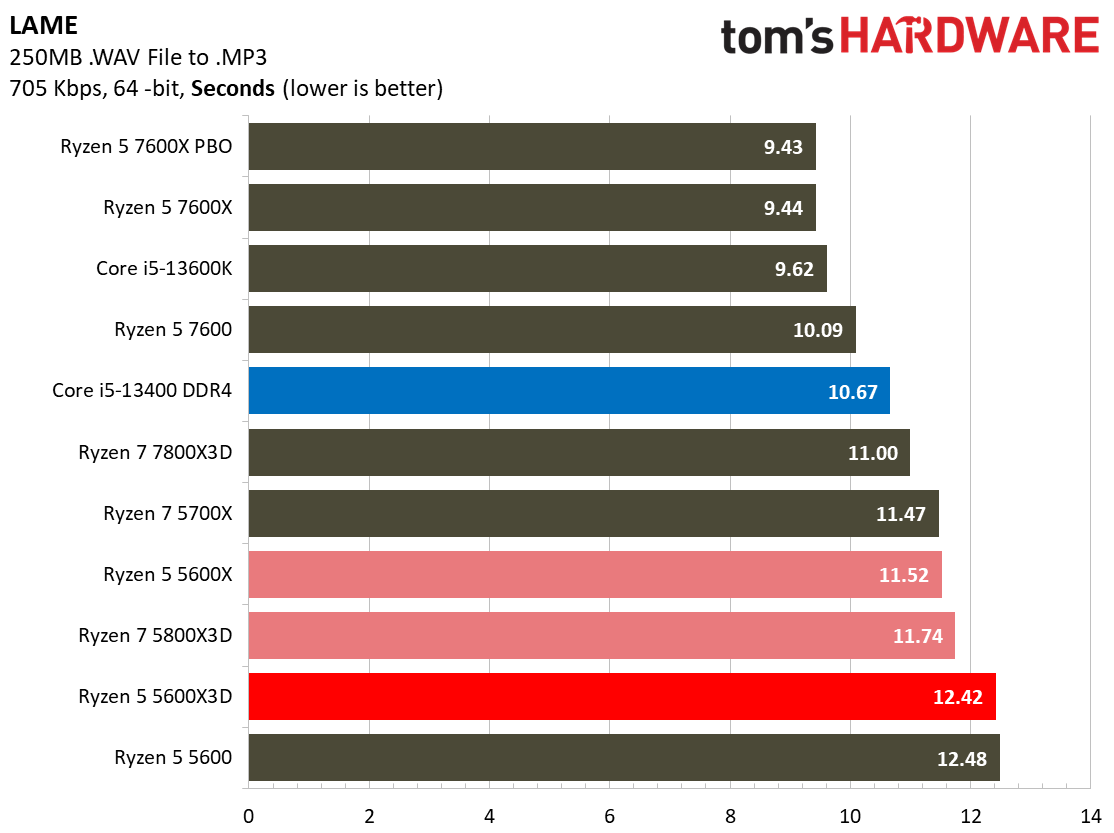
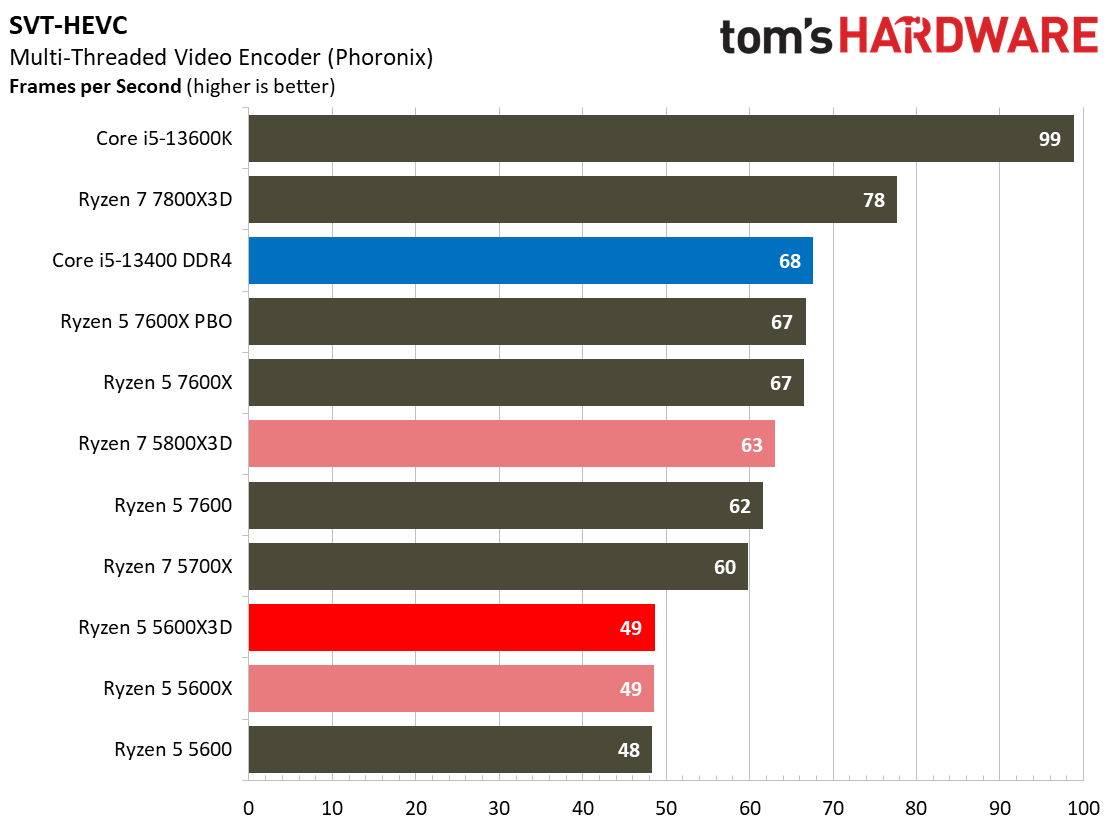
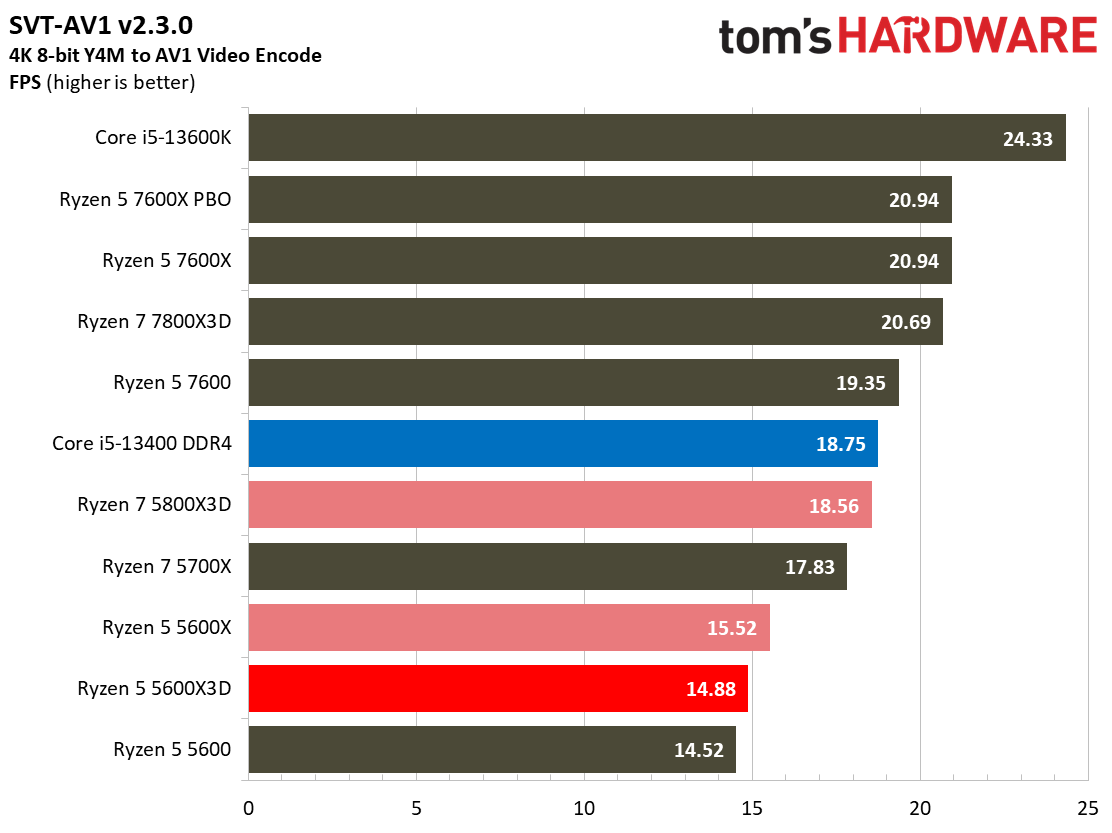
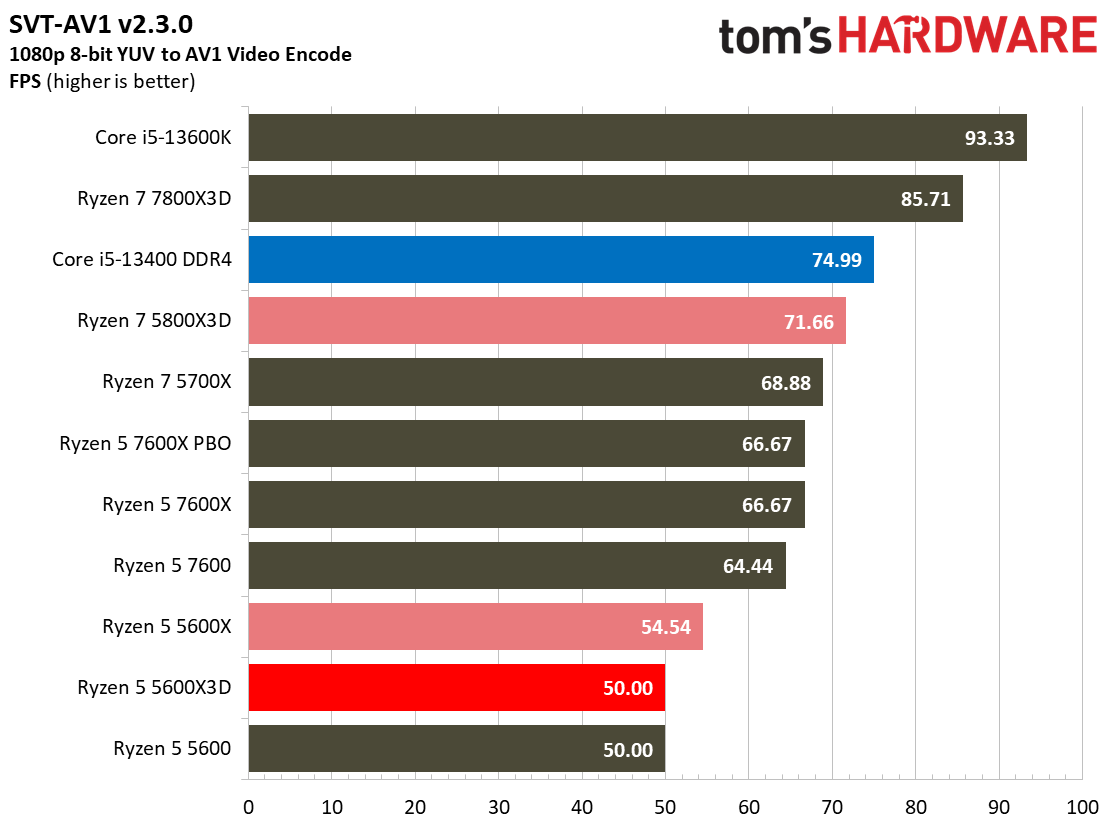
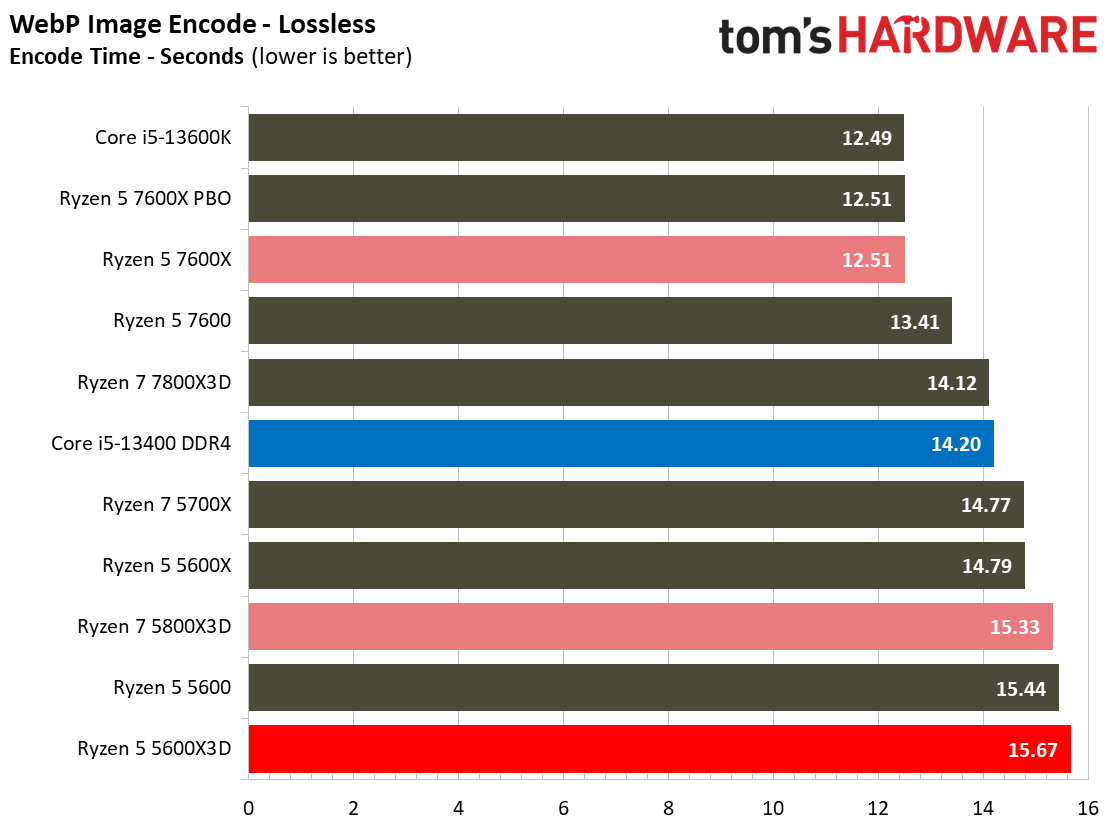

Most encoders tend to be either heavily threaded or almost exclusively single-threaded — it takes an agile chip to master both disciplines. Handbrake, SVT-HEVC, and SVT-AV1 serve as our threaded encoders, while LAME, FLAC, and WebP are indicative of how the chips handle lightly-threaded engines.
The Ryzen 5 5600X3D is actually faster than the Ryzen 5 5600X in the x264 HandBrake test, and our power logging indicates that the chip ran at a higher power draw, and thus higher all-core frequency, during this benchmark. That didn't hold true throughout the rest of the tests as the 5600X3D continued to lag the rest of the field.
Adobe, Web Browsing, Office, and Productivity on AMD Ryzen 5 5600X3D
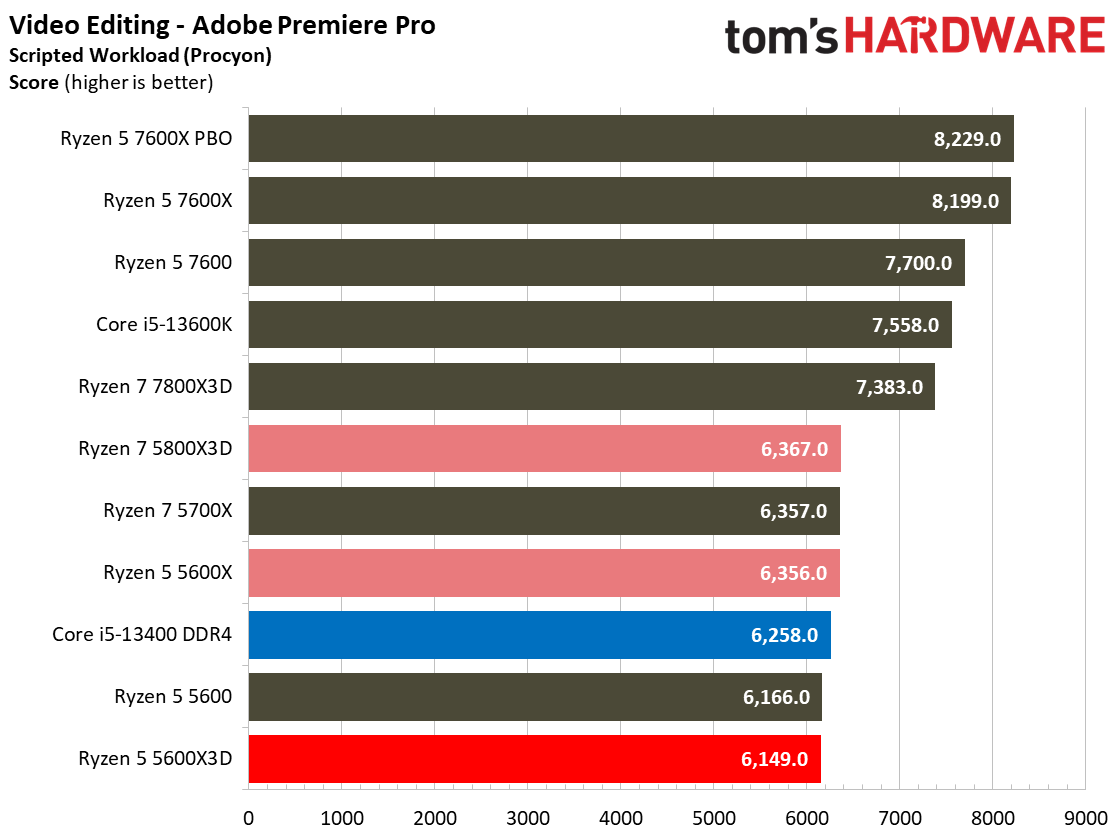
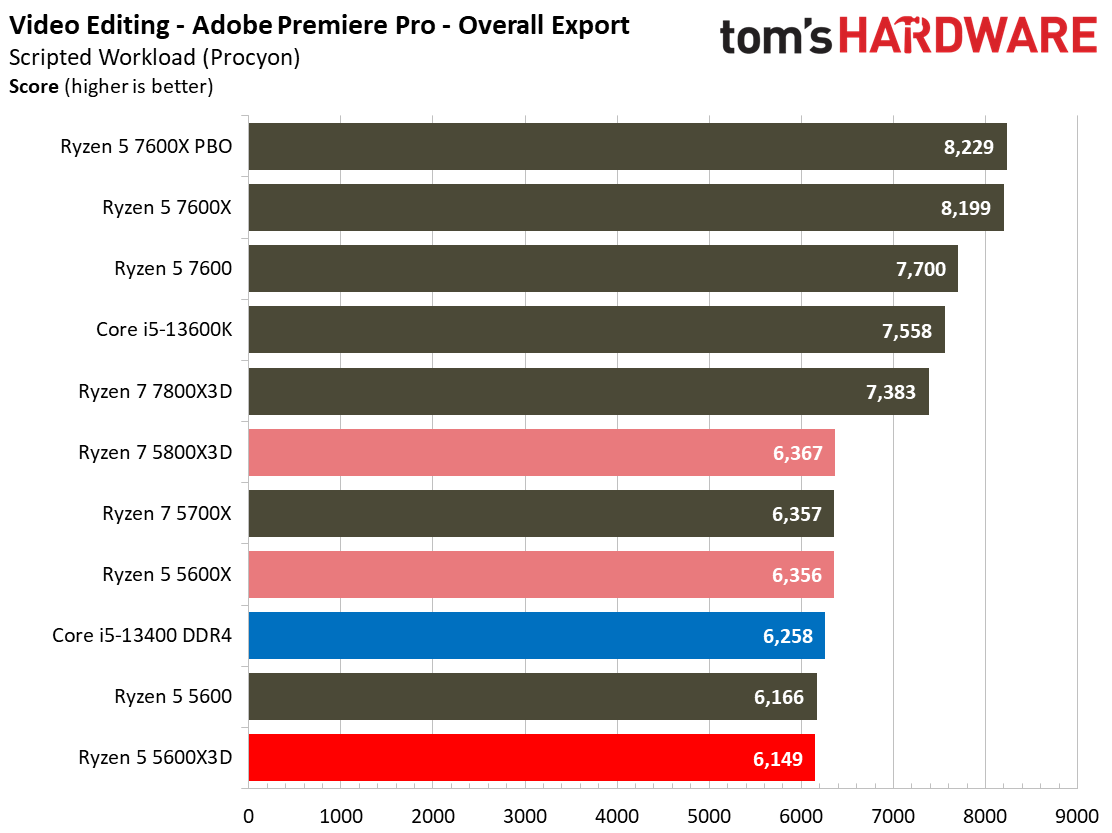
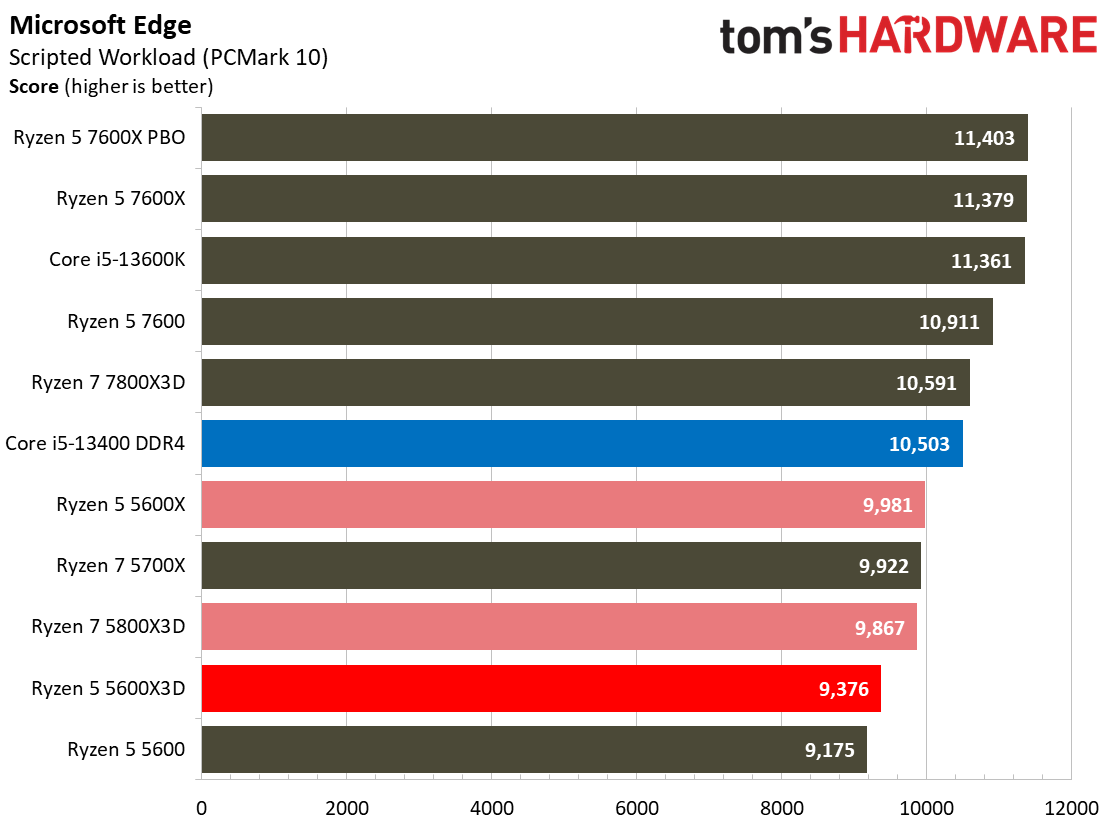
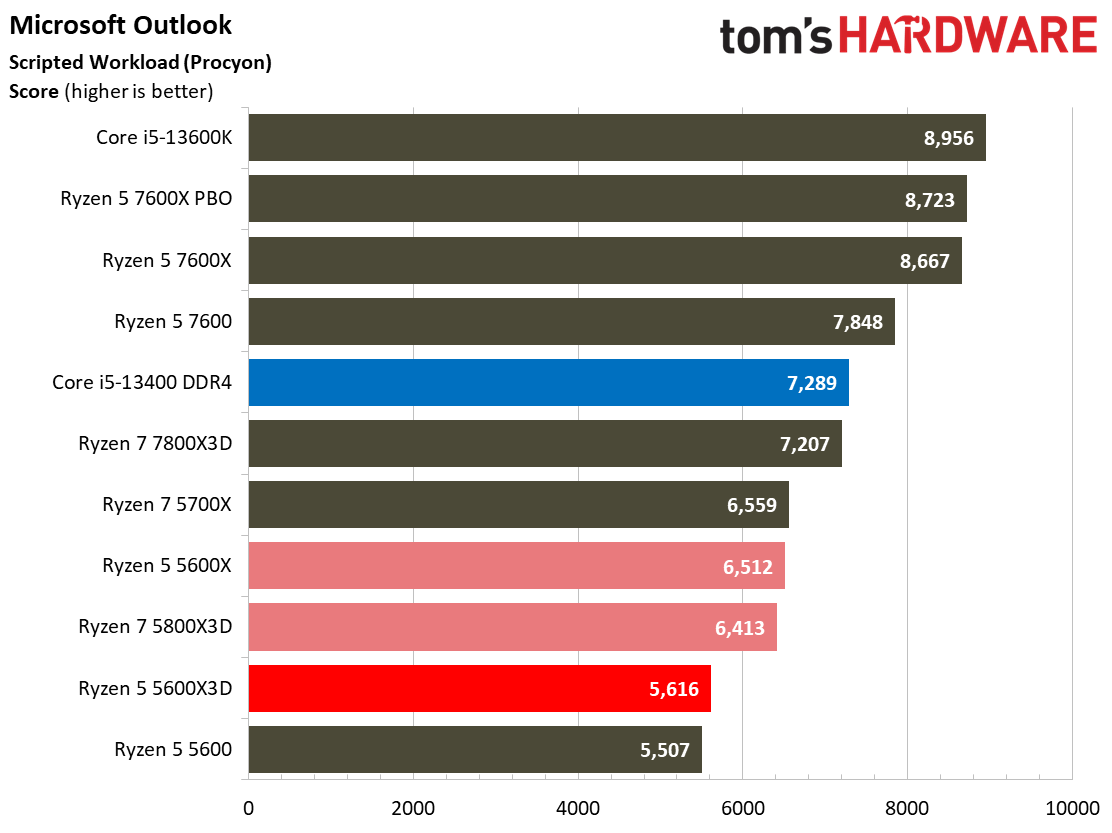
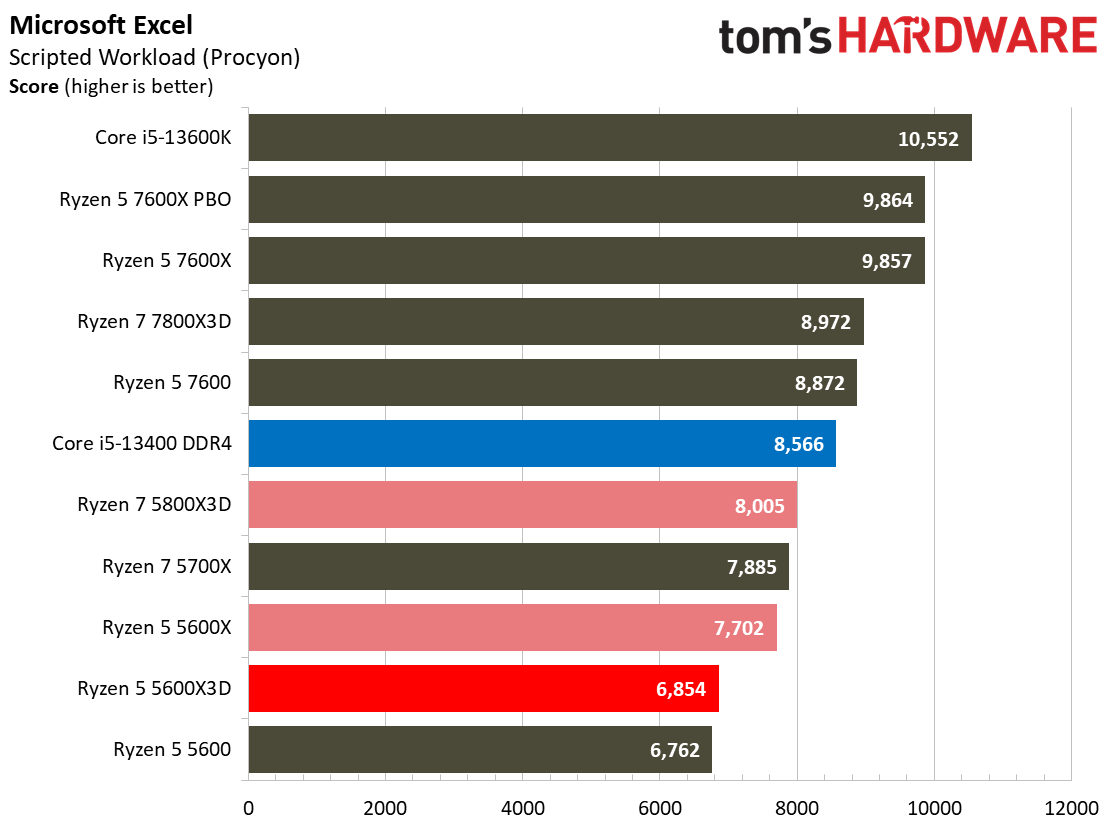
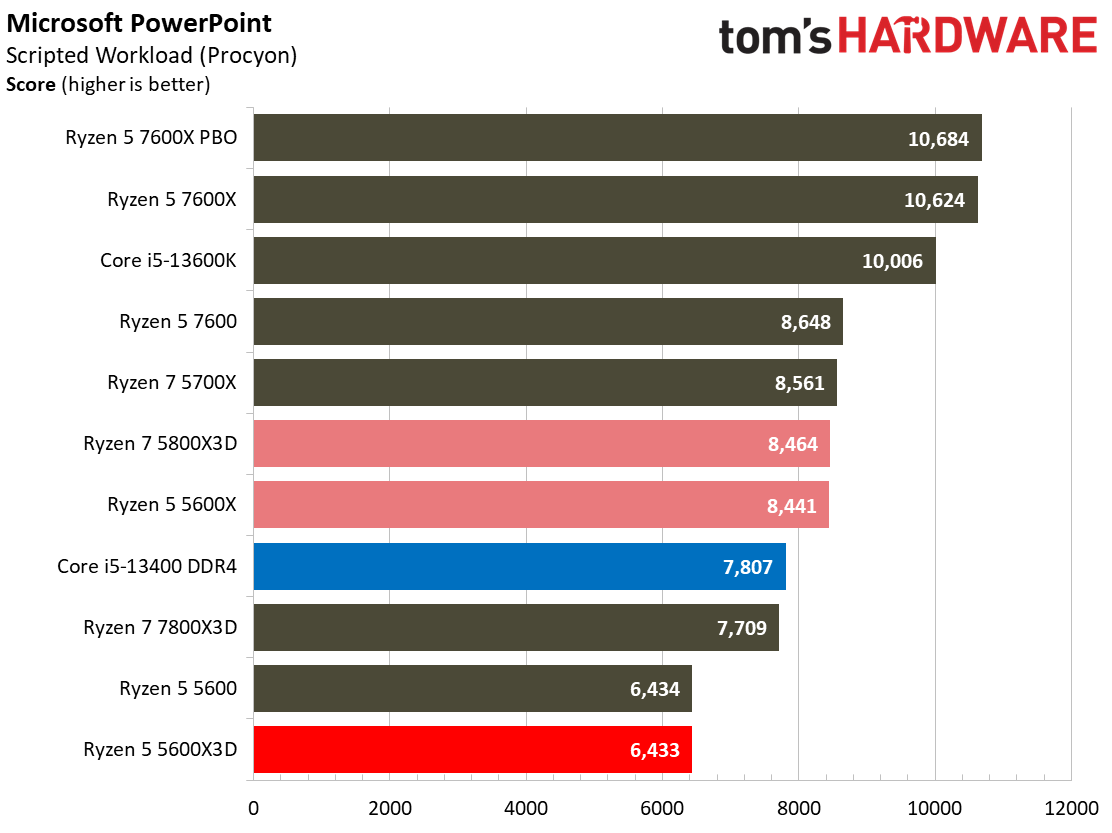
Compilation, Compression, AI Chess Engines, AVX-512 on AMD Ryzen 5 5600X3D
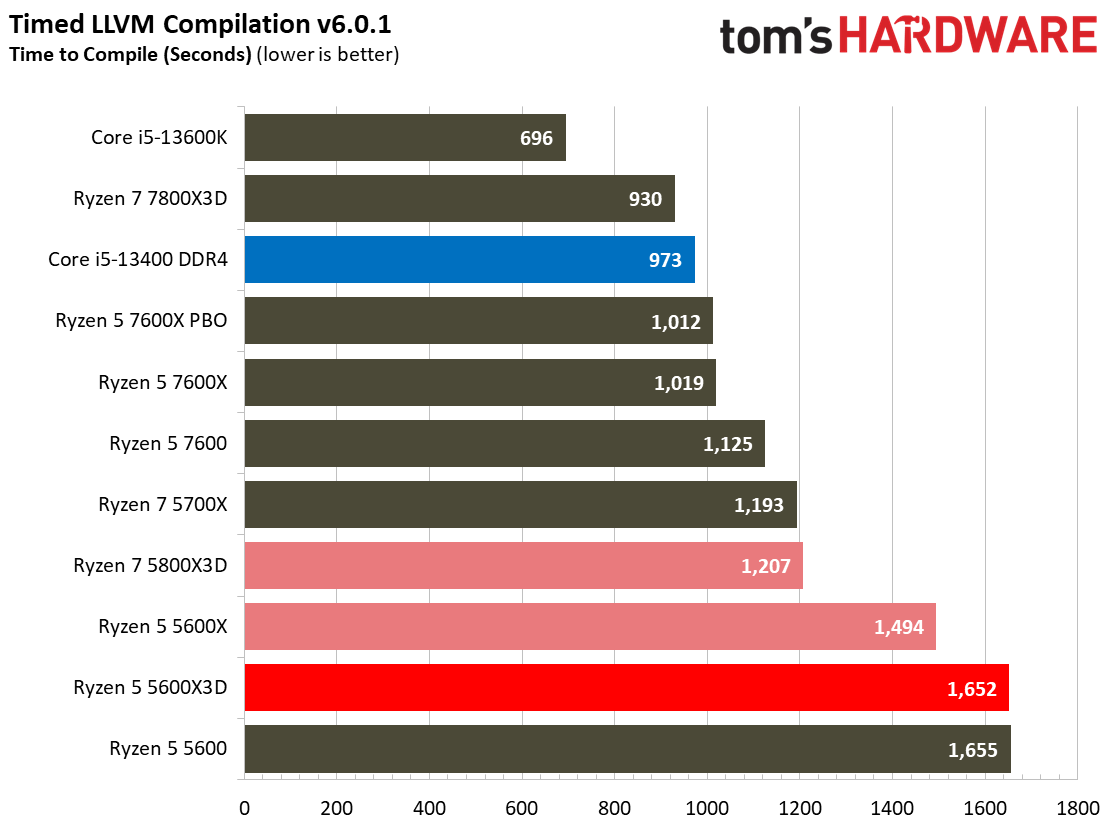
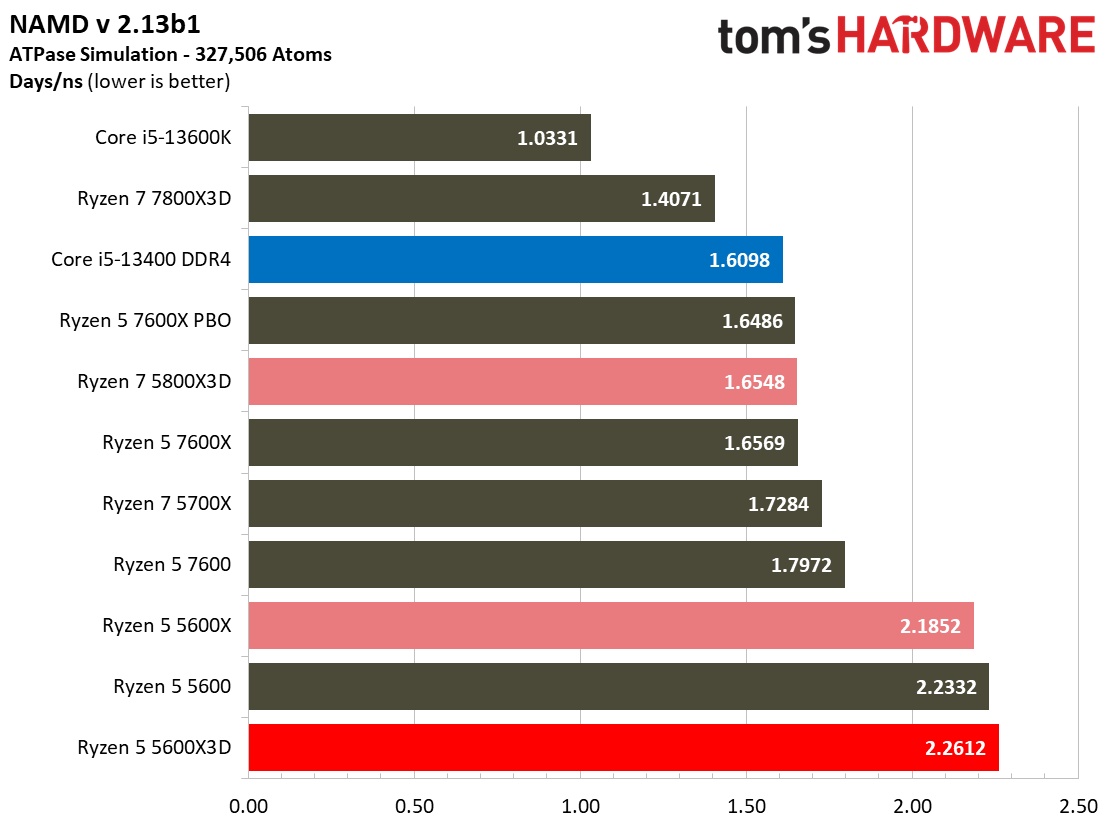
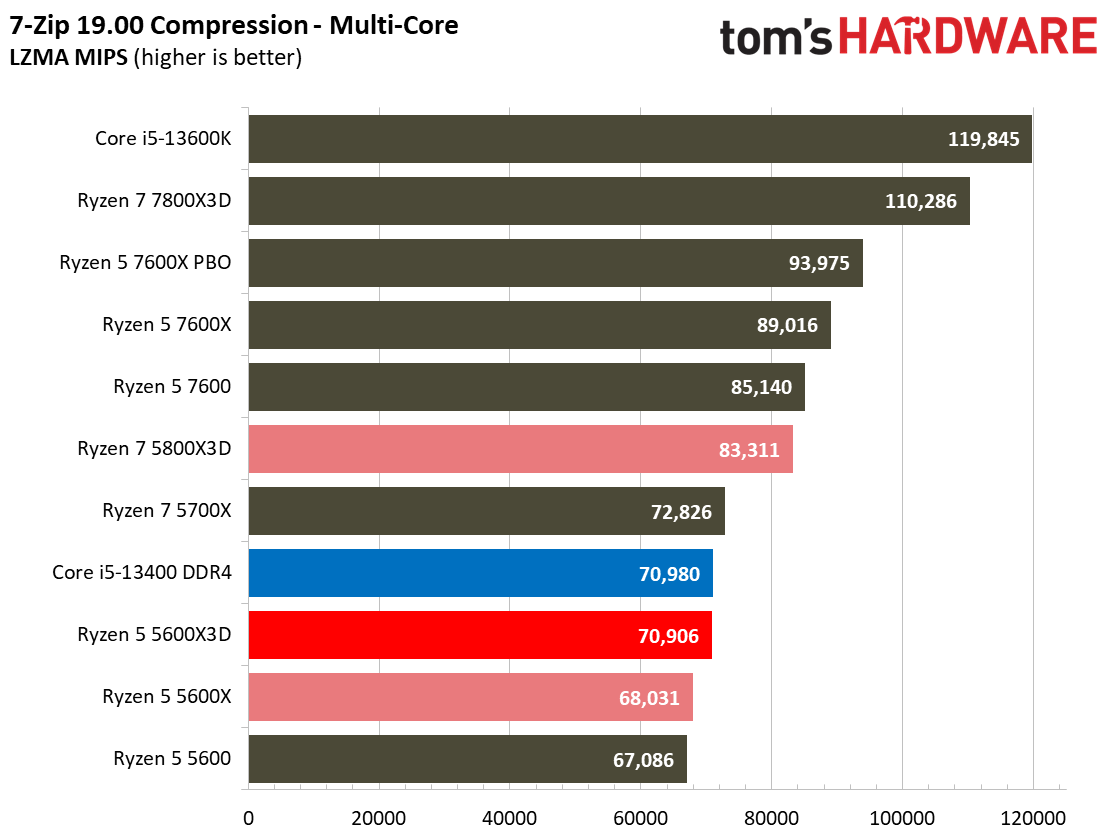
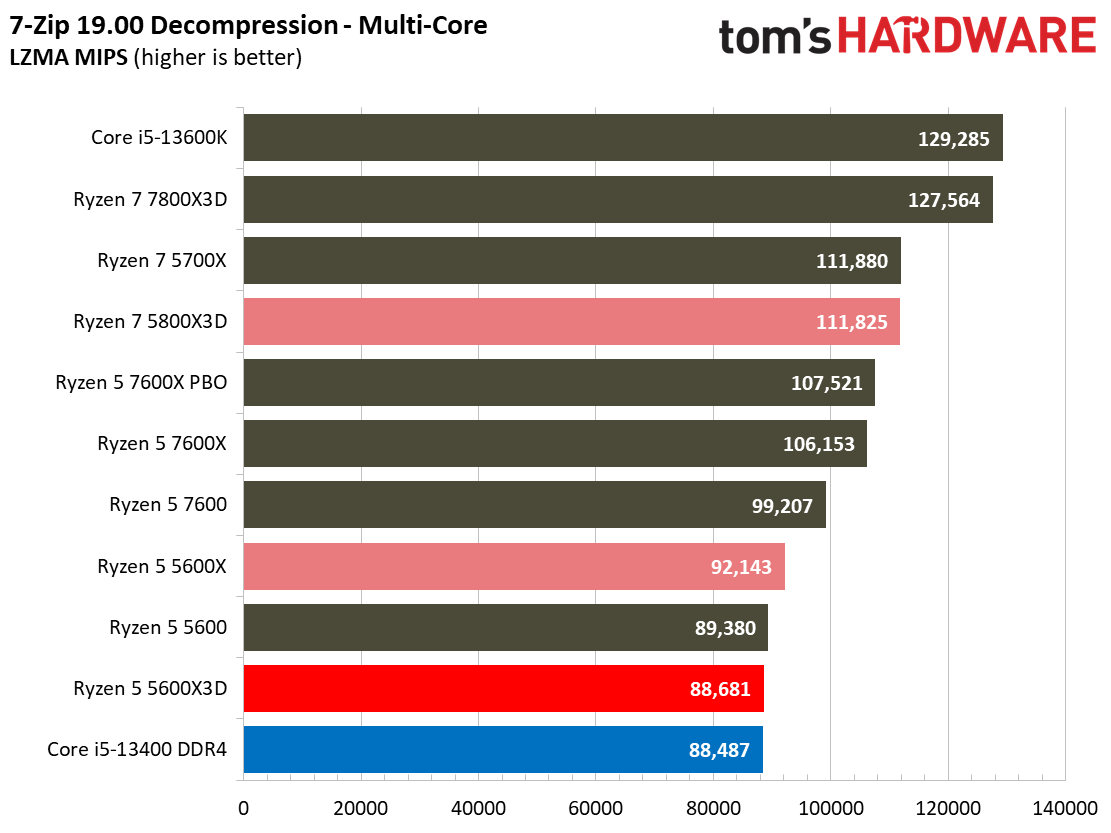
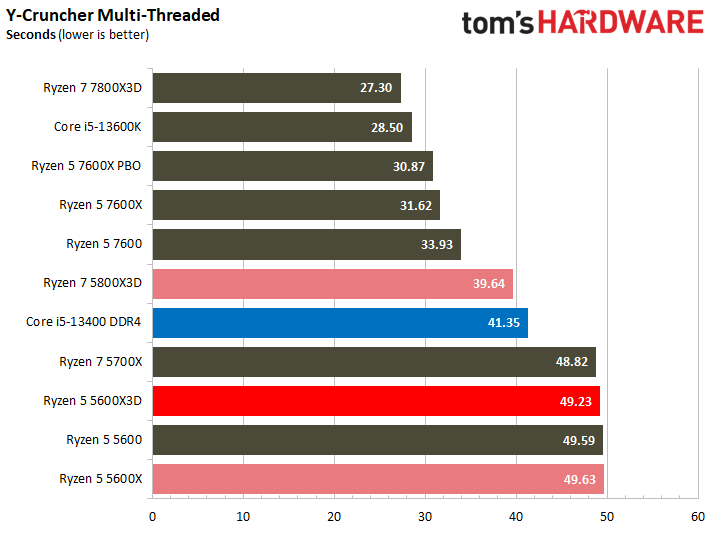
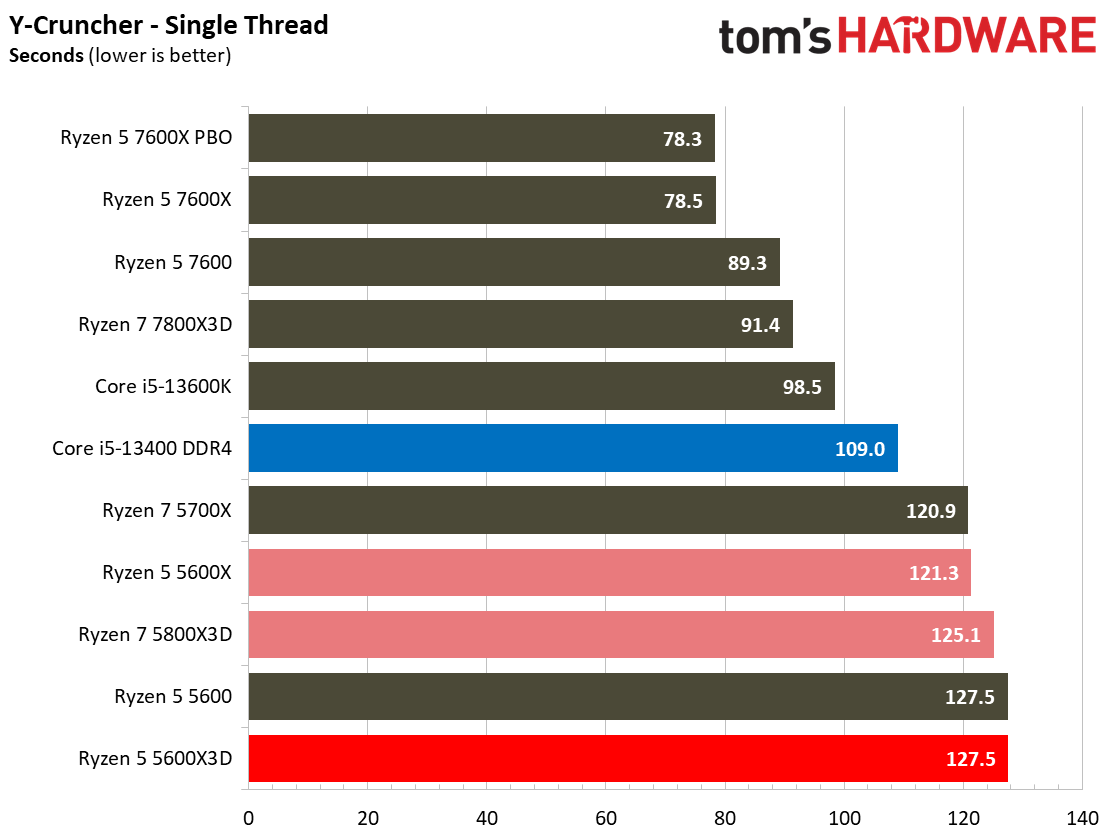
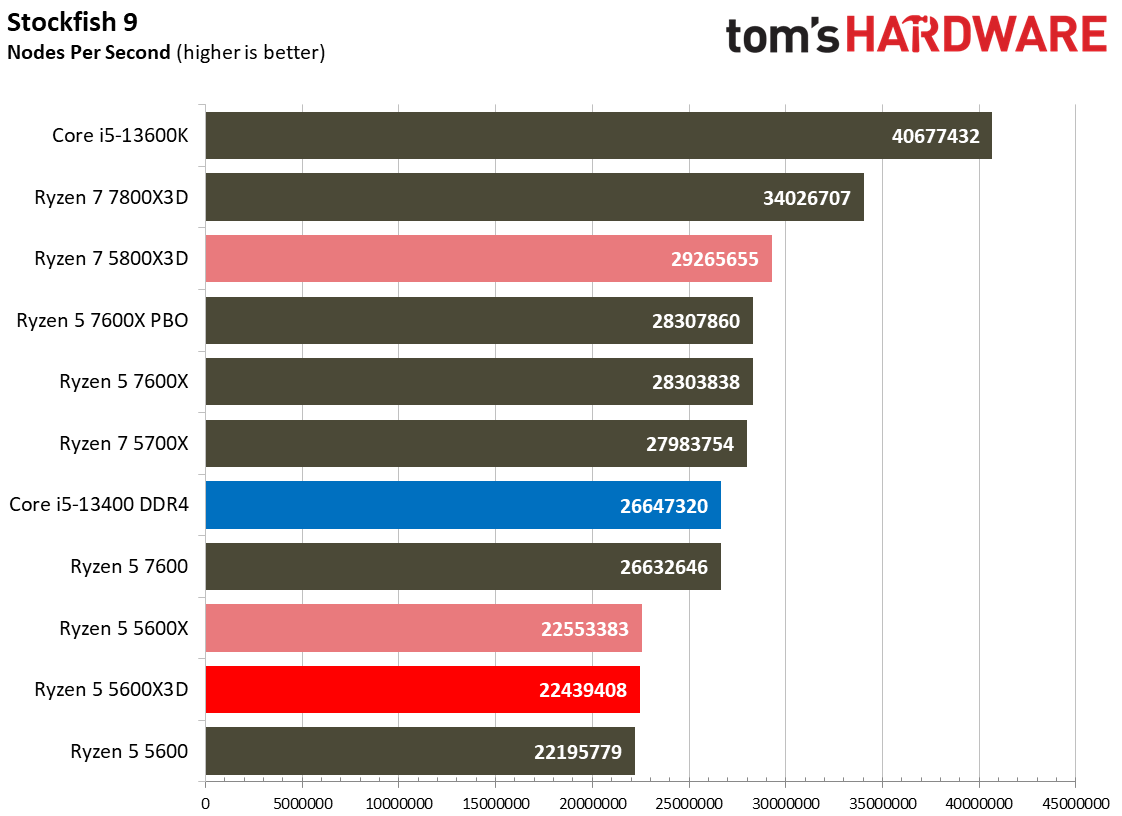
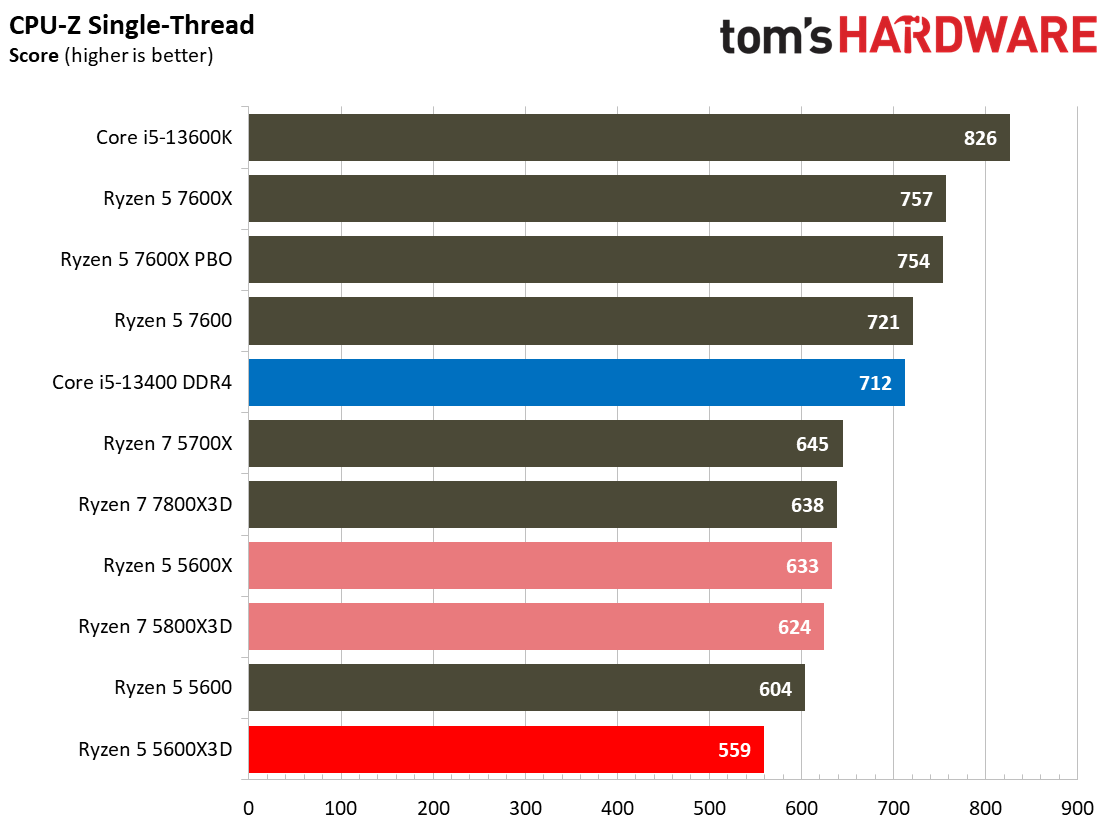
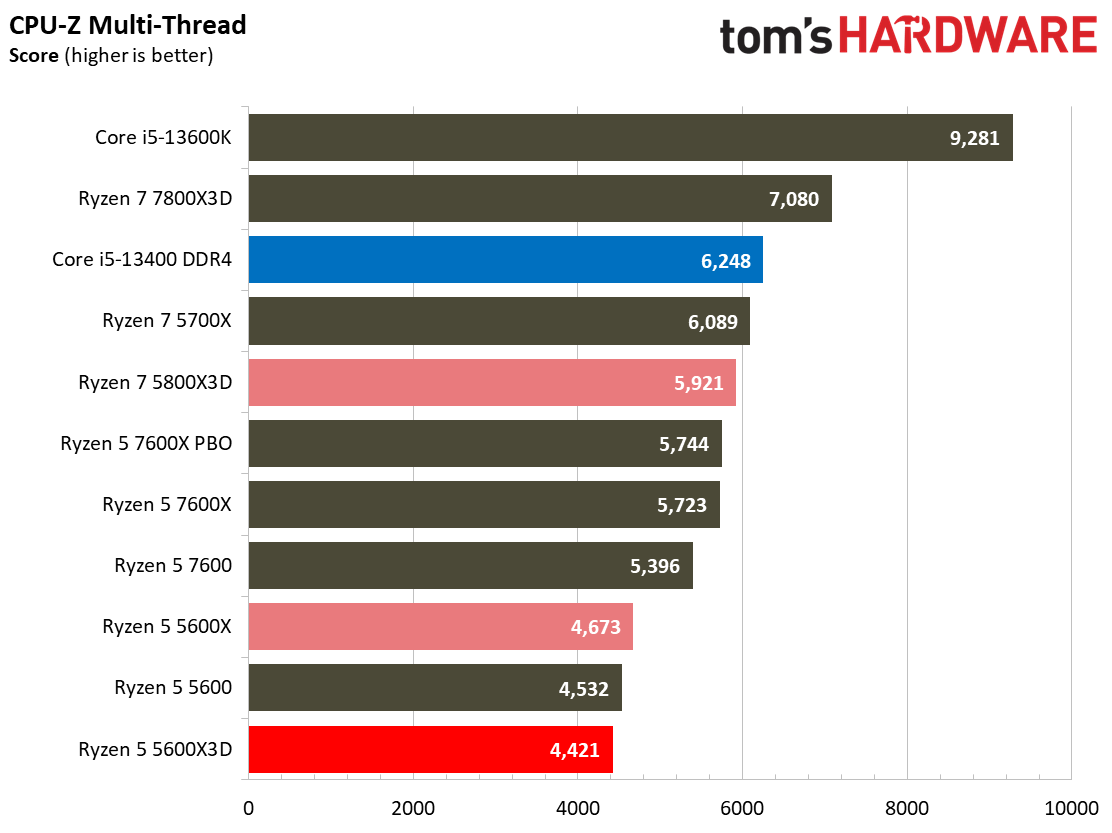
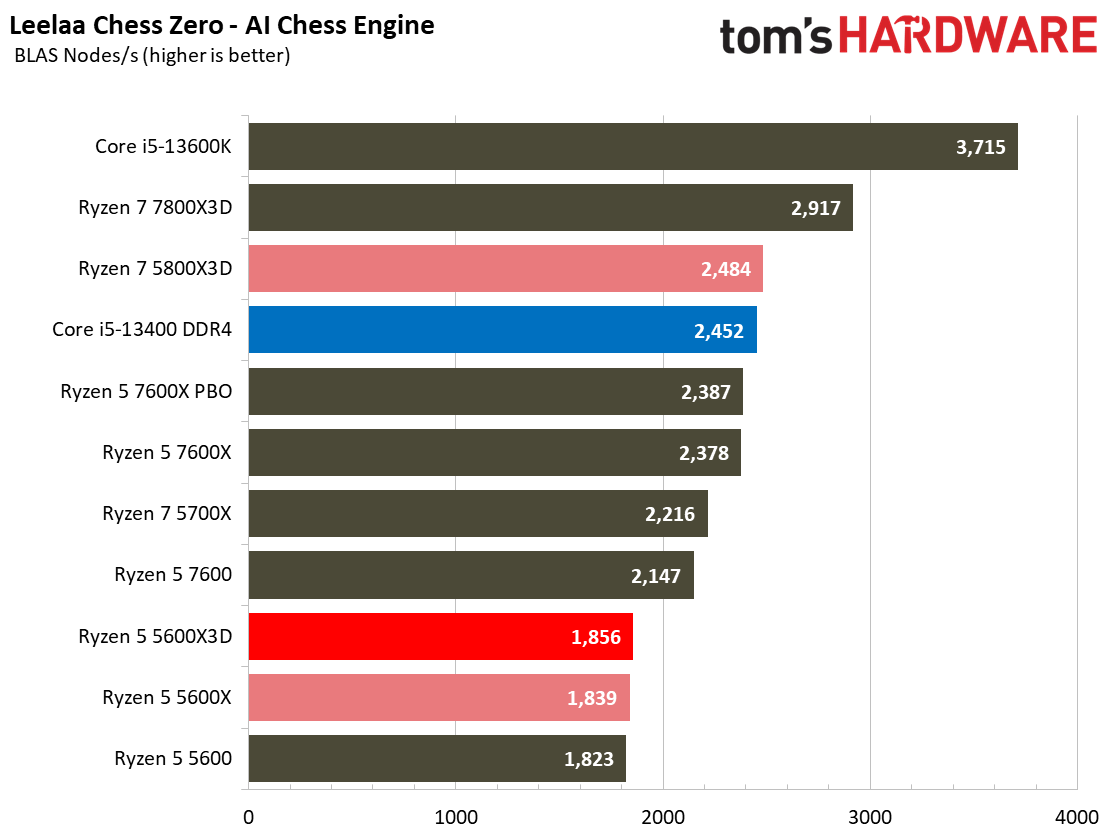
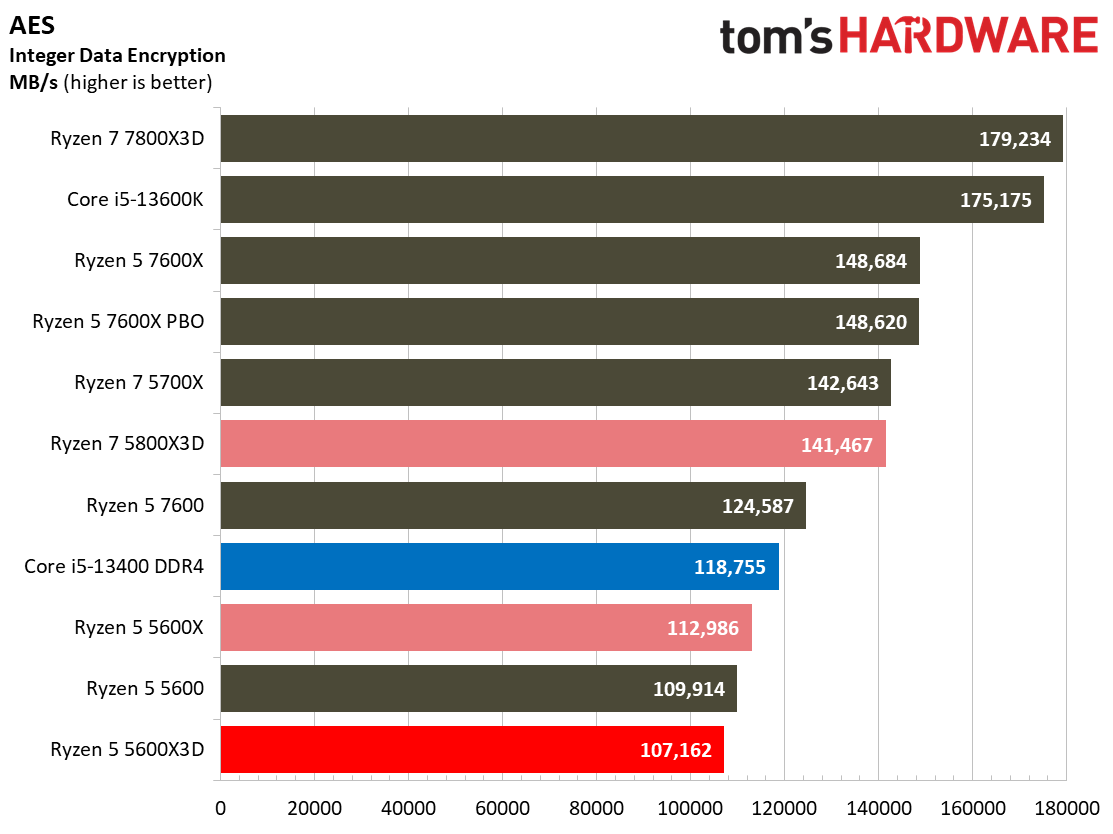
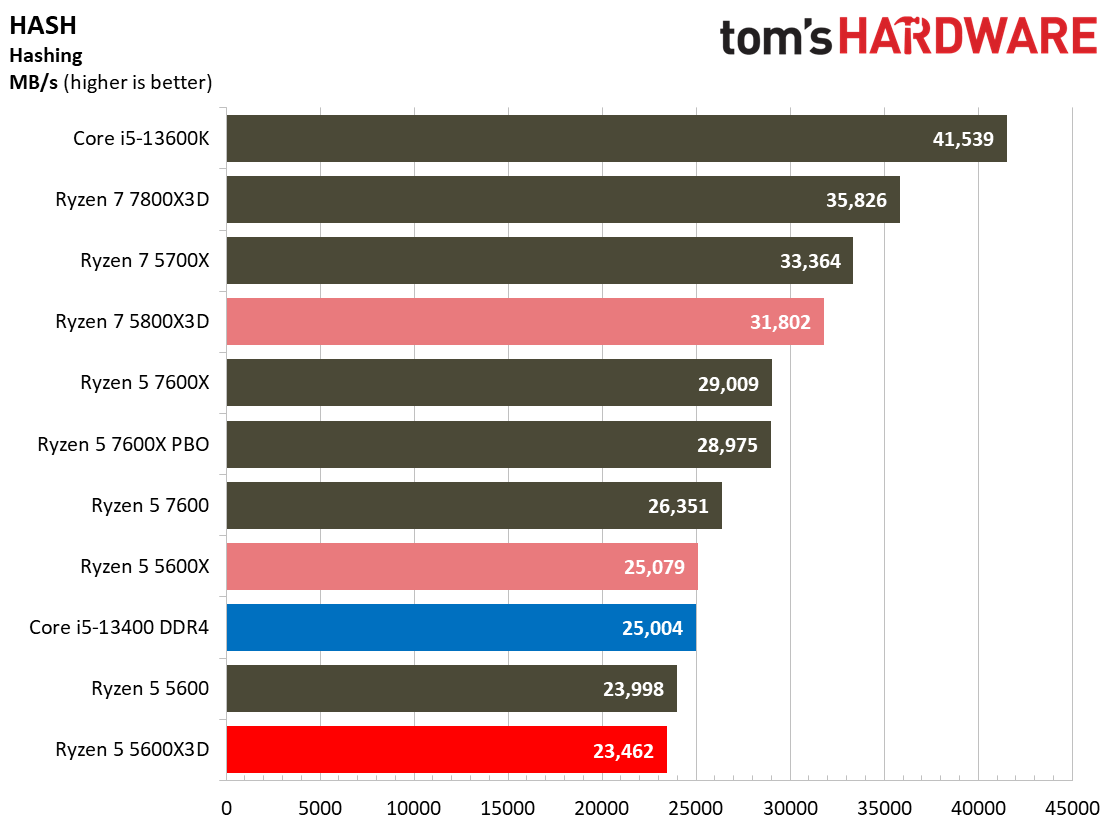
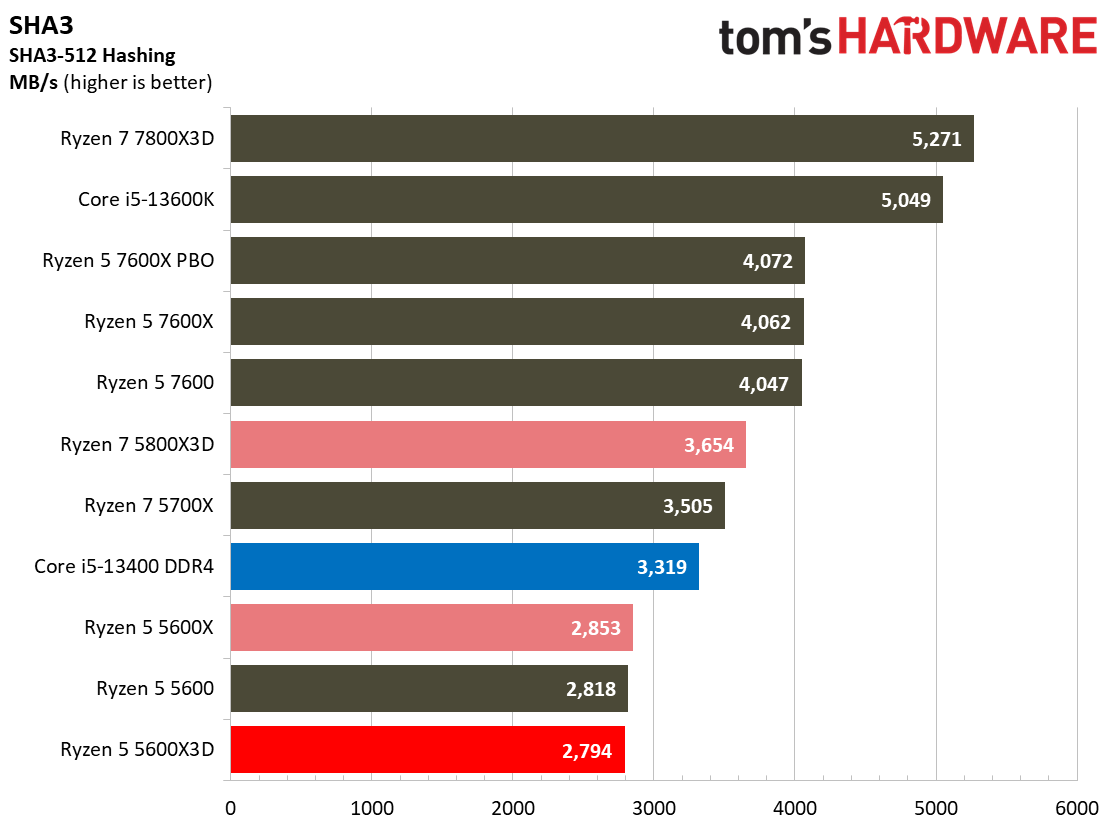
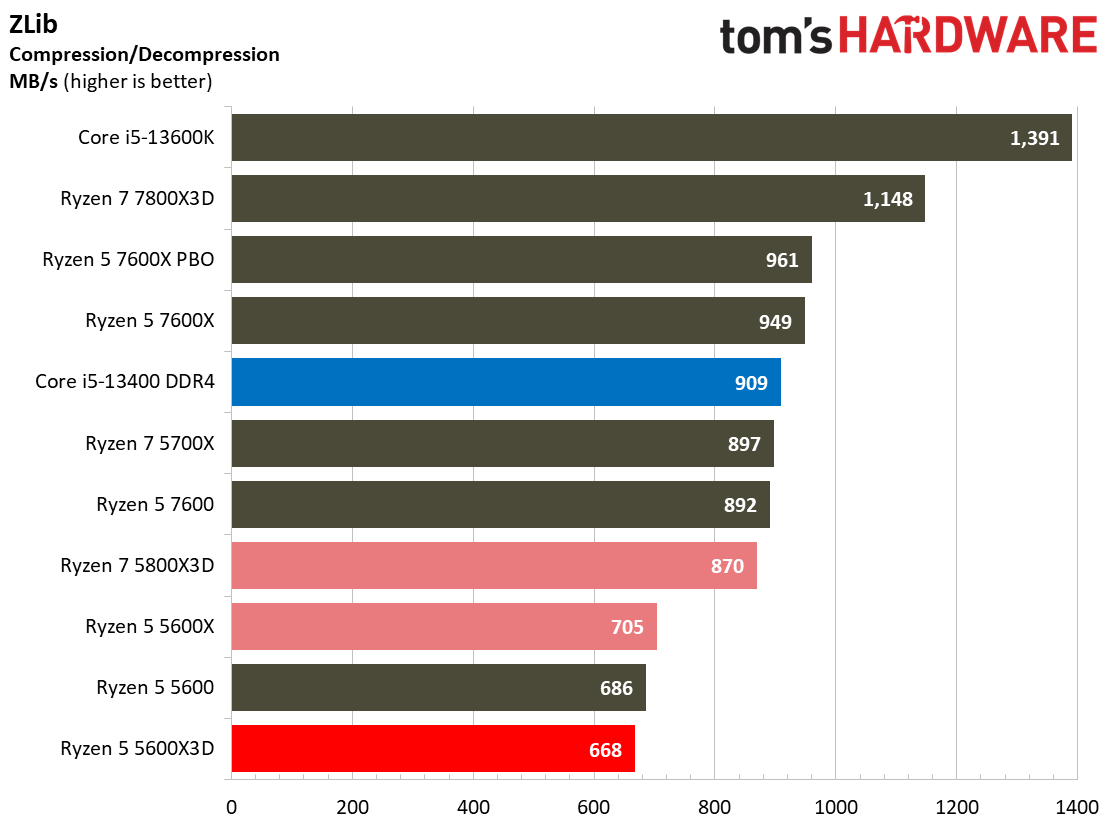
Aside from the compression/decompression tests, most of these benchmarks aren't as important for this class of processors, but we include them for the sake of completeness. These benchmarks run the gamut from the exceedingly branchy code in the LLVM compilation workload to the massively parallel molecular dynamics simulation code in NAMD to encryption and compression/decompression performance.
The demanding Y-cruncher benchmark computes Pi with the AVX instruction set and has optimizations for both Intel and AMD’s architectures. The Ryzen 5 5600X3D once more ekes out a slight win over the 5600X due to its higher TDP, which in turn allows it to sustain slightly higher all-core clocks in some situations. Those cases are rare, though, as the 5600X3D largely trails the rest of the pool in these benchmarks.
AMD Ryzen 5 5600X3D Power Consumption and Efficiency
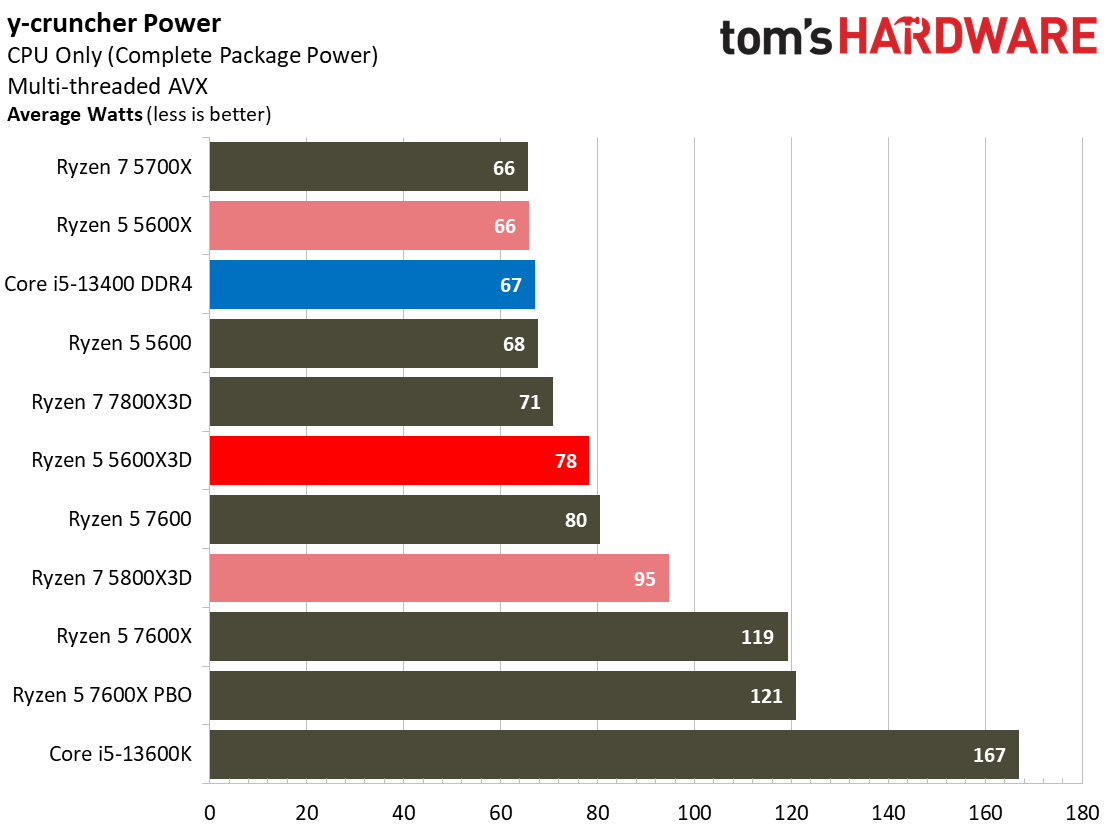
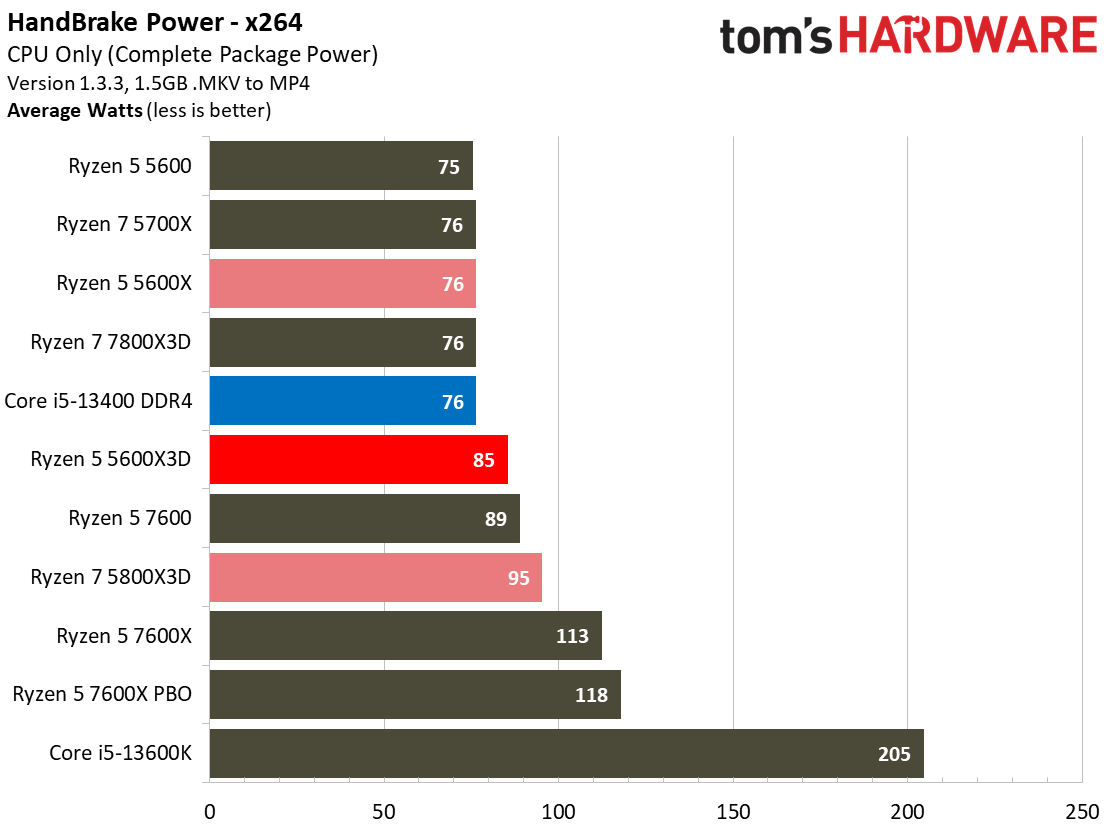
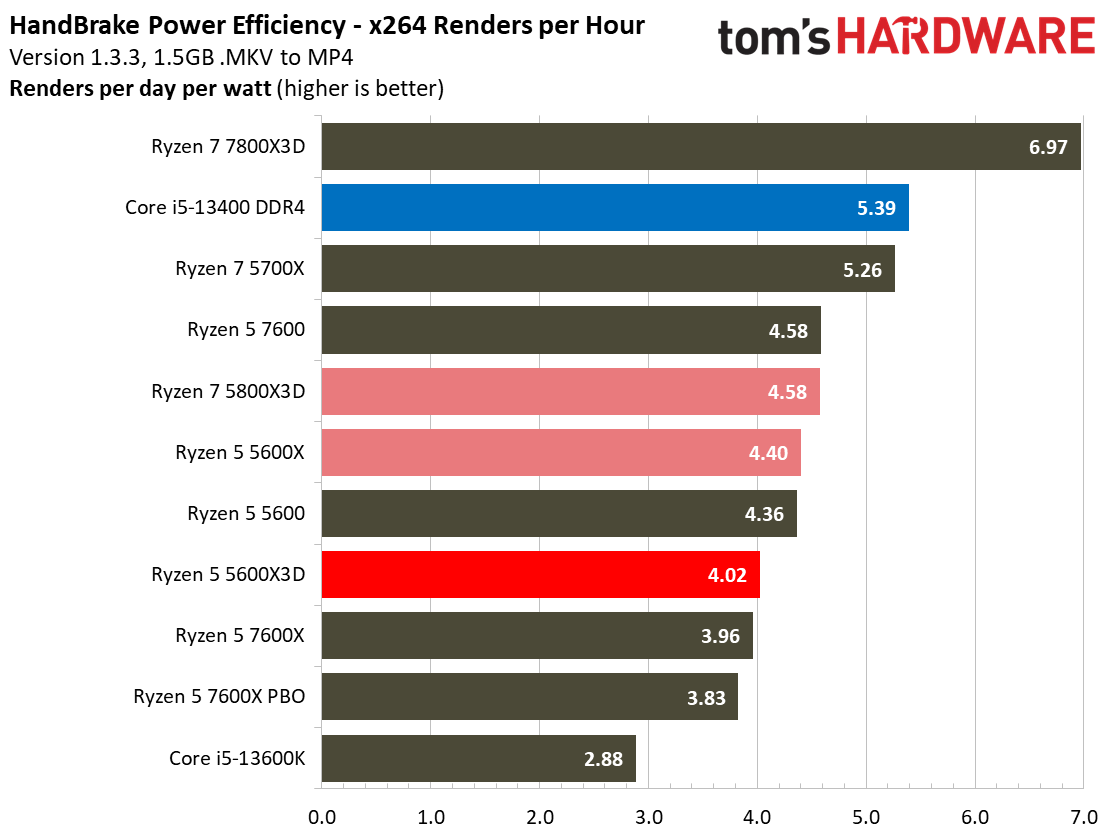
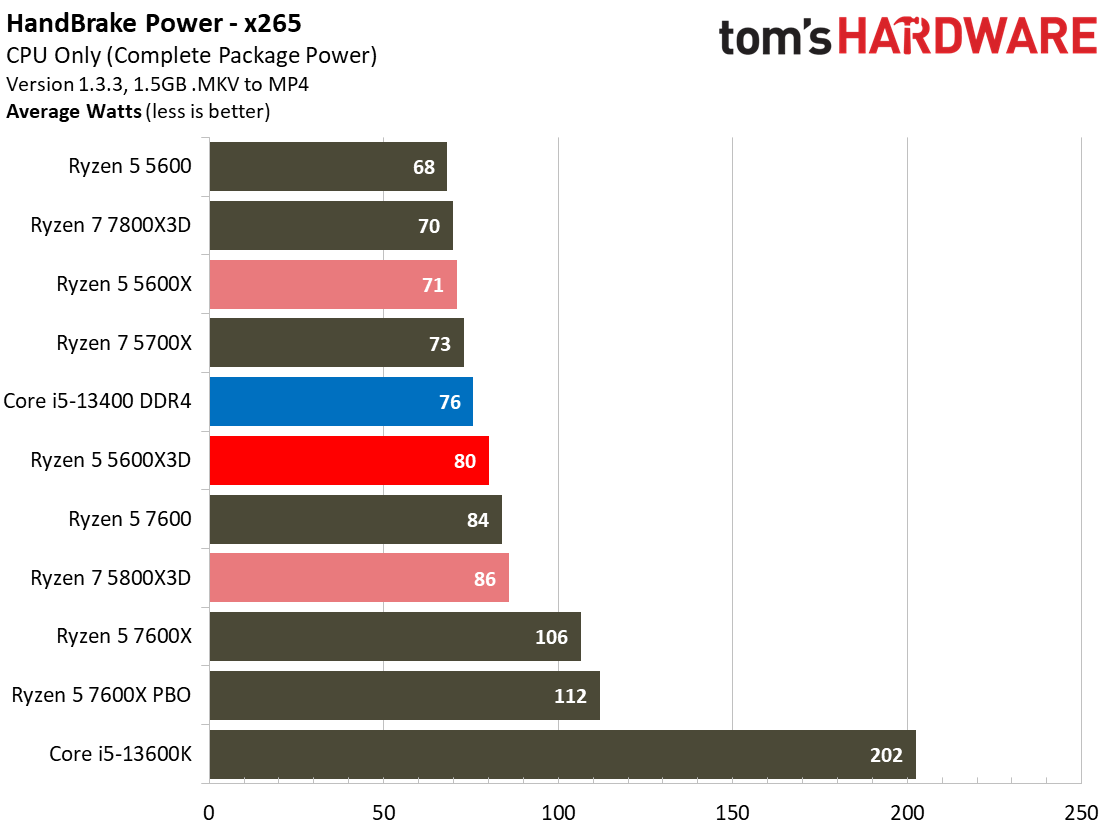
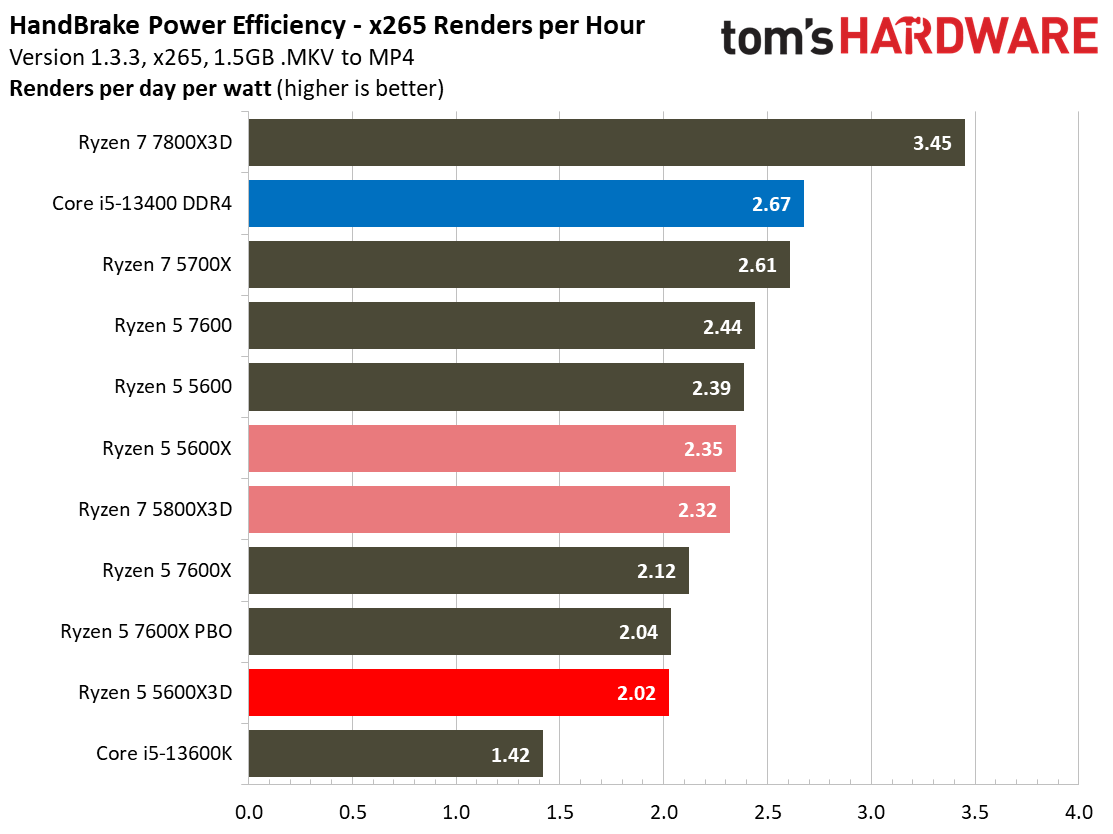
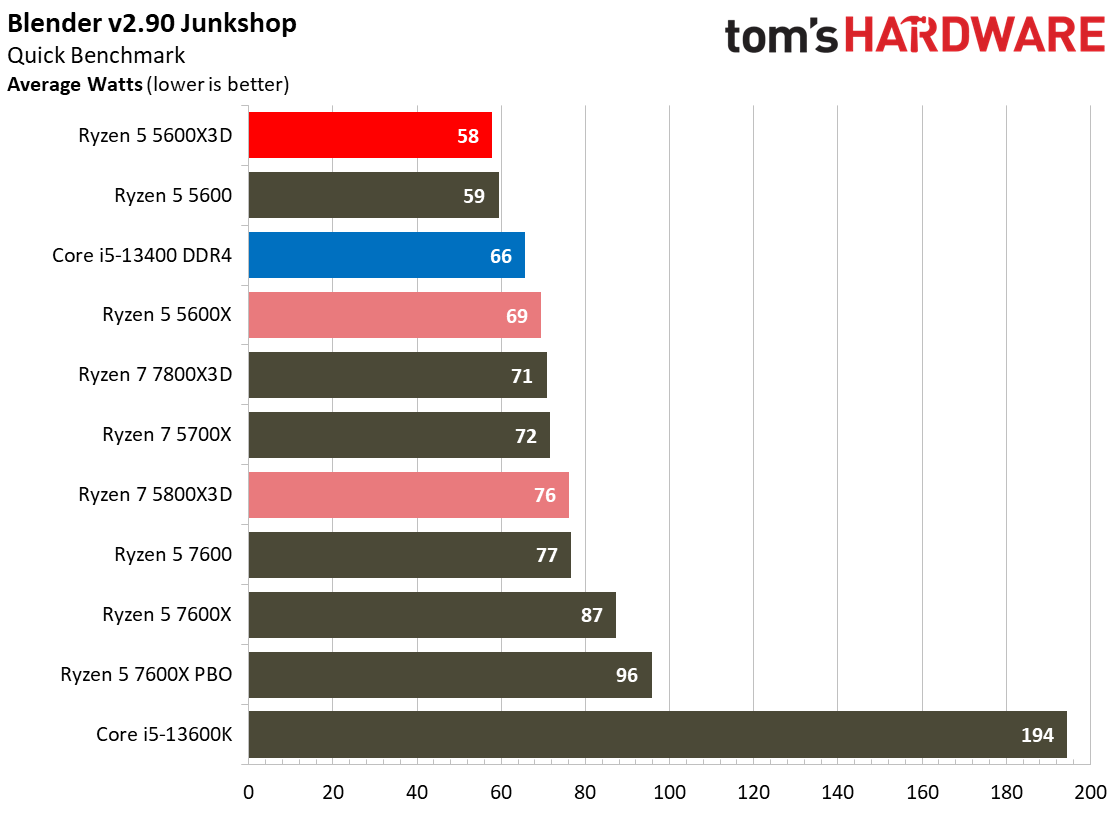
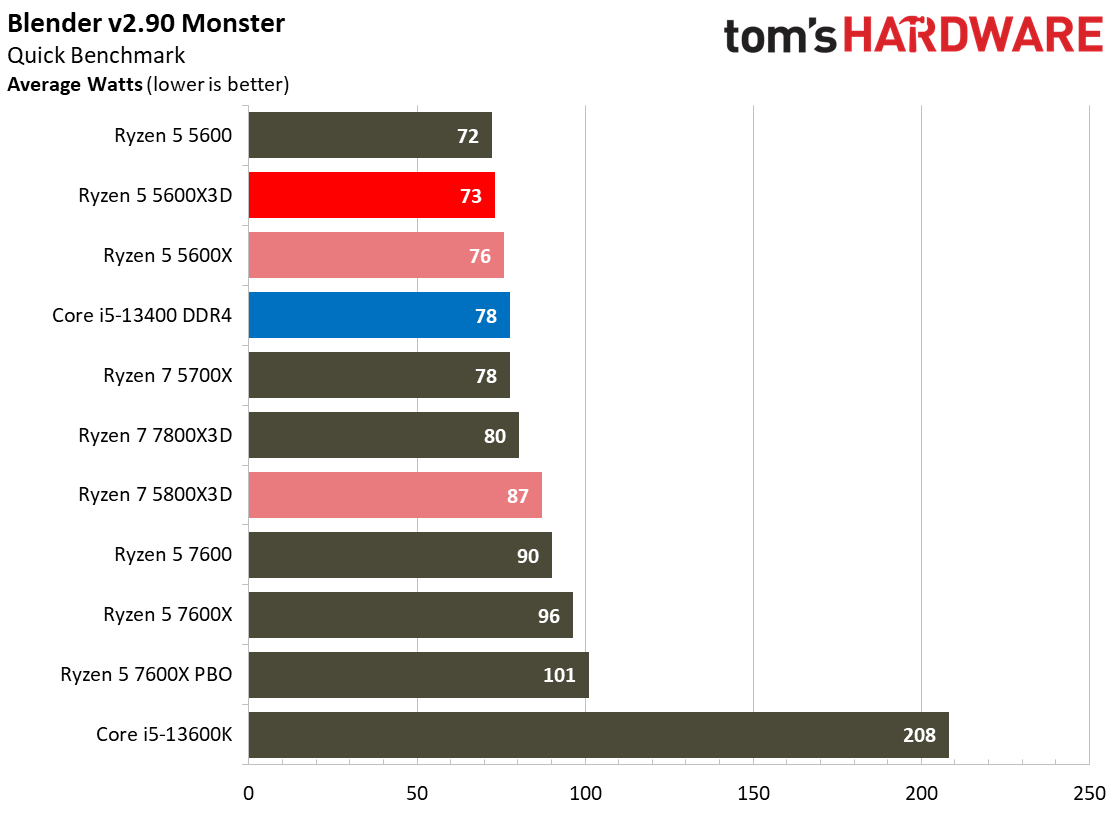
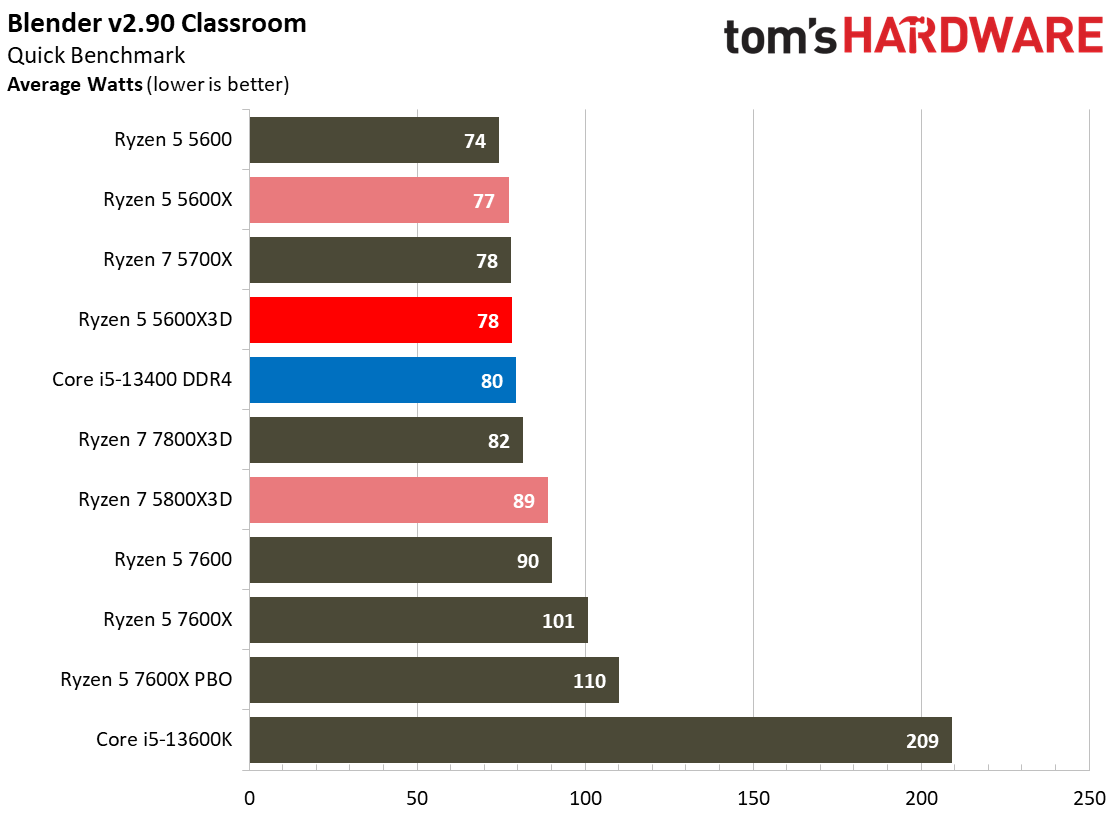
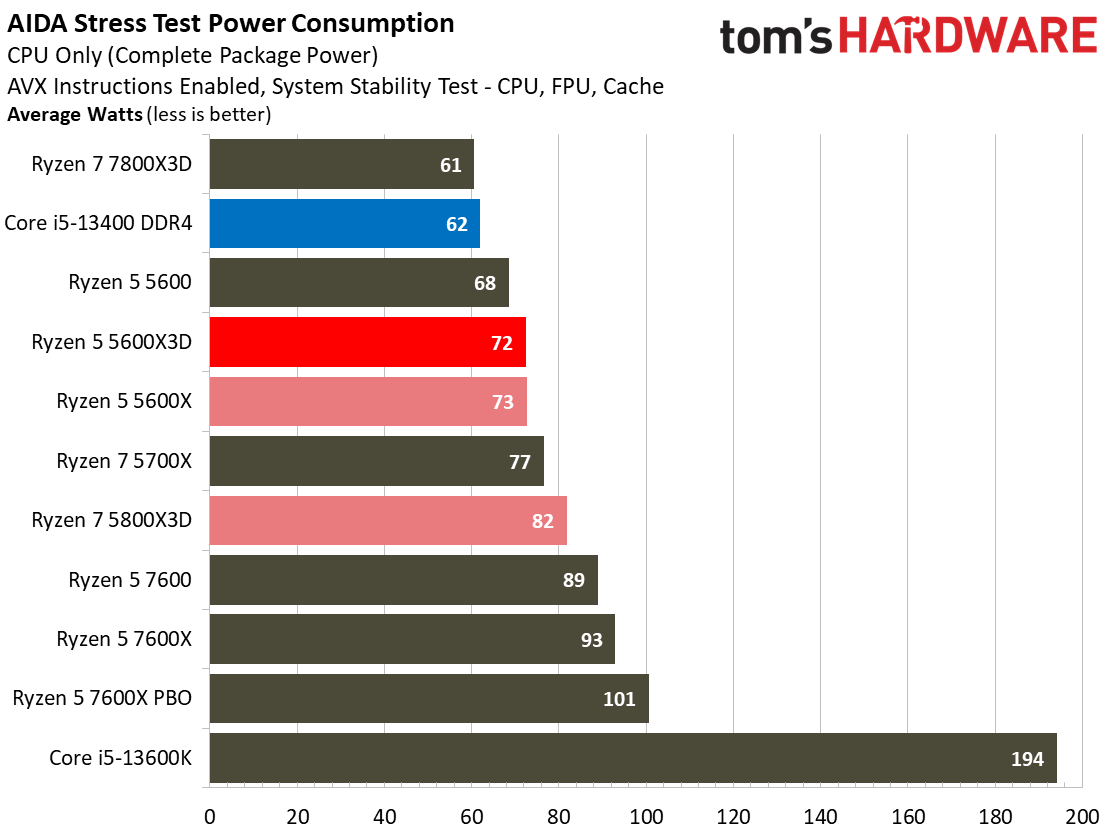
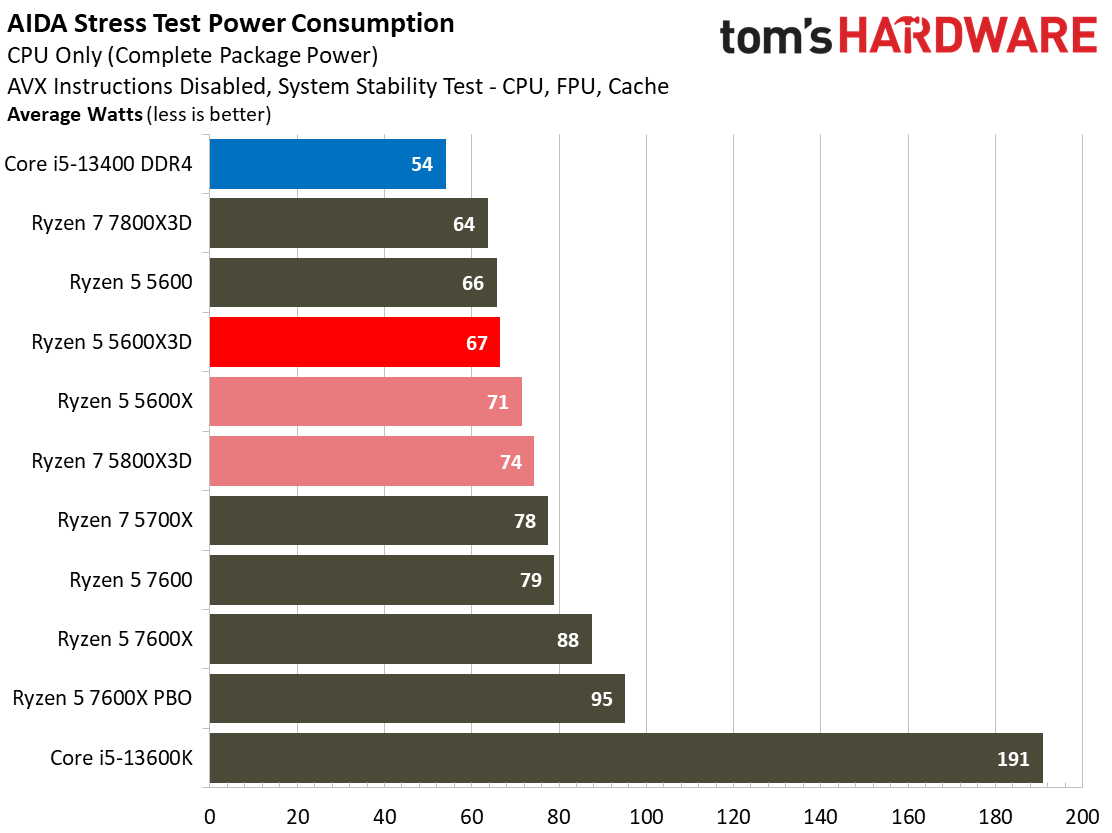
The six-core Ryzen 5 5600X3D comes with a 105W TDP rating that outstrips the 65W ratings for most of the chips in the test pool, including the eight-core Ryzen 7 5700X. In some cases, that results in the six-core Ryzen 5 5600X3D pulling more power than the 65W six-core Ryzen 5 5600X despite the former's lower boost clock rates, as evidenced by the HandBrake x264 workload. Here, the 5600X3D is actually slightly faster than the 5600X, but the higher power consumption results in a loss in the x264 renders-per-day efficiency metric.
The Ryzen 5 5600X3D's performance generally lags the rest of the test pool, so it scores poor marks in the efficiency metrics. The 5600X3D also draws more power and is less efficient than the Core i5-13400 in several workloads.
Some of the poor power efficiency stems from the higher TDP paired with the chips' comparatively lower performance, but we also know that most motherboard vendors haven't tuned for the 5600X3D because it was effectively a canceled processor. Instead, it only has a basic level of enablement.
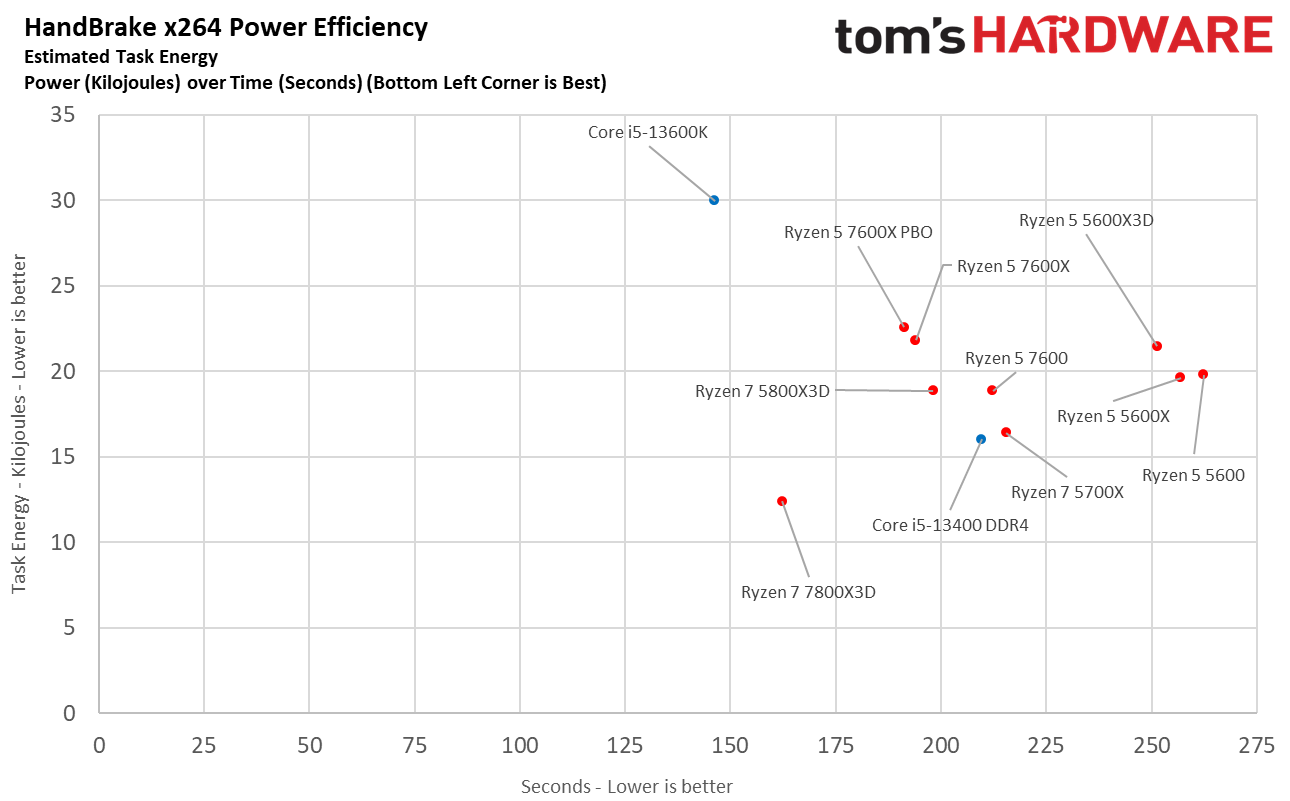
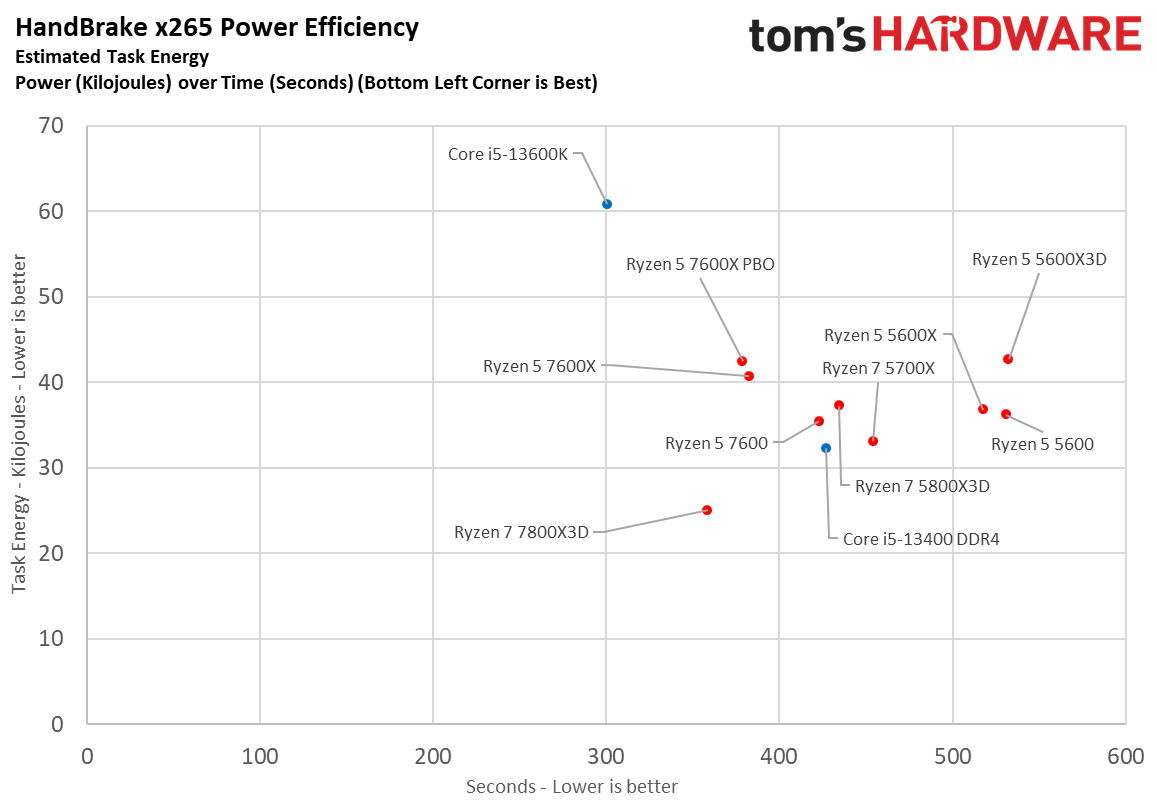
Here we take a slightly different look at power consumption by calculating the cumulative energy required to perform x264 and x265 HandBrake workloads, respectively. We plot this 'task energy' value in Kilojoules on the left side of the chart for the Y-axis, with time taken as the X-axis.
These workloads are comprised of a fixed amount of work, so we can plot the task energy against the time required to finish the job, thus generating a really useful power chart. Bear in mind that faster compute times and lower task energy requirements are ideal. That means processors that fall the closest to the bottom left corner of the chart are the best, in terms of efficiency.
As you would expect, given the prior efficiency results, the Ryzen 5 5600X3D's power consumption-vs-performance isn't as desirable as the other 7nm Zen 3-powered Ryzen 5000 processors, and it trails the 5nm Zen 4 Ryzen 7000 chips by an even larger margin.
AMD Ryzen 5 5600X3D Test Setup and Overclocking
We're told that motherboard vendors have only enabled basic support for the Ryzen 5 5600X3D but didn't have samples to fine-tune the BIOS. As such, performance could vary with different motherboards quite a bit. As mentioned, the Ryzen 5 5600X3D doesn't support overclocking via the CPU multiplier, so you can't change the core clocks via that method. You also cannot adjust the power limits (PPT, TDC, EDC) or CPU voltage. Additionally, the chip doesn't support the auto-overclocking Precision Boost Overdrive (PBO) feature, and you can't undervolt or underclock.
The 5600X3D fully supports overclocking the memory and Infinity Fabric, but we could only reach DDR4-3600 with the fabric dialed in at 1800 MHz. This setting allows us to run the memory in the desired low-latency 'coupled' (1:1 ratio) mode. You can get higher with uncoupled memory, but that results in less performance in games. We gained less than 1% in gaming performance from overclocking the memory, and have had similar results with other X3D processors.
Several motherboard vendors offer custom overclocking options for the Ryzen 5000X3D processors, but these do come with an outsized level of risk, even for overclocking — AMD has prevented these chips from all forms of overclocking due to the limitations of the cache chiplet. The 5600X3D is truly a limited edition chip, so we chose not to risk losing our only irreplaceable sample by testing the ad-hoc overclocking methods for 5000X3D chips.
We test Intel processors with the power limits fully removed for our standard measurements, so those chips run beyond the 'recommended' power settings but remain within warranty. We used DDR4 memory for testing, as DDR5's pricing premium isn't as suitable for this class of chip.
Microsoft has advised gamers to disable several security features to boost gaming performance. As such, we disabled secure boot, virtualization support, and fTPM/PTT on all systems for maximum performance. You can find further hardware details in the table below.
We tested the Ryzen 5 5600X3D in two configurations:
-
Ryzen 5 5600X3D: Corsair H115i 280mm water cooler, default power limits, DDR4-3200 in Coupled mode
Ryzen 5 5600X3D DDR4-3600: Corsair H115i 280mm water cooler, default power limits, DDR4-3600 in Coupled mode
The limited-edition Ryzen 5 5600X3D is almost exactly what you’d expect from a smaller Ryzen 7 5800X3D model, providing 95% of the gaming performance of its pricier counterpart for 20% less cash. That also equates to Intel-beating gaming performance that sets a new bar for mid-range chips. However, this specialized processor is specifically optimized for gaming, so it trails Intel’s competing Core processors in productivity applications.
Below, we have the geometric mean of our gaming test suite at 1080p and 1440p and a cumulative measure of performance in single- and multi-threaded applications. We conducted our gaming tests with an Nvidia RTX 4090, so performance deltas will shrink with lesser cards and higher resolution and fidelity settings. This is especially important to remember with these lower-end processors as they will be paired with lower-end GPUs.
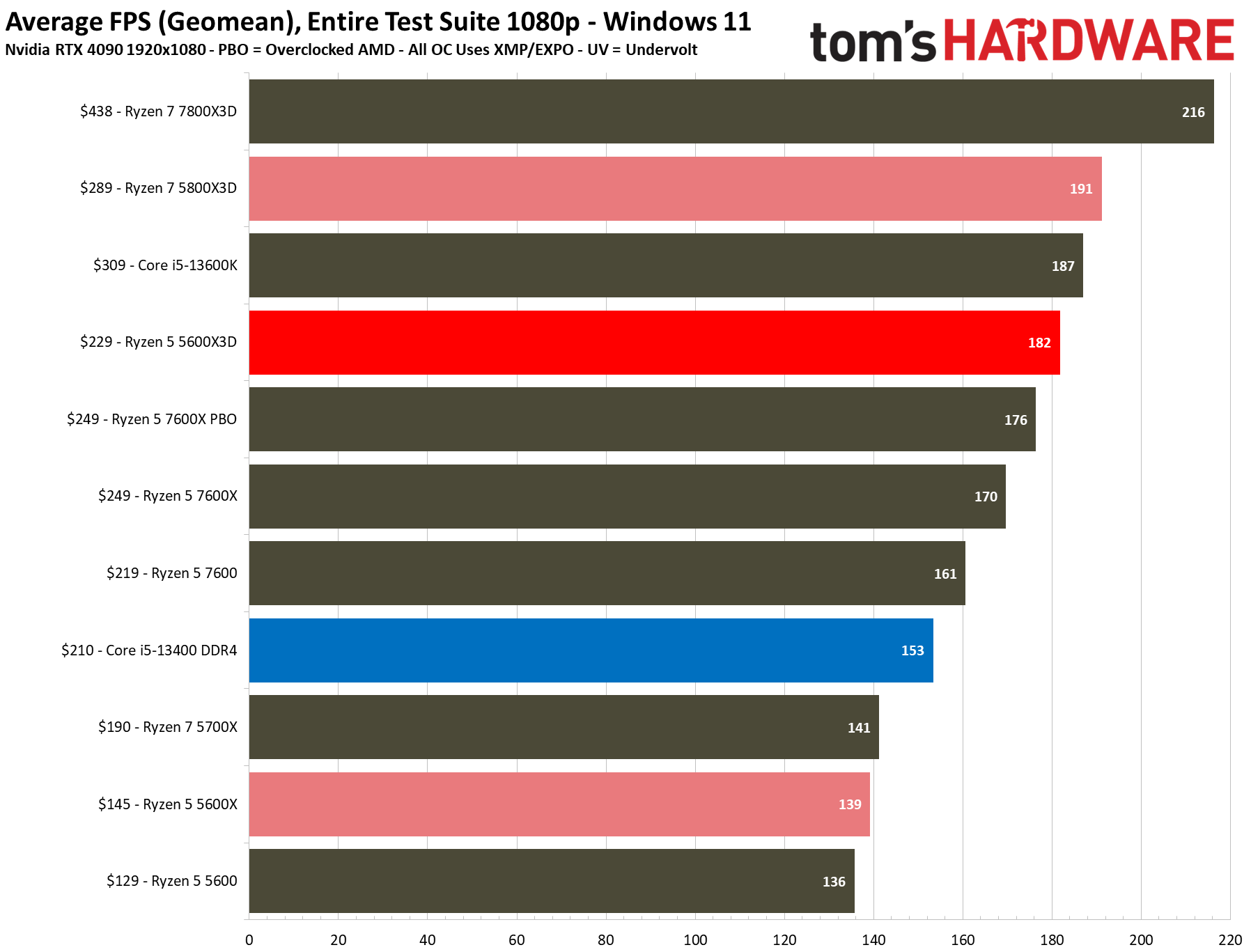
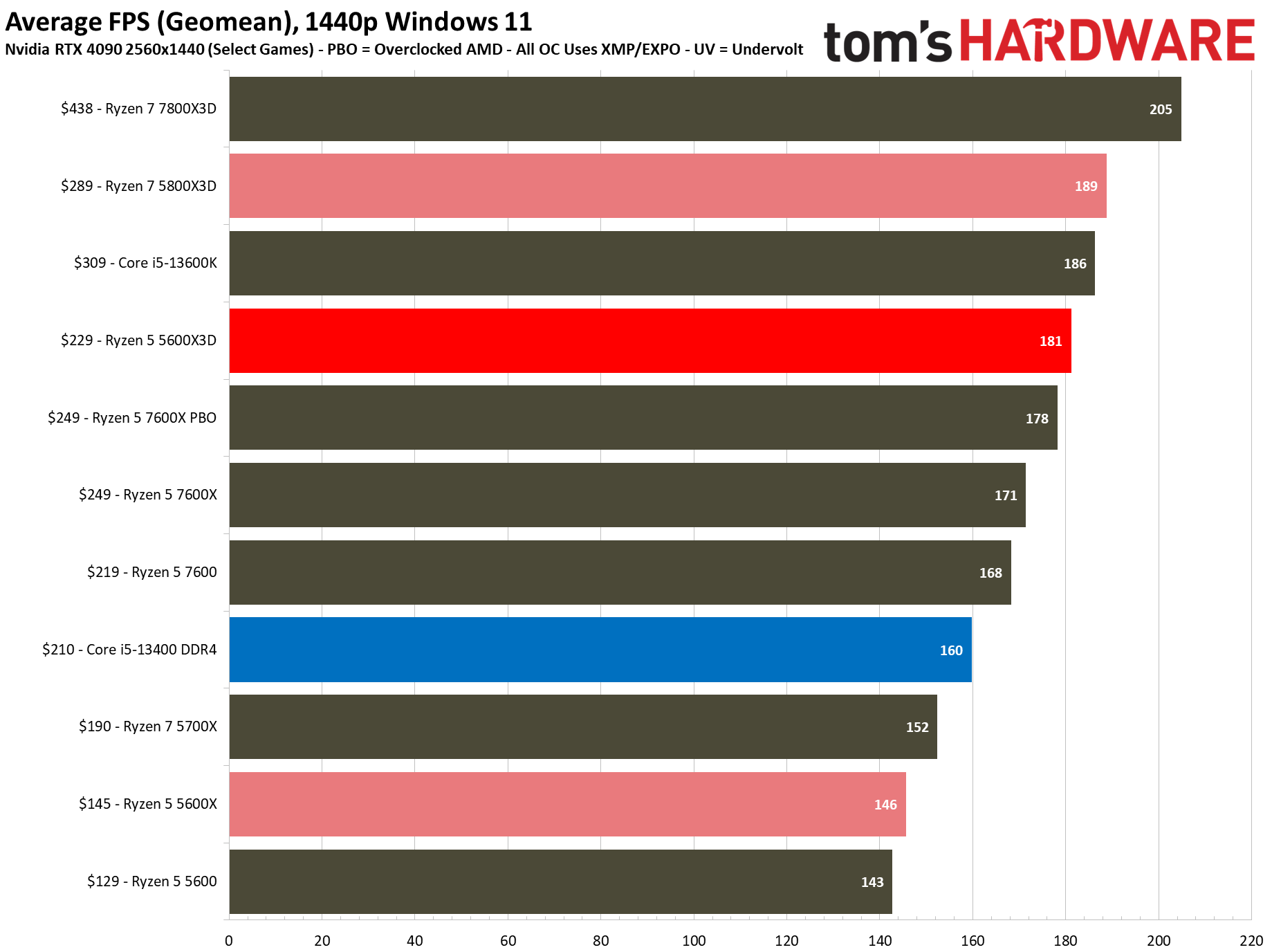
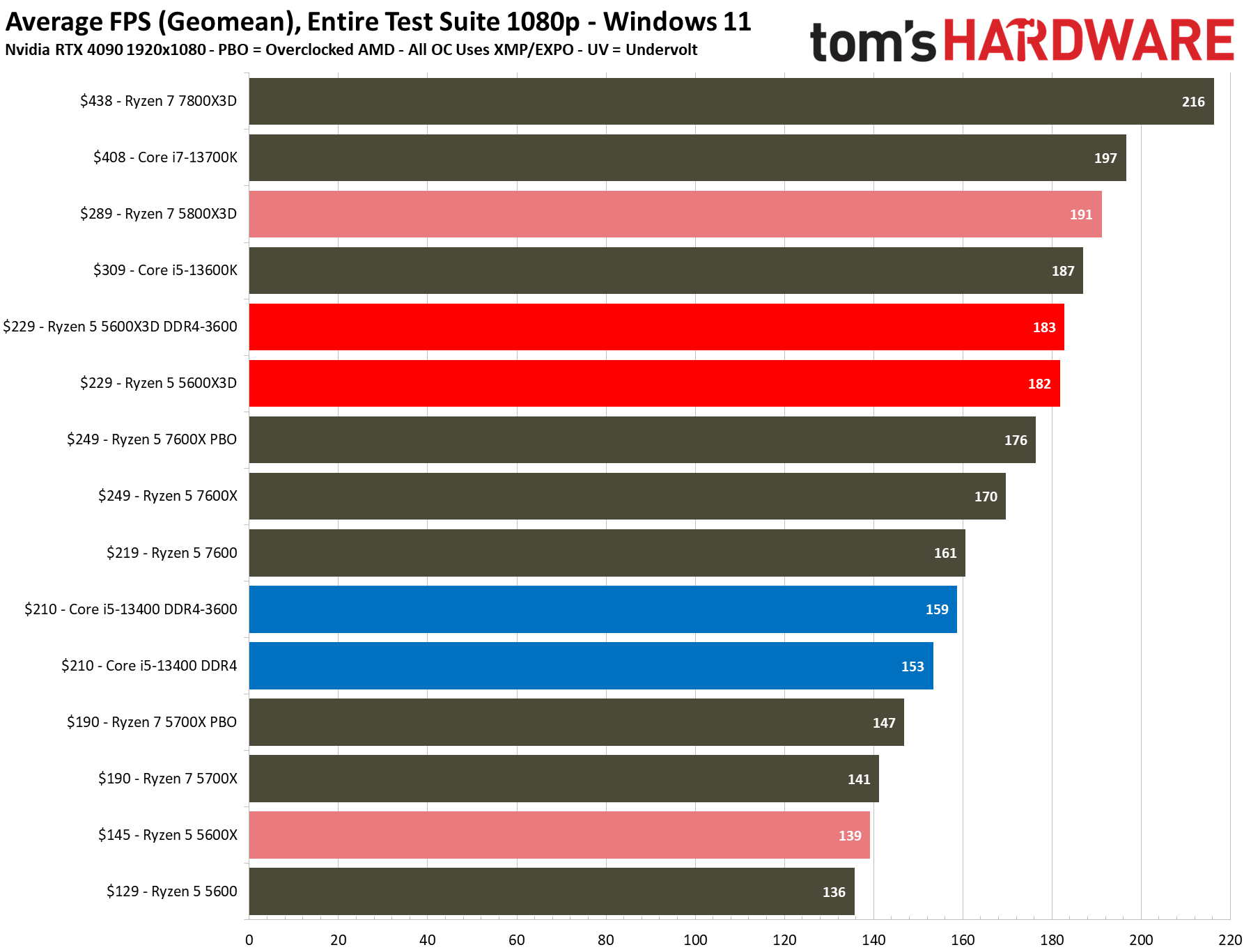
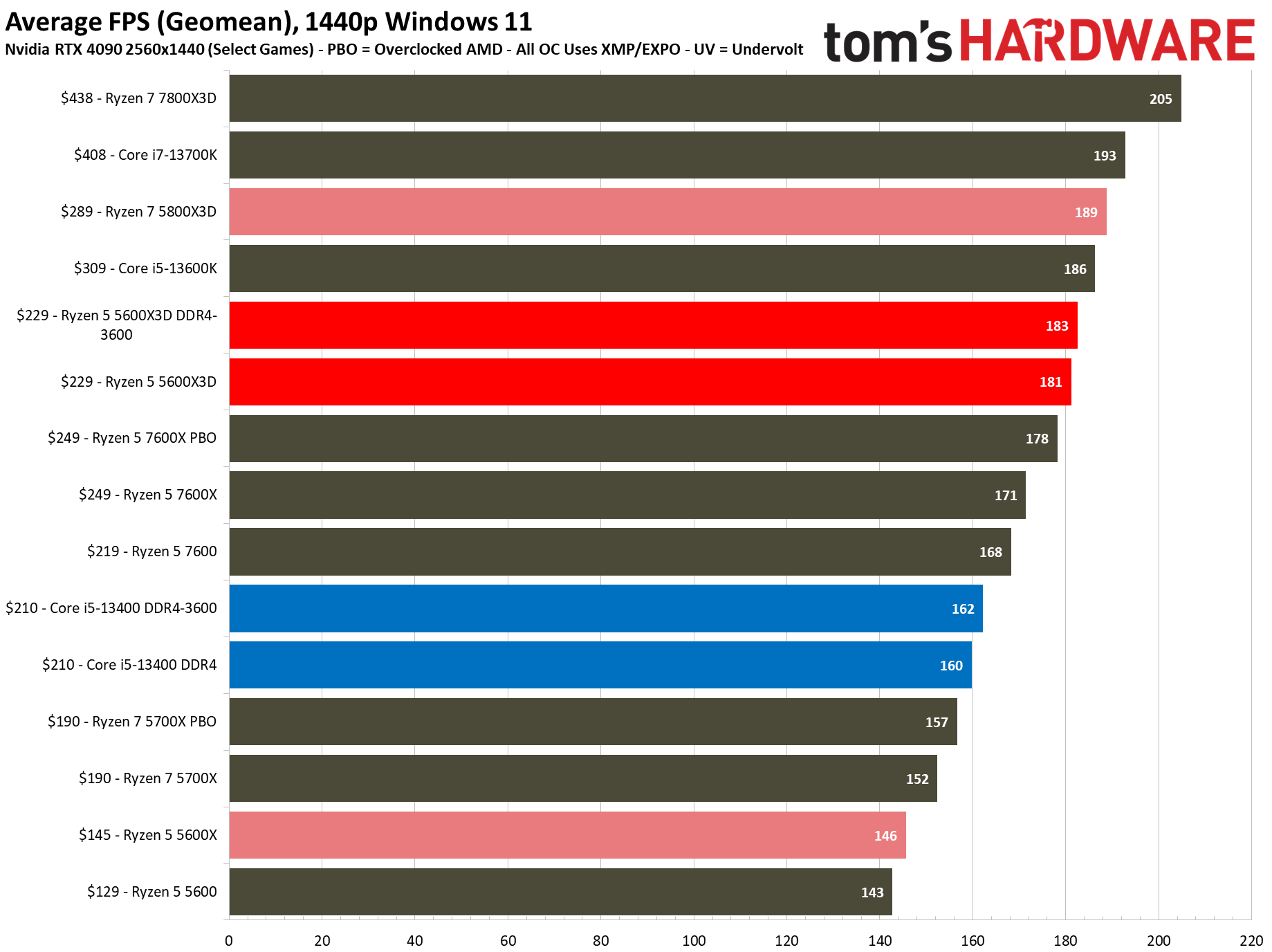
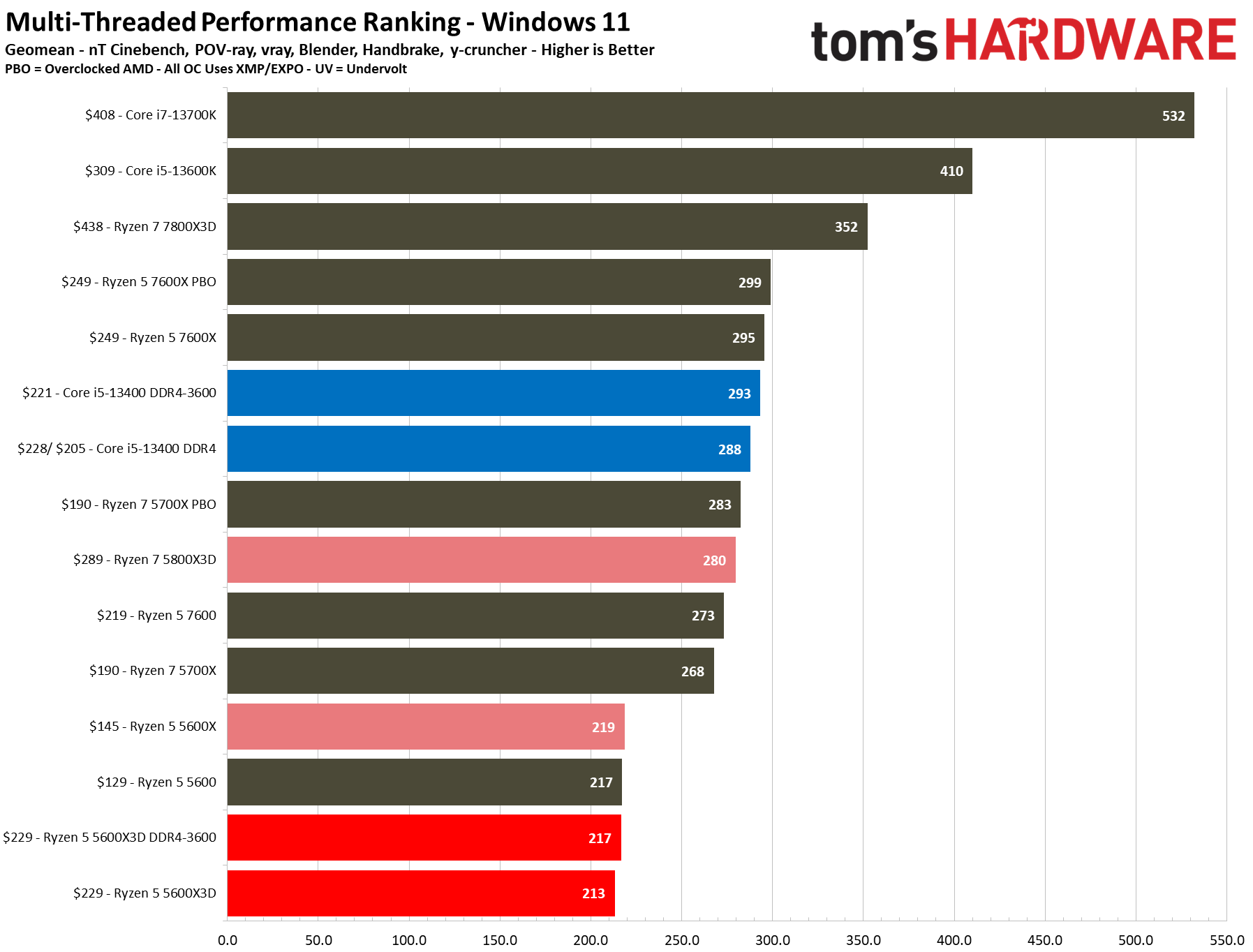
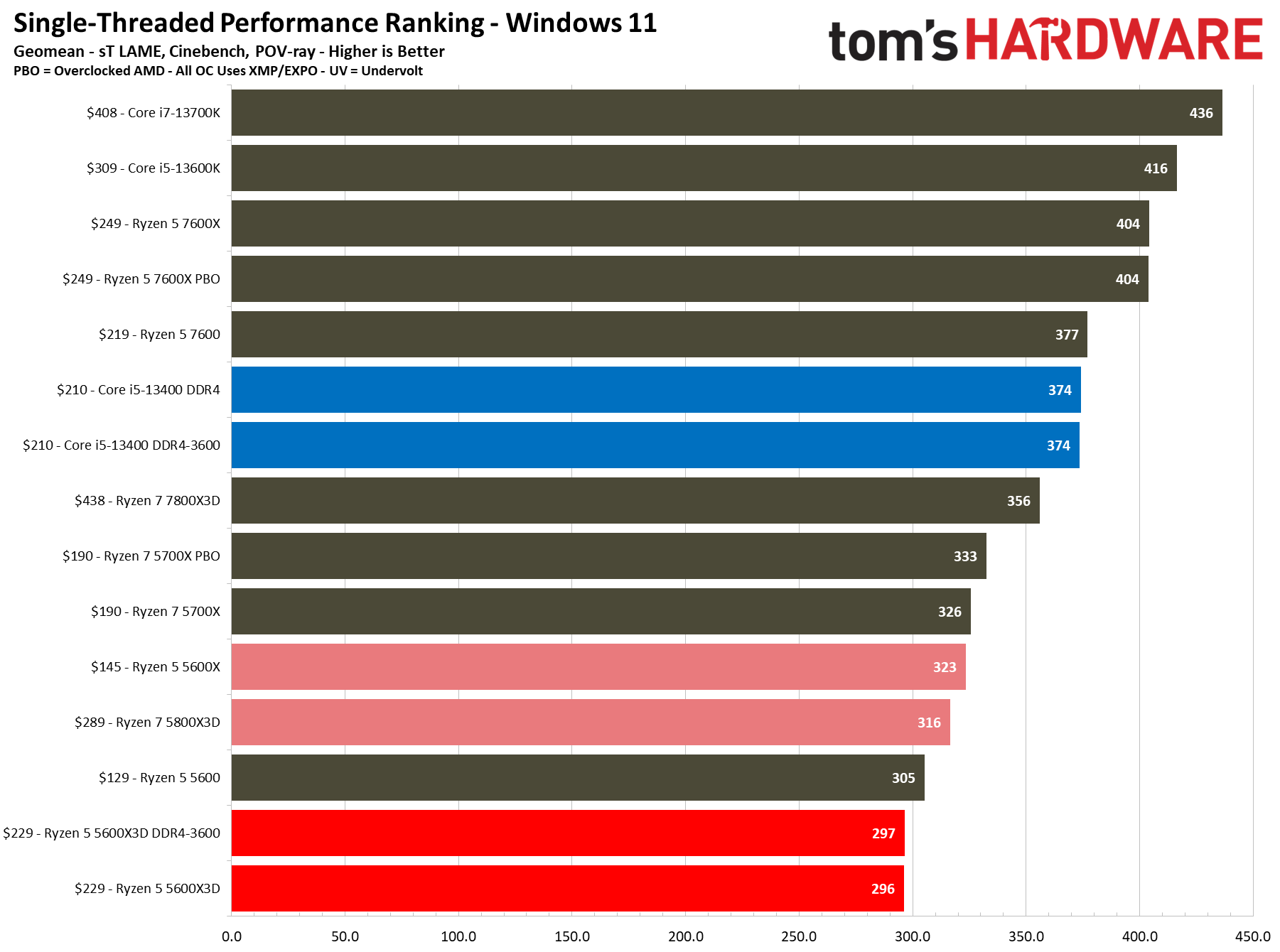
The Ryzen 5 5600X3D is ~20% faster than the Core i5-13400 in our cumulative measure of 1080p gaming, and it’s also faster than all the standard Zen 3 and Zen 4 processors, sans the Ryzen 7 5800X3D. You’ll have to step up to the much more expensive Ryzen 7000X3D or an expensive K-series Intel processor to find faster gaming performance. Head to our gaming page for the full title-by-title breakdown.
The Ryzen 5 5600X3D is optimized for gaming, but the 3D V-Cache tech results in lower clock speeds that hamper performance in productivity applications. The chip also leverages the previous-gen Zen 3 architecture, so application performance is particularly lackluster compared to newer Ryzen 7000 chips. For instance, the Intel Core i5-13400 is 35% faster in threaded applications and 26% faster in single-threaded work than the 5600X3D, highlighting that it’s the far better choice if you’re looking for an all-rounder.
While you gain tremendously in gaming performance, you will lose quite a bit of performance in productivity apps if you select a 5600X3D. If you’re upgrading an existing AM4 rig and looking for a more well-rounded chip in this price range, the Ryzen 7 5700X is a solid choice.
The Ryzen 5 5600X3D doesn’t officially support overclocking the CPU cores or adjusting the voltages in any way. Unofficial workarounds do exist but are risky. You can fully overclock both the memory and fabric, but this results in meager performance gains.
One of the Ryzen 5 5600XD’s greatest advantages comes in the form of AMD’s AM4 socket. This motherboard platform has soldiered on since 2017, housing five CPU generations spanning 125+ processors and over 500+ different motherboard designs, but it is truly the gift that keeps on giving with the arrival of the Ryzen 5 5600X3D — albeit while stock and access to the limited-edition processor lasts.
The AM4 platform still supports inexpensive DDR4 memory, addressing a key pricing pain point with budget-minded builds. That helps give the Ryzen 5 5600X3D the advantage in cost-per-frame metrics. As you can see, the Micro Center bundle deal is a no-brainer if you’re looking to build a new system around the 5600X3D — you’d be hard-pressed to build a similar package at that pricing. Given the options in this price range, the 5600X3D is the best option for a gaming-focused system built around a mid-range chip, particularly if you’re on a strict budget.
Despite its 105W rating, the Ryzen 5 5600X3D was easy to cool and never exceeded 87W. Ryzen 1000-, 2000- and 3000-series upgraders can drop the 5600X3D into existing AM4 platforms with minimal fuss, thus providing a less-expensive pathway to near-peak gaming performance on the AM4 platform.
It’s a bummer that the Ryzen 5 5600X3D is a limited-edition chip, especially considering its positioning against the Core i5-13400. Ultimately, the Ryzen 5 5600X3D won’t have an impact on the long-term AMD vs Intel competitive landscape due to its limited supply. Still, it's a fantastic deal for both collectors and value-seekers alike while it lasts. You’ll have to drive to the nearest Micro Center to score a chip. While the company expects to have availability for several months, they could run out sooner (hopefully scalpers don’t ruin the party). We imagine sales will be brisk when they begin on July 7.
- MORE: AMD Ryzen 7 7800X3D vs Intel Core i9-13900K vs Core i7-13700K
- MORE: Best CPU for gaming
- MORE: CPU Benchmark Hierarchy
- MORE: Intel vs AMD
- MORE: How to Overclock a CPU







